Posts tagged "food"
← All tags
May 10, 2024
I have a weird story about scallion pancakes. It goes like this.
Around this time last year, I was walking down my street in San Francisco when a woman waved something at me. I thought she needed help with something, so I went closer. Instead, she clicked something (she was waving a torch, the kind you ignite gas stoves with), and she held the flame in my face.
I had no idea what she was doing.
She said, "I'm going to burn you!"
"Why?" I was really confused.
"Because you're Chinese."
Oh.
That's what was happening. Until that point, I had largely avoided the worst of that stuff. I had no idea what to do. A bus arrived. I got into it.
As I was leaving, she kept pointing it at me, and she said, I'm also going to burn your dog! She is.. also Chinese!
I know she wasn't well.
I know that she needs help.
But I didn't know what I would do when that happened to me, finally.
Not much, maybe other than a lot of crying. I got to take time off work. I had therapy. I talked to a lot of people. I thought often of the moment, of what had happened, and I don't remember anything else about her now (I am face blind, that helps). If I saw her again on the streets (this happened around the corner where I live), I would not recognize her. But I remember the flame that she briefly lit, and how it changed everything about my life and my experience of the city that I had, up until that moment, thought of as home.
I don't think of her very much now. But it comes up when I least expect it. For example, when I took out a package of Trader Joe's Taiwanese Green Onions Pancake.
Now, it's probably a perfectly fine product for most people, but it's going to be forever remembered in my home now as The Time I Had Trader Joe's Scallion Pancakes and Absolutely Lost My Shit.
Somehow, the act of eating a frozen scallion pancake had unearthed all kinds of.. feelings. Mainly, why the hell am I here? There's racism, and there's frozen scallion pancakes! I would never accept frozen pancakes for any meal back home! Least of all scallion pancakes with COCONUT OIL made for WHITE PEOPLE, that aren't even flaky or layered.. or good!!!
I was inconsolable.
My wife never buys them anymore. She calls it my crying pancakes.
(We really like this one. It doesn't make me cry.)
My pancake nervous breakdown, that probably wasn't really about pancakes, but about immigration, identity, immigration, anxiety, concern about the state of the world and my personal safety, led me to book a flight back to Singapore.
More than anything else, I just needed to know that I was going to have the safety and comforts of home in my family house with my parents and with food I like. Where I was never going to have to eat anything frozen, ever. So I did that, shortly after my pancake breakdown.
And the first meal that I had when I got there was a scallion pancake. From here. Freshly made. By hand. Not frozen. Available for breakfast. For a buck or something. It was really good, and I did not cry.
But my parents could not understand why I so desperately wanted to eat a scallion pancake. It was not something I would crave, or ask for. It's not even really... Singaporean at all.
I could not explain how: between two scallion pancakes, one frozen and one fresh, laid the entire spectrum of my sadness and grief as well as my happiness and joy. I get to be queer, autistic, and to be with the person that I love. But I also get fires in my face, and frozen scallion pancakes that make me cry.
April 8, 2024
Now that I live so far from home, I have to make my own half-boiled eggs. Half boiled eggs are not the same as soft boiled eggs: they come out of the shell almost in a liquid form, not in the shape of an egg that is starting to firm. So it's less cooked than a typical soft boiled egg.
Growing up in Singapore and Malaysia, this was a typical breakfast food. Half boiled eggs were really just vessels for soy sauce and white pepper. Eat them with kaya toast, with a large slab of butter (at least 1cm of butter).
There are lots of recipes for this online but here's what I do.
- Bring a small pot of water to a rolling boil
- Turn off the heat
- Gently lower 2 medium-sized, fridge-cold eggs into the water
- Cover
- Leave it in the water for 7 min for medium sized eggs, add 1 min if you like it less runny
For larger eggs, try 8-9 min with fridge-cold eggs.
Use a spoon to crack all around the eggs, and then pour into a small cup. Use a spoon to scoop up anything left on the shell. Add as much or as little light soy sauce or white pepper as you like.
Enjoy!
March 16, 2024
I've been on Mastodon. Quite a bit. Somehow, over there I've started continued doing what I was doing on Twitter: talk about food. But not just talk about food. I've been reminiscing about the food culture that I left, and how much I miss it. I realize now that growing up in Southeast Asia and living in a few parts of it and seeing almost all of it repeatedly (except East Timor, which is not at all), I've experienced a wealth of people, foods, food culture, and general deliciousness that I'm learning now is rather unique.
Back in that part of the world, it was just food. Not Asian food. Not Southeast Asian food. Just food. So in Othering myself by being an immigrant, I've had a lot of time and opportunity to really think about what this means.
Today, I said on Mastodon:
i think about this when i go to dinner parties and people are like 'this dish was delicious' and the host is like 'oh i'll send you the recipe it's super easy it only takes 20 min!' and that's something that is fine
whereas
in indonesia or singapore the conversation would be 'this was delicious' 'yeah it's my great grandmother's recipe it took 50 hours to cook and i'm never going to give you the recipe' and everyone is like 'thank you for sharing it with me i quake in this complexity'
Like everything on social media, part exaggeration, part truth.
This was, in particular, a comment on the difference in food culture that I see. Many people prioritize simplicity and convenience where I now live, which is quite different from where I grew up and where I lived.
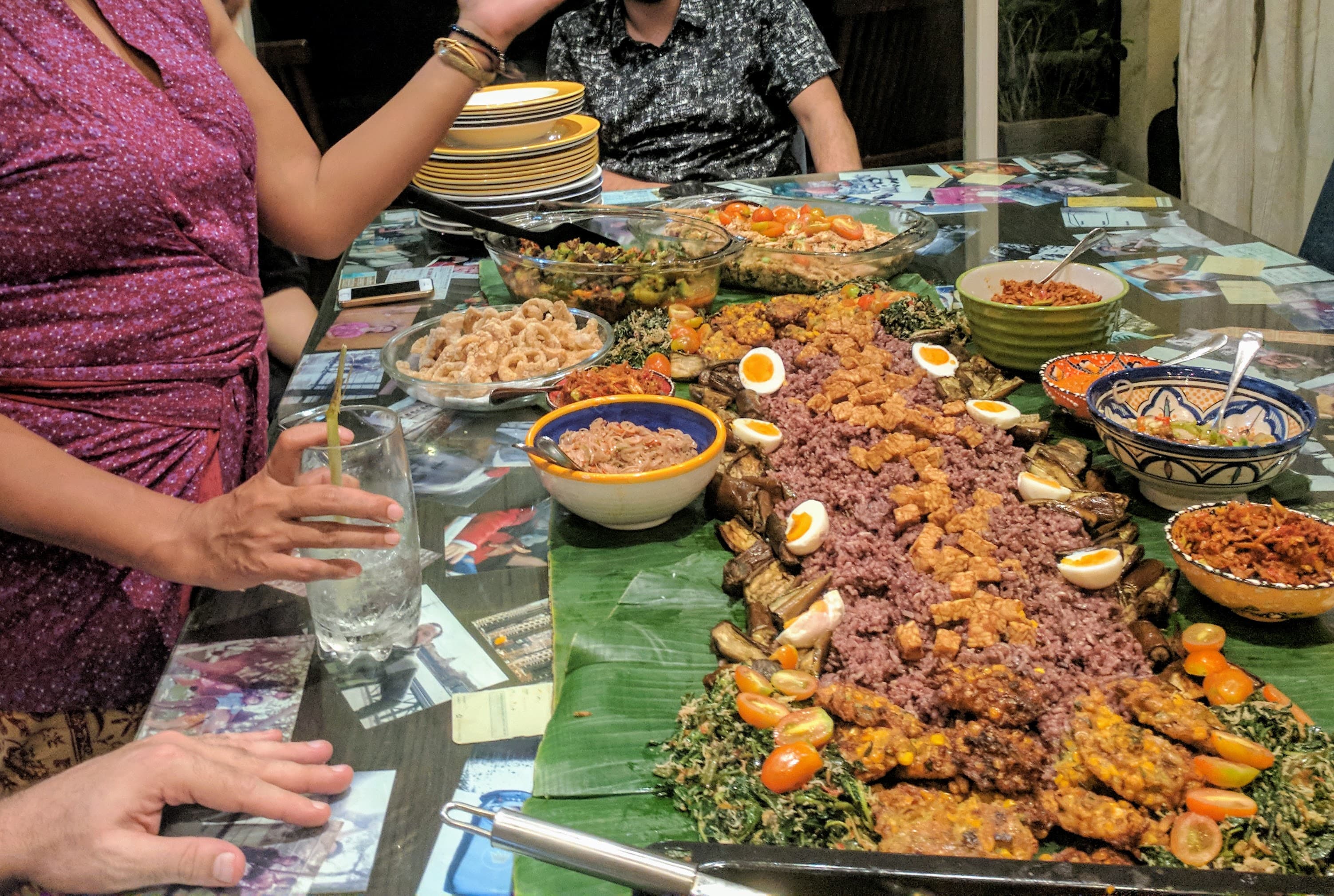
I have more thoughts on this from the resulting discussion. Most of it is about labor, ingredients, and food ways, but also, damn I miss that nasi and I miss those dinner parties.
March 12, 2024
Food is extremely subjective, and in Singapore it's a national pastime and passion. The following lists are based on my tastes. Other people may disagree, and you may want to do further research based on your own dietary preferences.
If you're from Singapore, resist the urge to tell me I missed your faves: I'm prioritizing picks that I think tourists will find more accessible. I don't expect anyone to travel to my corner of the woods to find the best of something.
(Or, get this list in one single Google Maps list)
Singapore Dishes you should try
#
- Laksa: Sungei Road Laksa, Janggut Laksa, Wei Yi Laksa (my absolute fave laksa but the lines are.. long. I waited 60-90 min the last few times I went, and they sell out before noon. definitely one of the most 'local' and 'old school' of the bunch. This is the laksa I grew up eating), 928 Yishun Laksa
- Chicken rice: 'what's the best chicken rice' is an explosive question in Singapore. Here are my my picks: Tian Tian (Bourdain's recommendation and has a line to show for it), Ah Tai (similar to Tian Tian, with a less long line, in the same building), Sin Kee (my fave Cantonese style chicken), Tong Kee (my fave roasted style chicken rice), Feng Ji
- Chwee kueh: a Teochew breakfast delicacy made of steamed rice cakes (different from idlis, they are more.. glutinous and starchy) served with a delightful turnip / chillies relish. I like mine at Bedok Chwee Kueh @ Chinatown Complex, Jian Bo Shui Kueh, Pek Kio Chwee Kueh. This is one of the more unique foods that I can't really get many other places
- Congee / porridge. Many, many styles of congee in Singapore. I like Zhen Zhen, Weng Kiang Kee, Ah Chiang, Imperial Treasure
- Nasi lemak (sometimes halal, sometimes not, depending on the stall you go to): Nasi Lemak Ayam Taliwang, Uptown (for Malaysian style nasi lemak, which I love), Dickson Nasi Lemak (take-away only), Mama Lemak, Pak Mandor, Owen Road Nasi Lemak
- Har jeong gai (fermented shrimp paste coated batter) and other distinct styles of fried chicken wings: Ah Tan Wings, Eng Kee, Ban Leong Wah Hoe, No 5 Emerald Hill (go here if you want booze in a bar in a hidden away spot behind busy Orchard Road, with gorgeous old world architecture. The wings are great. The drinks are middling (just have a bottled beer or something), there are better bars in Singapore but it's a unique spot for chicken wings, bottled beer and beautiful historic architecture
- A large 'zichar' meal. If you're familiar with the 'dai pai dong' in Hong Kong, zichar is the Singapore equivalent. I always like Kok Sen, JB Ah Meng (hot take: skip the chilli crabs that tourist blogs / videos tell you to go to, and come here instead. Get the white pepper crab, 'san lou' beehoon. It's cheaper and better), Wok Master, Maddie's Kitchen (where I always eat if I'm in the Orchard area), Zhenyi for vegetarian option. Every residential neighborhood will have its own good zichar but I think this list of spots will give you a good introduction to it
- Soy sauce chicken (hot take: skip the 'cheapest Michelin meal in the world' (very middling after their Michelin star expansion) and go to a better stall, Ma Li Ya chicken or Fragrant Soy Sauce chicken
- Indian rojak (rojak means 'mixed'. Kind of like a salad, but most things are fried and very tasty): Siraj, Habib's, Haji Johan
- Fishball noodles or minced pork noodles (very similar: dry noodles with soup on the side. Fishball noodles come with... fishballs. Minced pork noodles come with.. minced pork. Sometimes the lines are blurred): Soon Wah, Hock Lee, Ah Ter, Ah Huat Minced Meat Noodles, Liang Seng
- Char siu and other Chinese rotisserie: Roast Paradise, 88 Hong Kong, Fook Kin), Foong Kee
- Curry debal and other Eurasian food: Quentin's
- Henghwa food: Ming Chung, Xing Hua Family Restaurant (there's a chain called Pu Tian that you'll see in malls all over, it is pretty decent if you've never had this food, but these spots are better). Heng Hwa / Xing Hua food is food from Fujian, but coastal, and therefore a lot of seafood. I really like it and think it's one of the more unique cuisines you can get here
- Lor mee: Keng Heng Whampoa Lor Mee, 86 卤面 Lor Mee, Feng Zhen Lor Mee
- Braised duck rice and duck noodles or goose rice and noodles: Jin Ji, Tong Kee, Chuan Kee, Sean Kee
- Prawn noodles: River South Hoe Nam,Don Don Prawn Noodles, 545 Whampoa Prawn Noodles
- Yong tau foo: Xiu Ji, Yong Xiang
- Hainanese curry rice: Beo Crescent Curry Rice, Loo's Hainanese Curry Rice
- Mee rebus (halal): Afandi Hawa
- Mee soto (halal): HJ Waliti HJ Mazuki
- Mamak food especially mee goreng: Hajjah Jamillah Rajmohamed Muslim Food, Hassbawa, Kassim Stall
- Singapore-style Hokkien mee. Different from KL Hokkien mee. Singapore Hokkien mee is 'white' and not 'black'. also uses copious amounts of pork lard, but it's more 'broth'-based rather than 'dried' (although it isn't a soup). Hard to describe, but I love this stuff: Blue Star, Hong Heng, You Fu, Prince of Hokkien Mee
- Wanton Noodles: Ji Ji, Bei-Ing, Wei Min, Eng's, Ah Wing's
- Roti prata (halal): Prata Saga Sambal Berlada, Mr & Mrs Moghan, Sin Ming Roti Prata, any of the Springleaf Prata restaurants (various branches)
- Nasi Padang / Minang (halal): Putra Minang, Minang House, Pu3
- Vegan-friendly Hakka Thunder Tea rice: Hakka Thunder Tea Rice at Margaret Drive, Queen Street Thunder Tea Rice, The Thunder Tea Story, Traditional Hakka Rice
- Kaya toast and coffee: Heap Seng Leong (order the butter coffee too!), Tong Ah, Chin Mee Chin, Ah Seng (Hai Nam), YY Kafei Dian. In a pinch, Ya Kun and Killiney (all over the city) are good too but these places are more old school.
- Dimsum, like everything else, has 'street' and 'fancy' version and it's here where I truly believe that splurging for dimsum is a better experience than the 'street' version (usually made a factories. Have you seen how much work it takes to make dimsum?! Also we have some really good dimsum spots). My pick for dimsum is Peach Blossoms (call, make a booking for lunch; I believe it's on par with some of the best dimsum in HK) and Ji Xian
- Bebek goreng: if you can't make it to East Javan in Indonesia, bring East Java to you. Fried duck with lots of spices is a Surabaya / Madura specialty and one of my favorite dishes anywhere in the world. Thankfully, we have good ones in Singapore too (we also have a large Indonesian population) and my favorite is Pak Ndut.
- Really good coffee: even though I live in the land of Sightglass and Four Barrel coffee, Tiong Hoe (and coffee shops in Indonesia) is probably the coffee I miss the most
Greatest hits hawker centres to go to for generally great food
#
If the list is too overwhelming, literally go to any of these hawker centres and eat anything you find interesting. If there's a line, join it. Anything called 'market and food centre' is a hawker centre with an attached wet market (no wildlife. Just good fresh produce, fish, meat. Generally pretty clean).
- Old Airport Road Food Centre (breakfast, lunch and dinner, especially good for dinner)
- Maxwell Food Centre (breakfast, lunch, dinner and supper)
- Pek Kio market (breakfast, early lunch. Many stalls here are Teochew in origin, run by very old folks, closes very early)
- Haig Road (breakfast, lunch). Best option for halal food
- Tekka Centre (breakfast, lunch and dinner). The main hawker centre in Little India. One of my faves. Lots of halal options and regional Indian, even Sri Lankan, options. Chinese food at the back. Get freshly made prata. idiyappam, appams, good prawn noodles, and lots more. Wet market at the back is spectacular and is a chef's dream. There's a stall that only sells banana leaves. Another that only sells eggs. Follow the sound of smooth jazz music in the wet market and find yourself at Chia's, an excellent vegetable shop that chefs shop at
- Chinatown Complex (breakfast, lunch, dinner). I always say that this single building has more great Chinese food than San Francisco has Chinese restaurants. There are different versions of it, and it's massive. Come in the mornings for excellent mostly Chinese breakfasts. Try one of the last remaining handmade 'sachima' shops. Late night, claypot rice, craft beer. If you love seafood, very good, very affordable seafood in this section of this hawker centre in the evenings. Too many to name, but there are dozens like this clustered together around this stall.
- Bedok 85 (good for breakfast, lunch, dinner and supper. One of the most famous eating spots in the east of the city)
- Bukit Merah View (breakfast)
- East Coast Lagoon (good for supper, and 'on the way to and from the airport' meals as it's very close to the airport). Nice outdoor hawker centre that is probably the hawker centre to go to if you want a jovial, outdoor exotic hawker centre feel, especially if you've never been to one. Most of the stalls are quite good
- Tiong Bahru market (good for breakfast and lunch). Very popular foodie-ish hawker centre.
Best spots for vegetarians and vegans
#
- New Fut Kai for veg versions of things like laksa and other 'Chinese Singaporean' foods
- Whole Earth for a delightful veg version of Singaporean / Chinese / Thai / Malaysian food
- VeganBurg: Veganburg started right here! I love the vegan chilli crab burger
- Herbivore: really good Japanese veg food especially for veg yakitori
- Almost all Indian places in Little India will have vegetarian options, but especially Murugan Idli and Mavalli Tiffin Room and Gokul and Kailash Parbat
There's more I want to post on this topic, especially the great regional Indian, regional Chinese and other foods you can get in Singapore, but this is a good starter list just for food somewhat unique to Singapore (and Malaysia).
February 1, 2024
Whenever I can, I make the 45 minute walk to Chinatown in San Francisco to Dim Sum Bistro, my favorite 'cheap dimsum' spot. Sometimes, I take photos too.
I say this every chance I get: dimsum isn't always 'cheap' food. Dimsum can be fancy, and should be fancy, because to make large amounts of high quality dimsum you need a very large team. 'Nice dimsum' is a treat. It's a birthday meal, it's a treat you give your parents, it's going out to linger over nice tea and good ingredients to snack on dishes you probably won't make at home.
Cheap dimsum also has a place. But it should still be fresh and of relatively high quality. The menu should be large and the 'skin' of dumplings shouldn't be too thick. On these metrics, many of the other Chinatown dimsum places don't pass muster for me. But Dim Sum Bistro always delivers. So I'm glad it's here, and I'm glad I can have good, cheap dimsum.
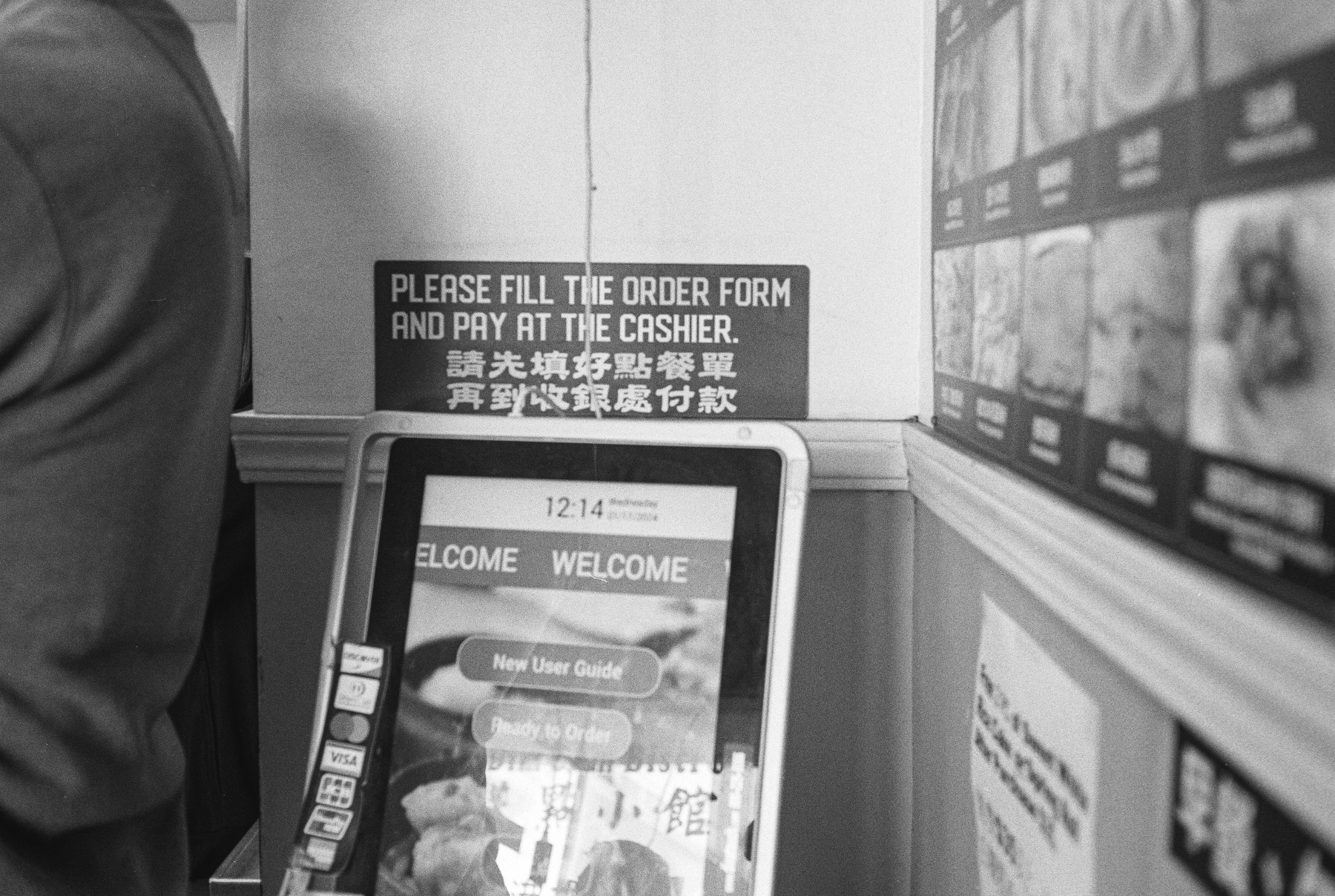
Dim Sum Bistro
675 Broadway (Map)
(Photo taken on Minolta Hi-Matic 7S II, Kodak T-Max 400, developed in Xtol stock for 12:15 min @ ISO 1600)
January 30, 2024
Lucas Sin shares how Cantonese chefs gauge water temp: shrimp eyes (80C), crab eyes (90C), fish eyes (99C about to go into a rolling boil). The video is also a good instructional resource on how to prepare and cook shrimp, especially Hangzhou style tea shrimp. Good recipe to come back to and try.
Hennepin County, Minneapolis has reduced its chronically homeless population by 80% in just five years via a combination of funding, deep community engagement and a housing-first approach that’s matched with real housing resources. Besides cutting chronic homelessness, Hennepin County has also managed to reduce its unsheltered population by 22% since 2019, while the country’s totals moved in the opposite direction.
October 23, 2023
When I'm back in Singapore it can be easy to fall into old habits: sleeping in till late, staying out late, doing all of those things I used to do. On my recent trips, I'm trying to remind myself that I've been away for so long my parents aren't getting younger. My parents' daily routine starts with: picking a different hawker centre every morning to eat at. I try to join them, if I can wake up (they leave extremely early).
Bukit Merah View is one of my mum's favourites. It's relatively low key and quiet, but has some heavy hitters. More importantly, there's a wanton noodle stall there run by one of our distant relatives (my mother's cousin..?). It's very simple, but always tasty. It was even recommended in Michelin Bib.
The nice thing about a hawker centre is that it's usually attached to a wet and dry market. After a leisurely breakfast I was able to wander over to the other side to pick up some essentials: like the Feng He Yuan first extract dark soy sauce. None of the dark soy sauces I get in the US compare, and it is absolutely essential for some of the traditional Hokkien and Teochew dishes that I try to cook abroad.
While I don't relish waking up at 6 in the morning when I'm on vacation, food, and family is worth it: and in this part of the world, food and family is one and the same.
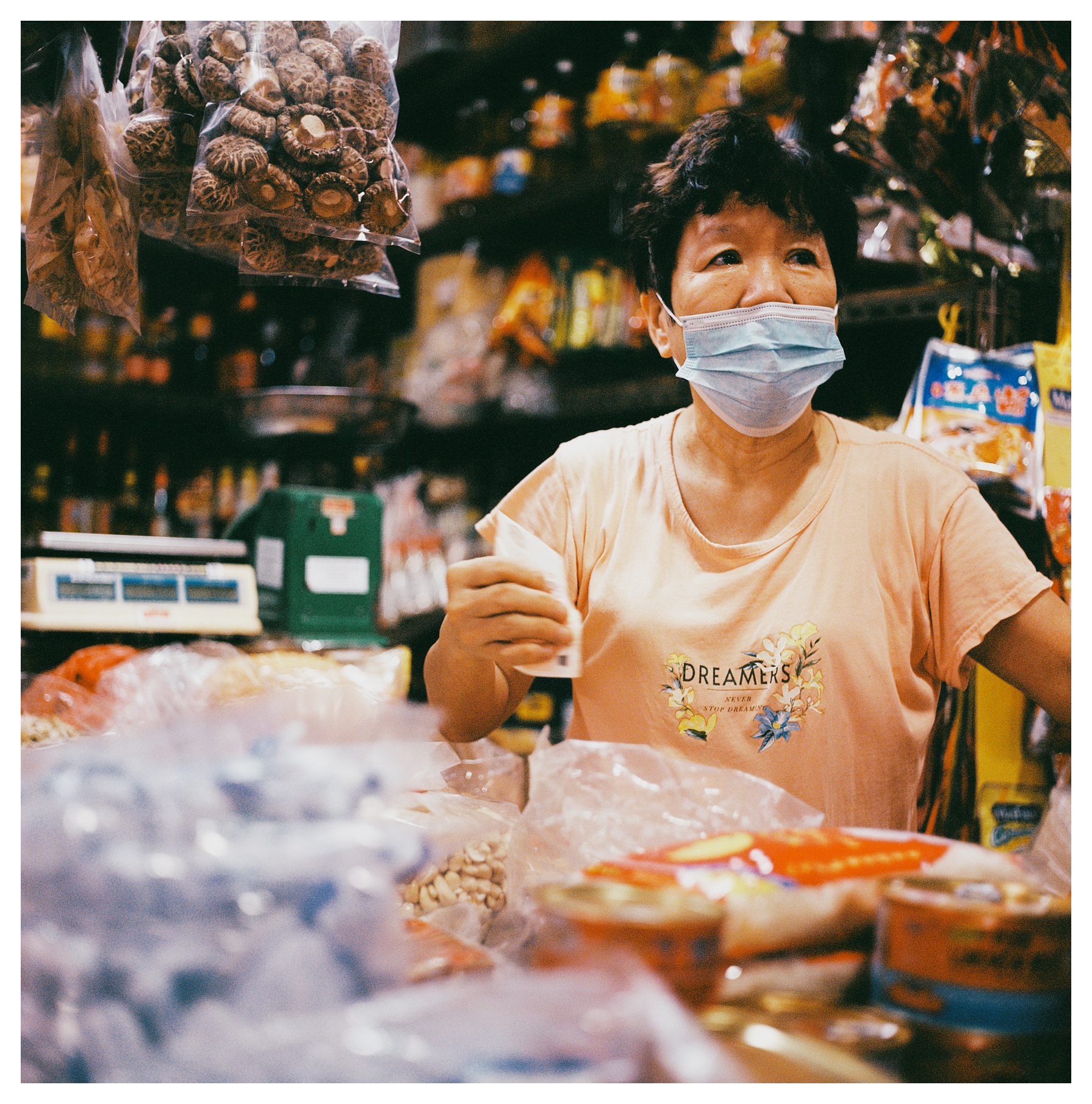
Purveyor of soy sauces, chilli pastes and dried goods in Bukit Merah View market.
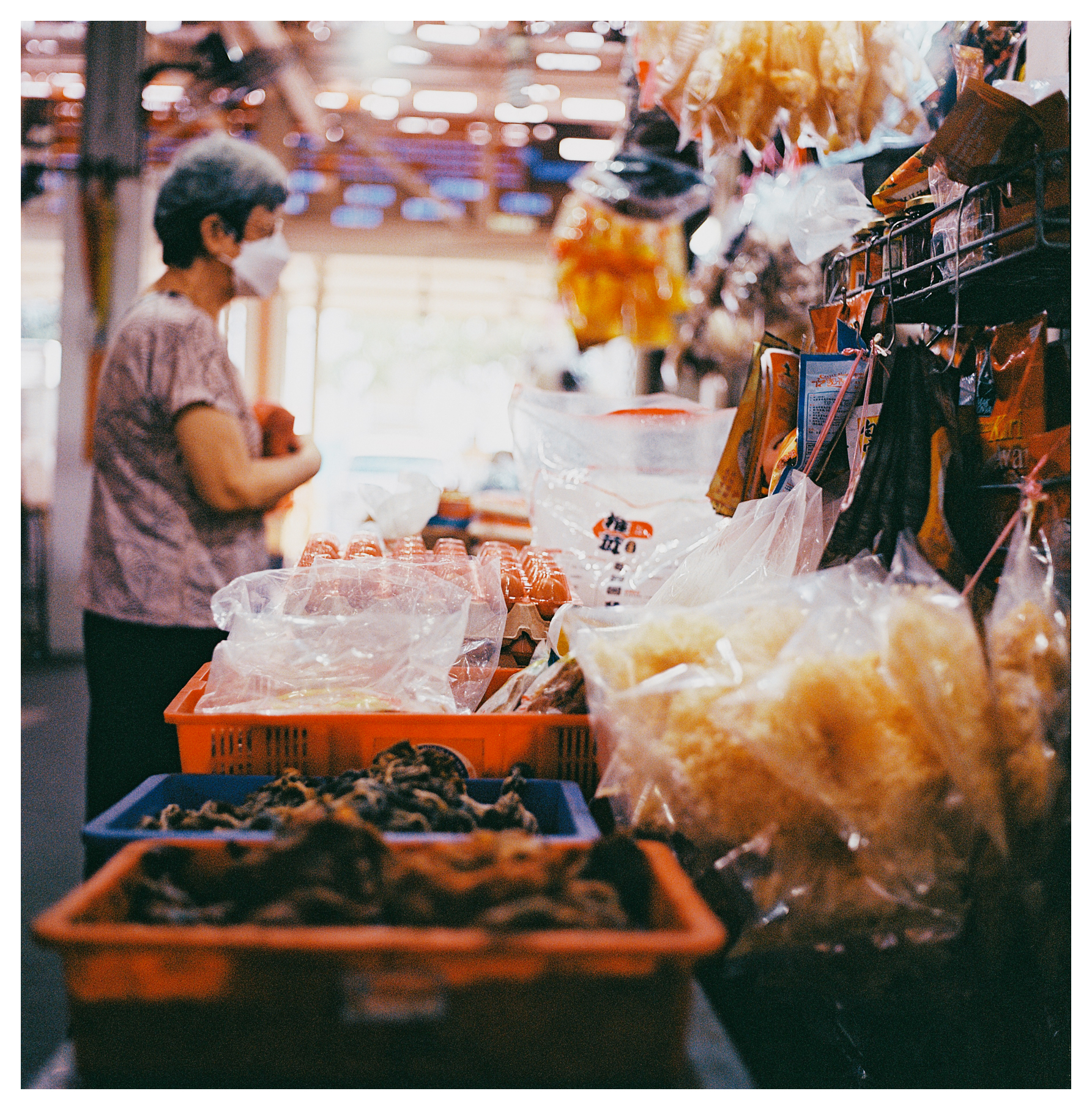
Carrying a retro TLR camera around my neck was fun. Many older people in Singapore looked at it, wide-eyed, and told me that they used to love their Seagull or Yashica cameras too.
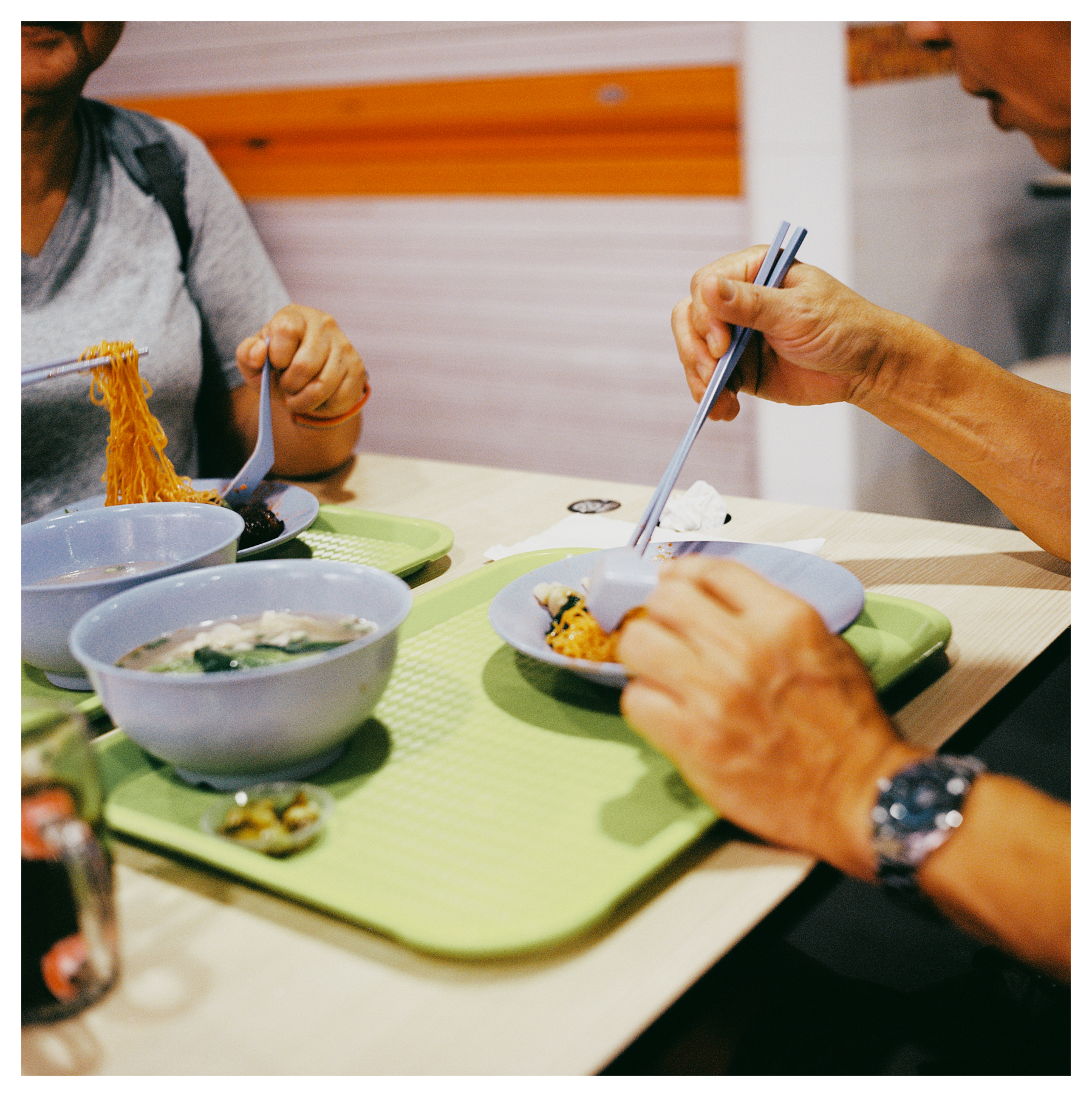
Breakfast with my parents.
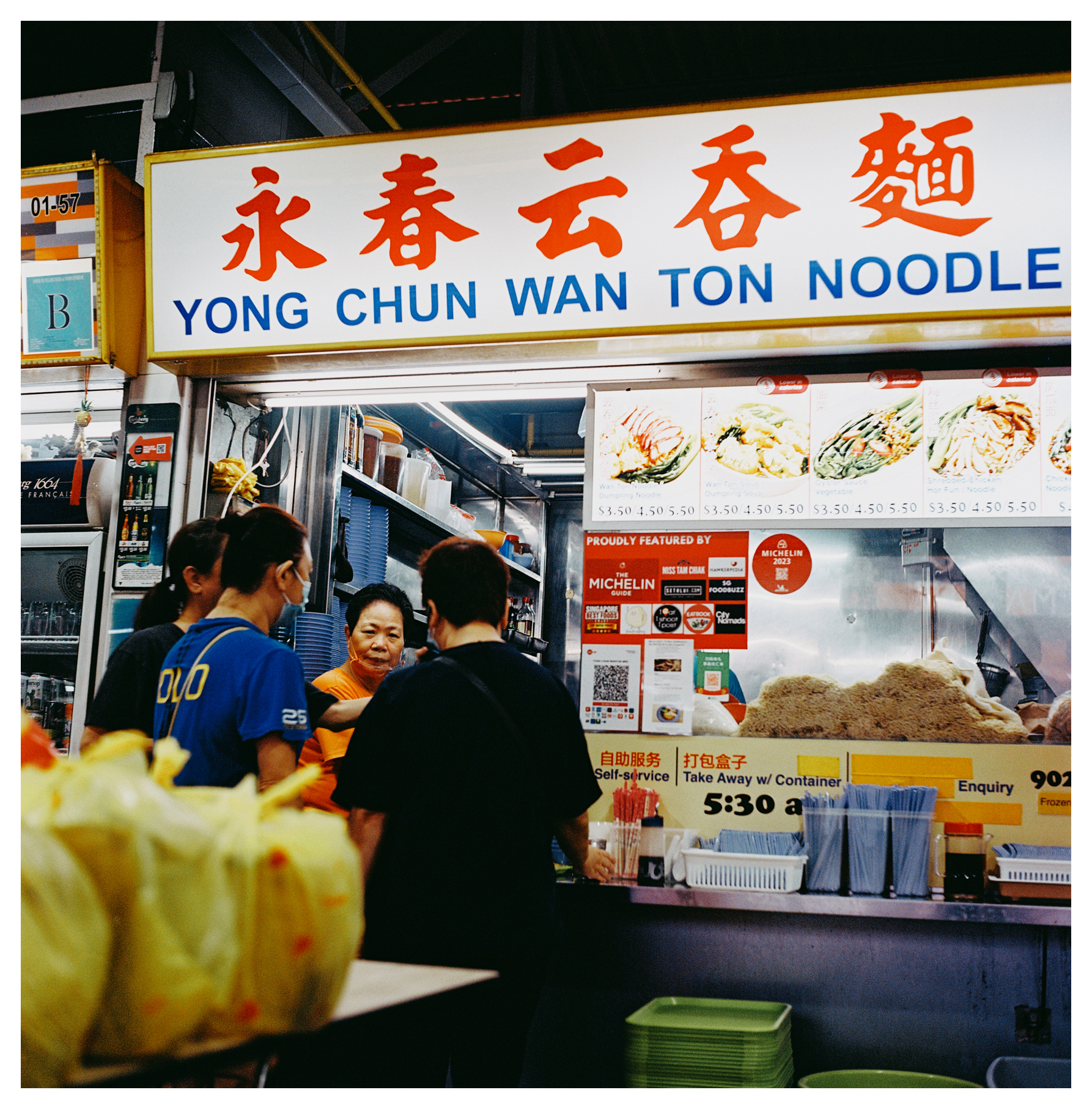
My distant relatives' simple, but very good, wanton noodles. If you're expecting KL style lardy savory wanton noodles, you will be disappointed: this is a basic Cantonese Singaporean style plain wanton noodles with bouncy noodles and good, basic ingredients.
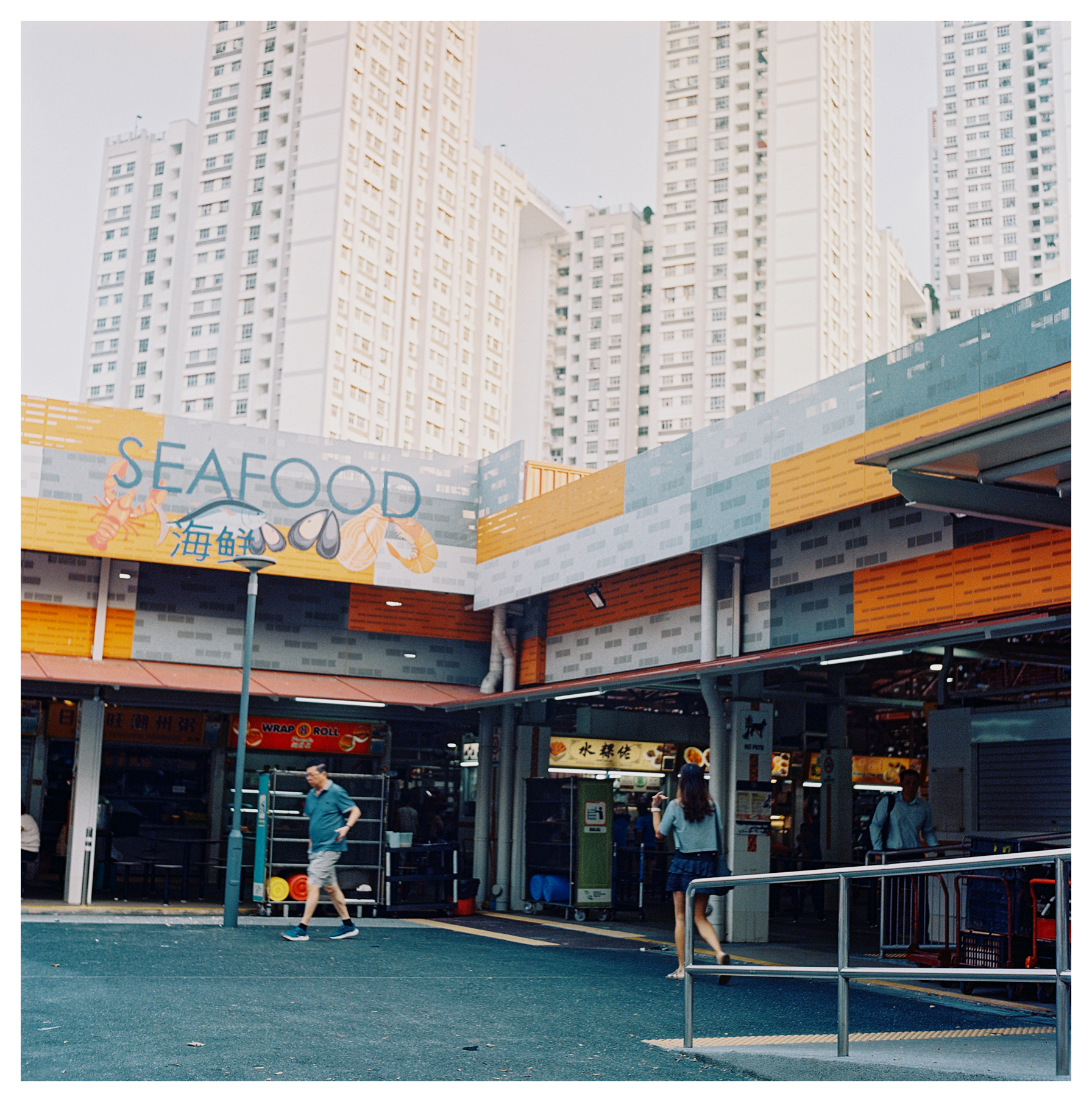
View of the wet market in Singapore with tall public housing behind it.
(All photos taken on Yashica Mat 124G, Portra 400, self-dev in Bellini C-41 kit, scanned on Fuji Frontier)
September 29, 2023
Of all of the neighbourhoods in Singapore, I've probably spent the most time in Little India. Not only was I born in a hospital on its edges, I also lived and studied near here for several years. Every trip abroad had to start with a visit to Little India, for foreign currency, electrical adapters, or extra supplies at Mustafa Centre.
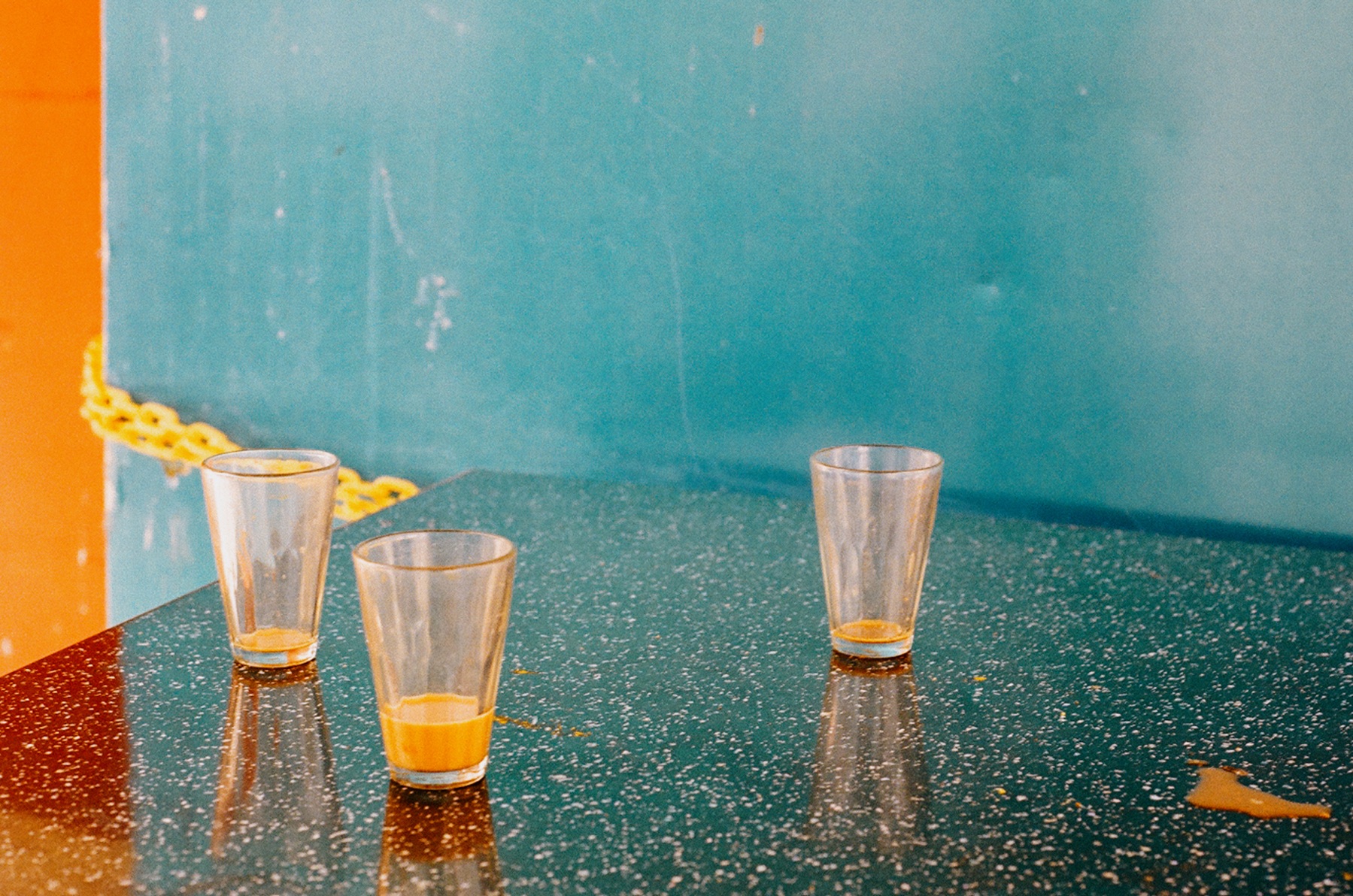
Filter coffee.
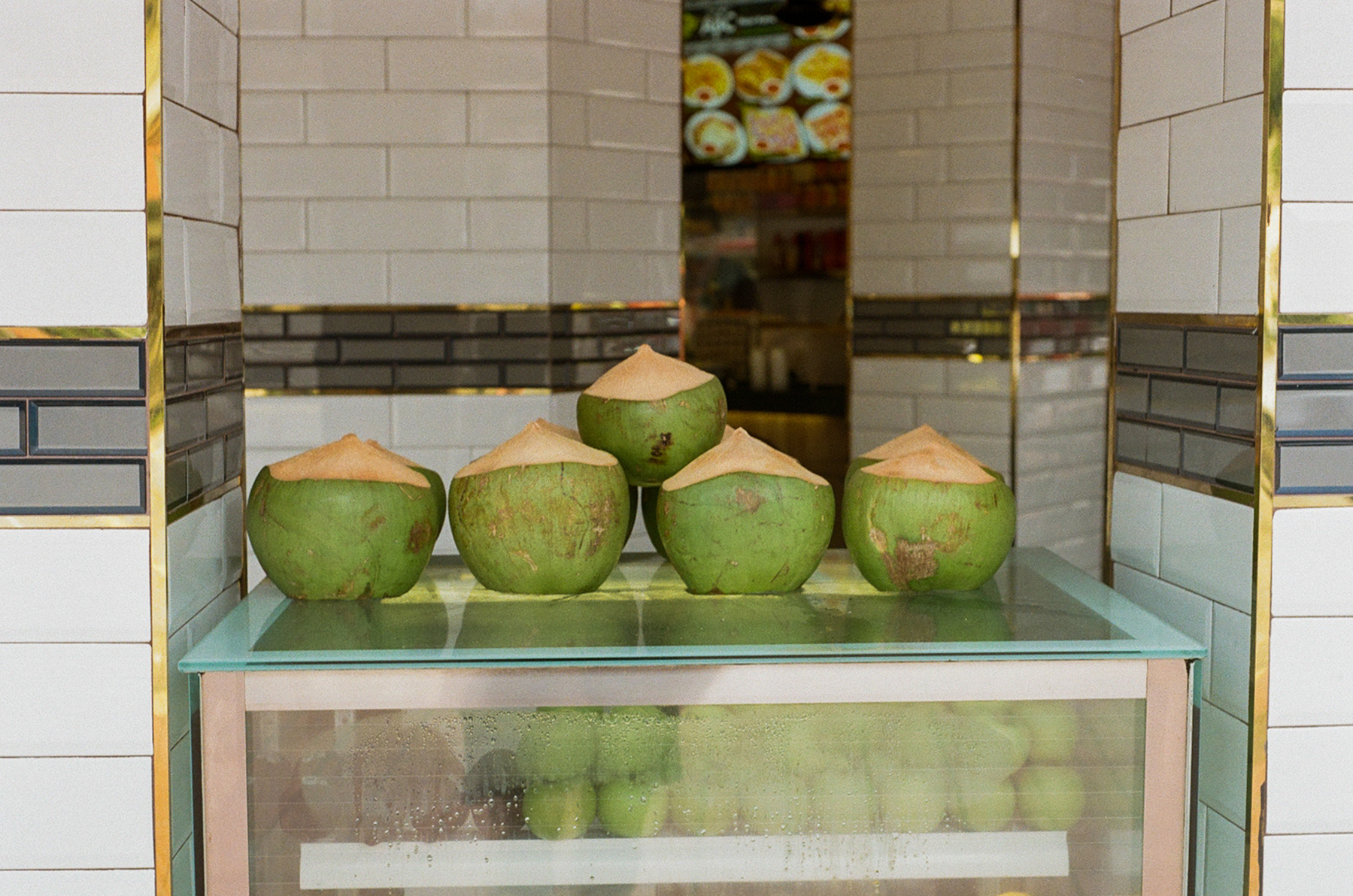
Coconuts.
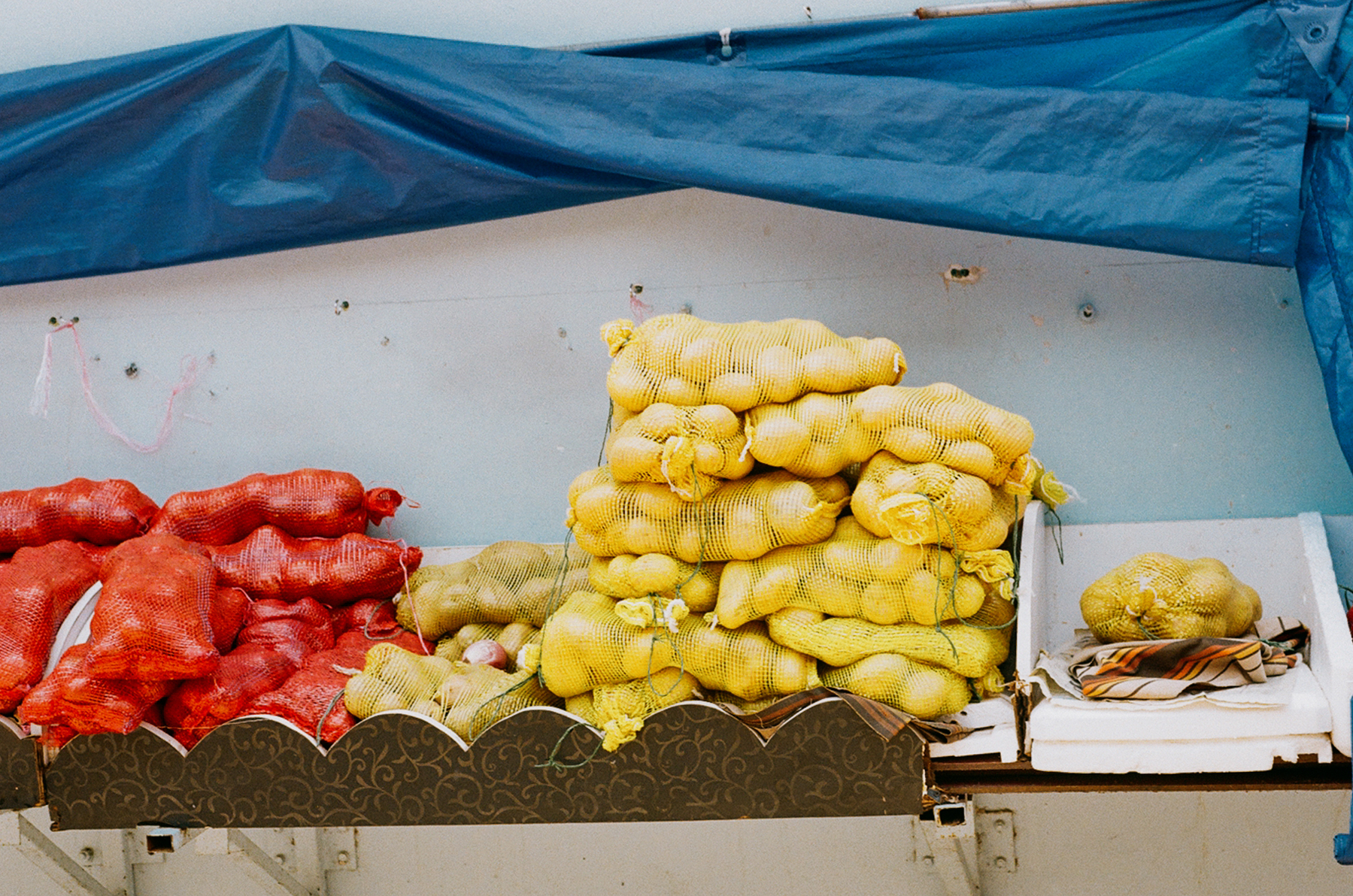
Aloo pyaz.
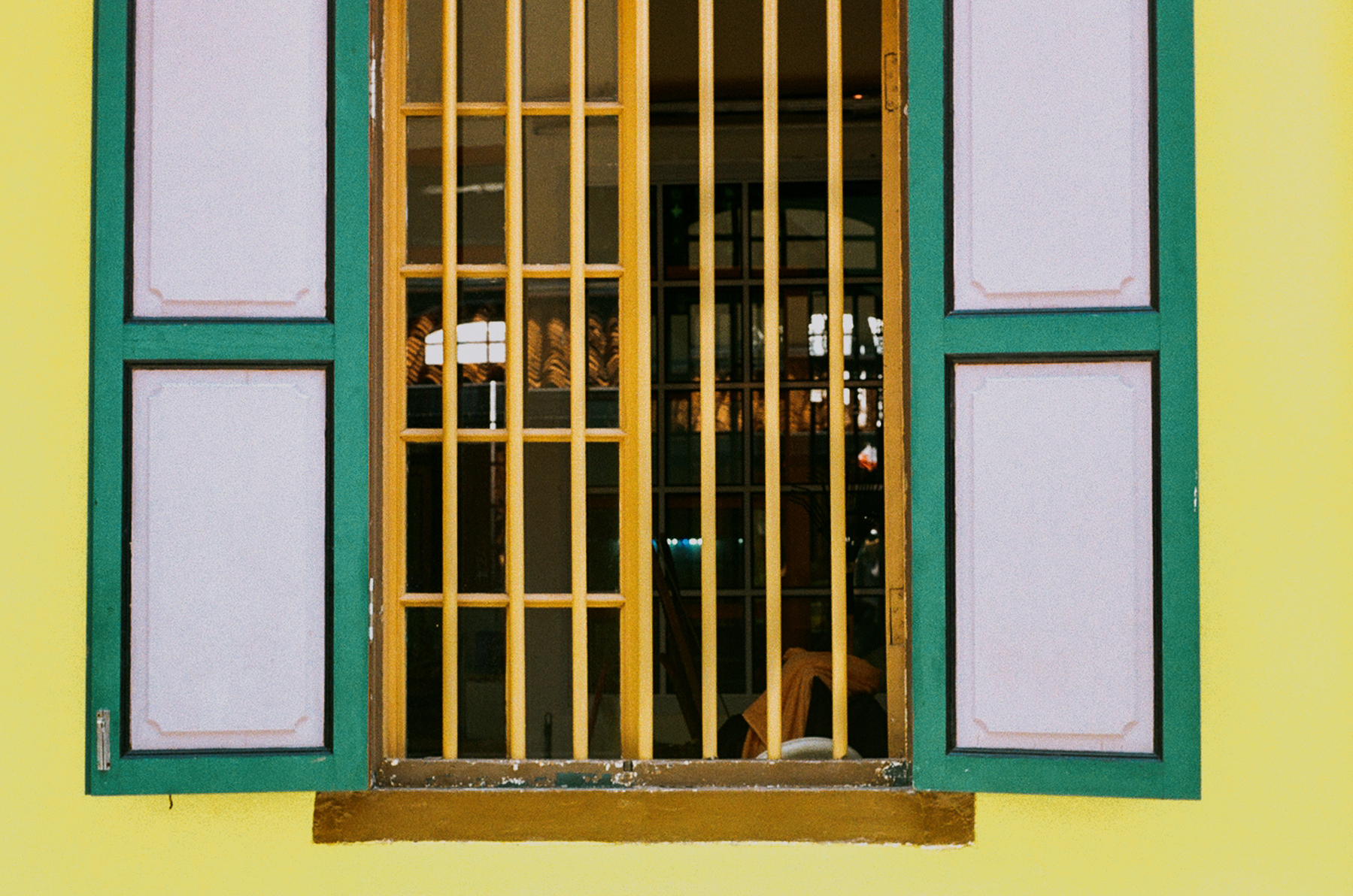
Windows.
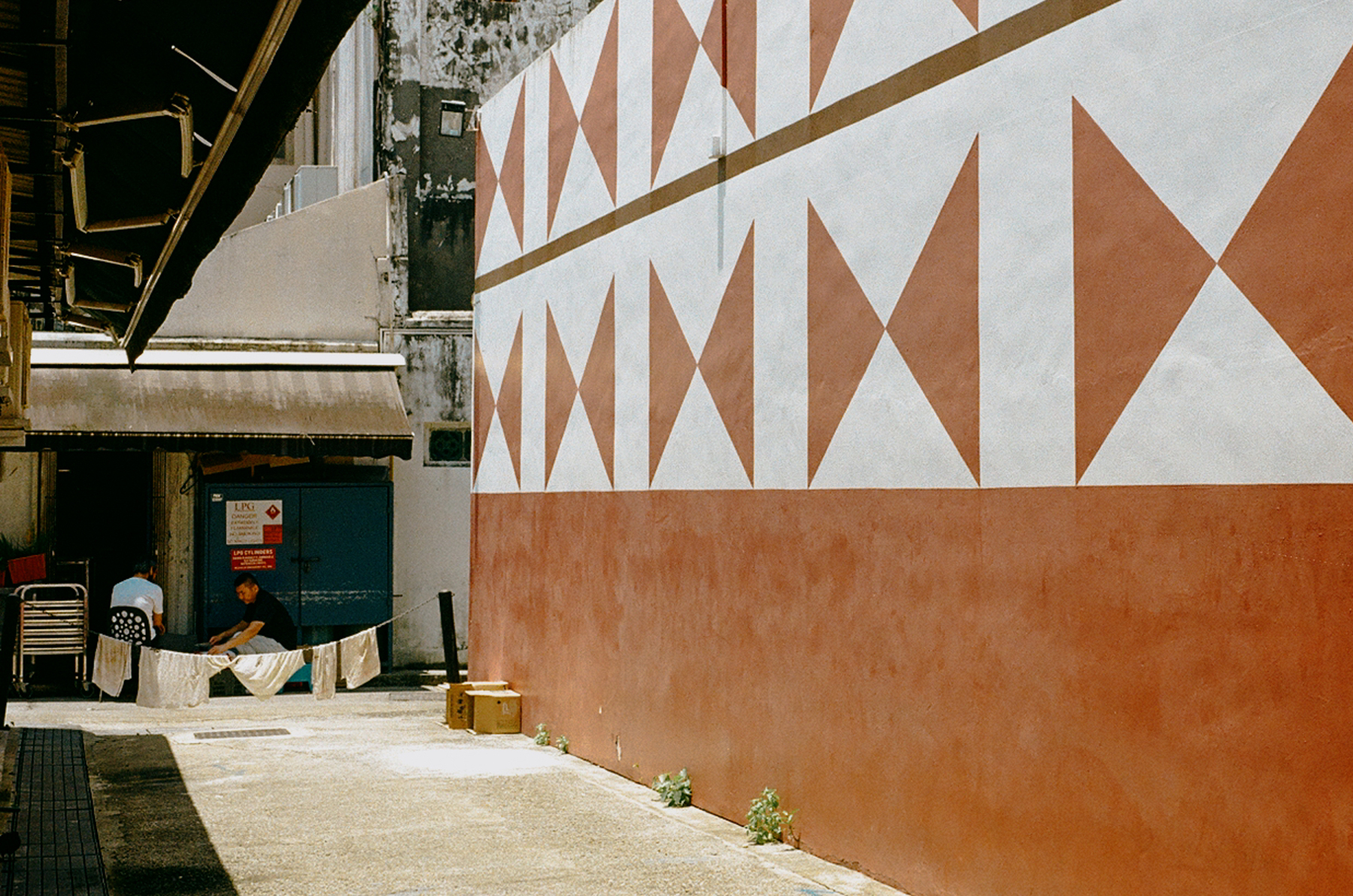
Alleys.
All photos taken on Nikon FE, 50mm, Kodak ProImage, dev and scan by Triple D Minilab, Singapore.
September 26, 2023
My favorite cup of coffee at Tiong Hoe, S$5
#
I start the morning at Tiong Hoe Coffee, one of my favorite coffee spots anywhere.
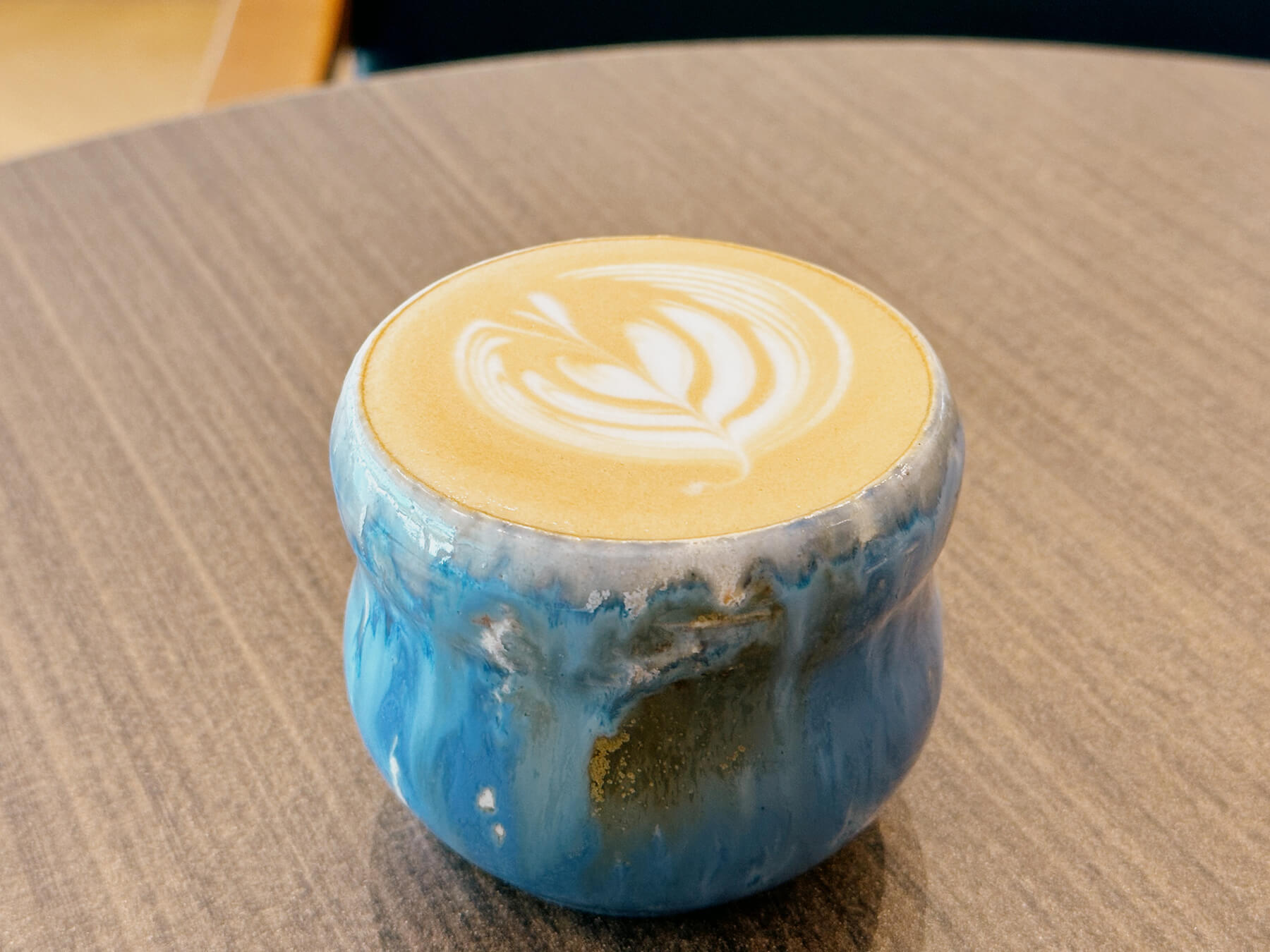
Tiong Hoe was set up decades ago by Mr Tan Tiong Hoe, who started as an apprentice in a Dutch coffee company in 1960. Today, the cafe is run by another group of younger folks, but you can still see Mr Tan in the cafe drinking coffee and talking to people.
Their house blend "Gachala" is an all time favorite espresso blend. It actually tastes better than many single origins I've had elsewhere. They also tend to have a wide range of coffee beans from all around the world. Unlike many San Francisco roasters which, I find tend to lean way too sour (just like the damned bread in that city), Tiong Hoe's coffees are balanced. Fruity when they have to be, smoky or heavy at other times, but always with interesting notes (the "Gachala" house blend has 'gula melaka' flavors!).
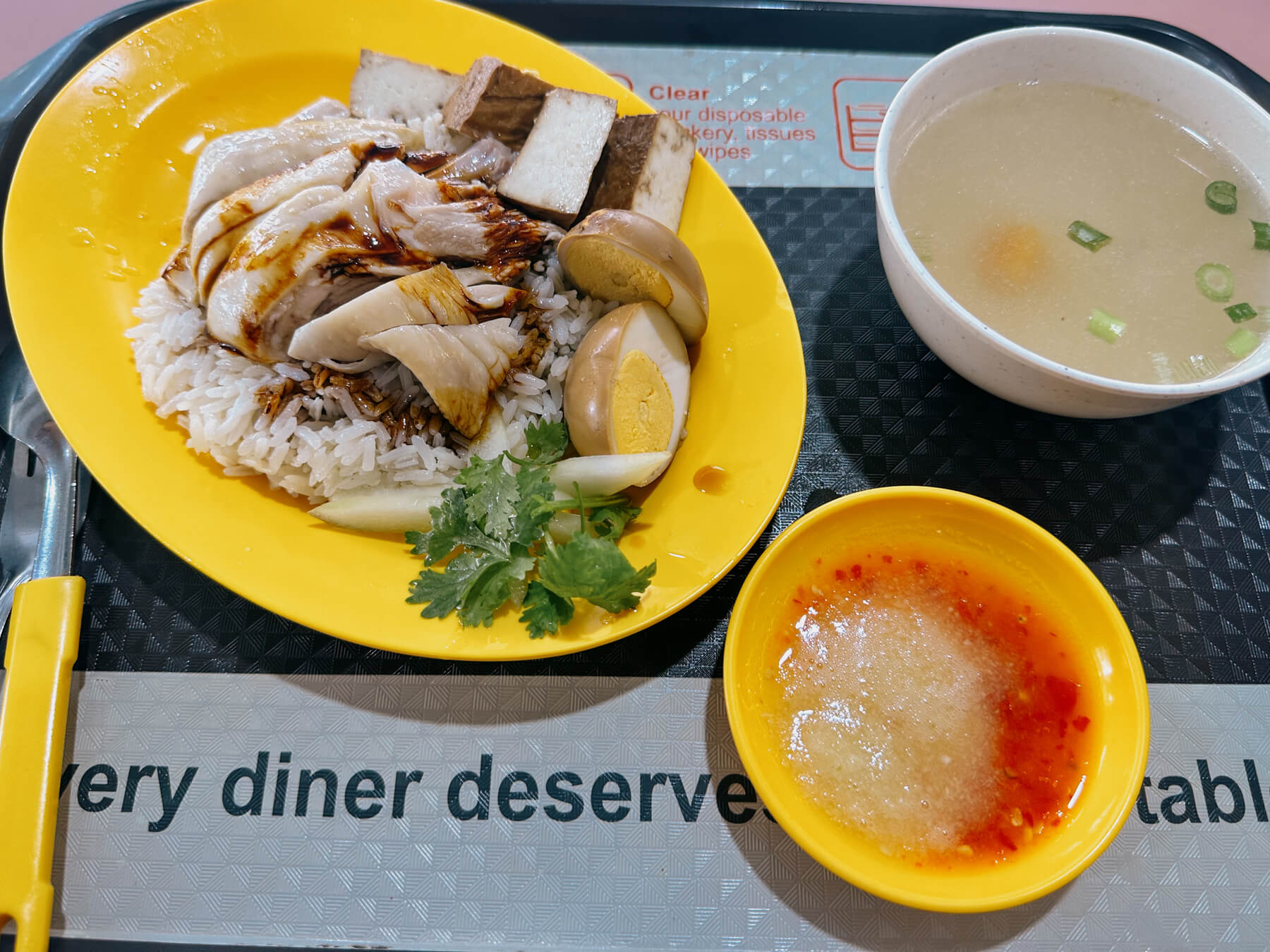
My favorite 'white' chicken rice
There is no such thing as the best chicken rice.
There's only the best chicken rice, for tourists who have never had it and who would like to stand in a line (Tian Tian).
The best chicken rice, for people who like dark style chicken with caramelized eggs (Tong Kee).
The best chicken rice that is not Tian Tian, but is in the same building and that has shorter lines and is similar in flavor (Ah Tai). Then there's the best chicken rice in the north, in Katong, best after-clubbing chicken rice, best in the east.
For me, I prefer Cantonese-style chicken rice and I tend to not venture far from the south / west / central parts of the country. So Sin Kee is my spot for 'white' chicken rice, and Tong Kee for 'black' chicken rice. I don't claim them to be my best, they're just my spots.
If you've never had chicken rice like this before, don't make the mistake of thinking they're just plain, boiled chicken. Cantonese and Hainanese people do 'white chicken' in very skillful ways. They use specific types of chicken, different from the kinds we'd get in western supermarkets. They have a technique of blanching, steaming or boiling the chicken that I find difficult to replicate at home. It's definitely more than just boiled chicken. It's the flavor of home, for me.
Blue pea flower ice cream at Birds of Paradise, S$6.80
#
After walking through the city on a hot day (haha, that's every single day!), I am craving for ice cream. There's a significant craft ice cream scene in the city. It's one of the things I love about it. But today, I am closest to Birds of Paradise, whose Craig Road location actually used to be the space of a well known agile software development web shop (Pivotal), so I feel like it's my worlds colliding. Ice cream and software are the two main things I live for.
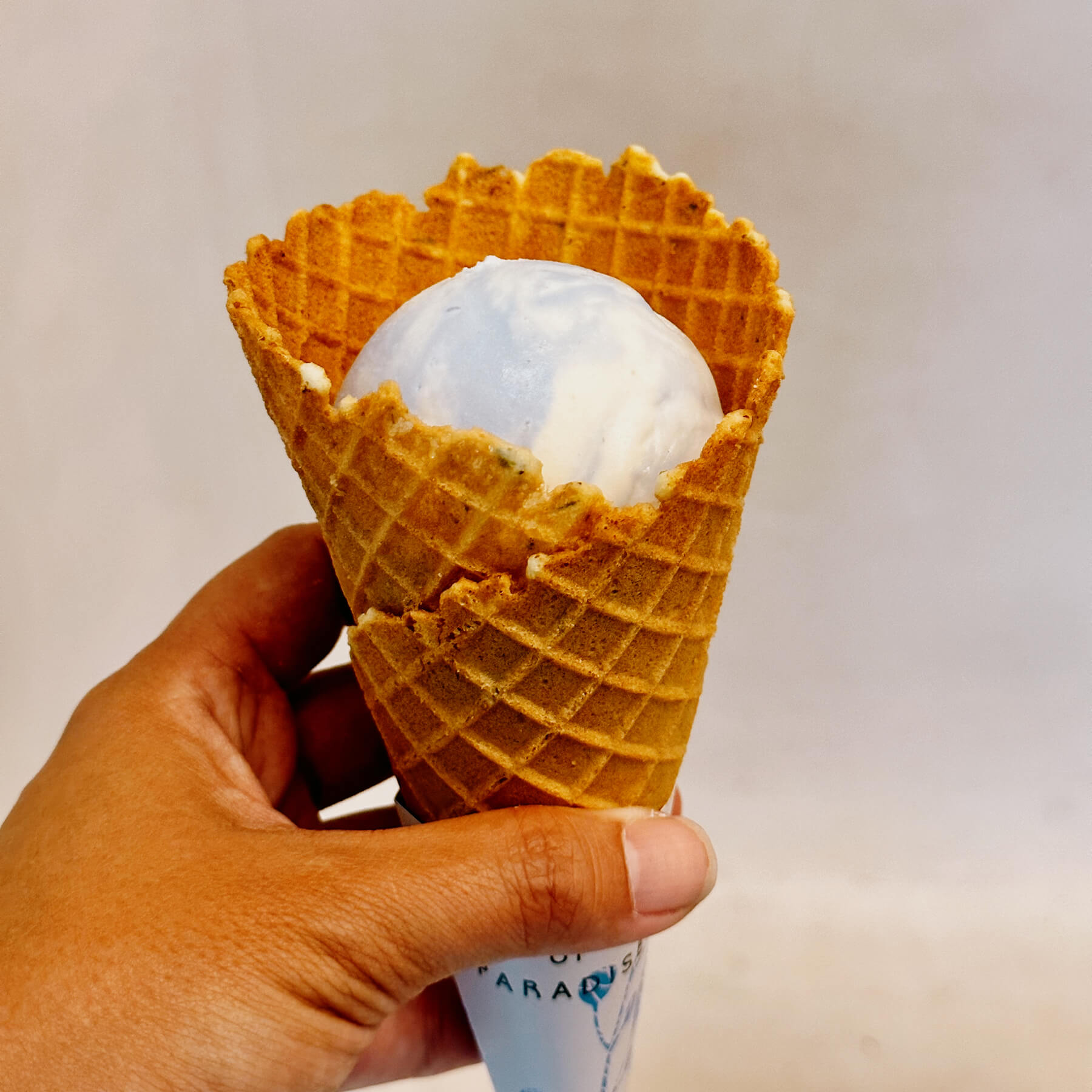
Macadamia blue pea flower ice cream with thyme-infused cone
I'm a sucker for blue pea flowers. I love them in drinks, in dessert, in everything really. I love them most of all in ice cream. In Tanjong Pagar alone, there are at least two places for bougie blue pea flower ice cream. Birds of Paradise, and Apiary. I'm a fan of both. And that's not even a fraction of all the good ice cream spots we've got.
Mazesoba at Kajiken, S$14.80
#
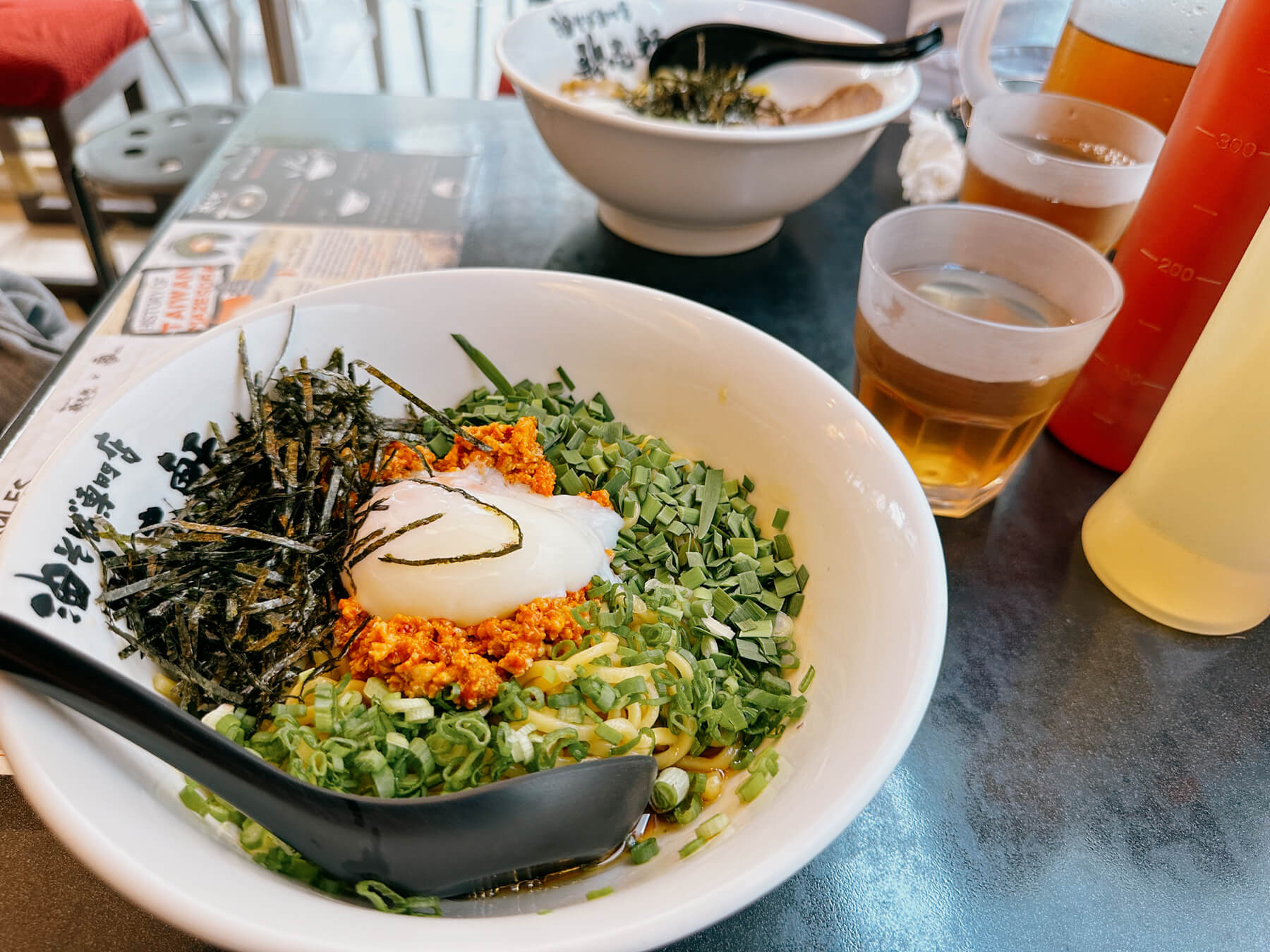
Japanese 'Taiwan mazesoba'
While I like ramen, I love mazesoba. I think it's the perfect blend of supple noodles, tasty condiments and ingredients. It's a mix of Japanese and Chinese noodles for me. This style originates from Nagoya, Japan, which confusingly calls it a 'Taiwan mazesoba'. I like the one at Kajiken. There's a Kajiken in San Mateo now, which makes me happy.
All in, I got to check off a lot of things on my 'places I always go to'. I'm happy!
September 23, 2023
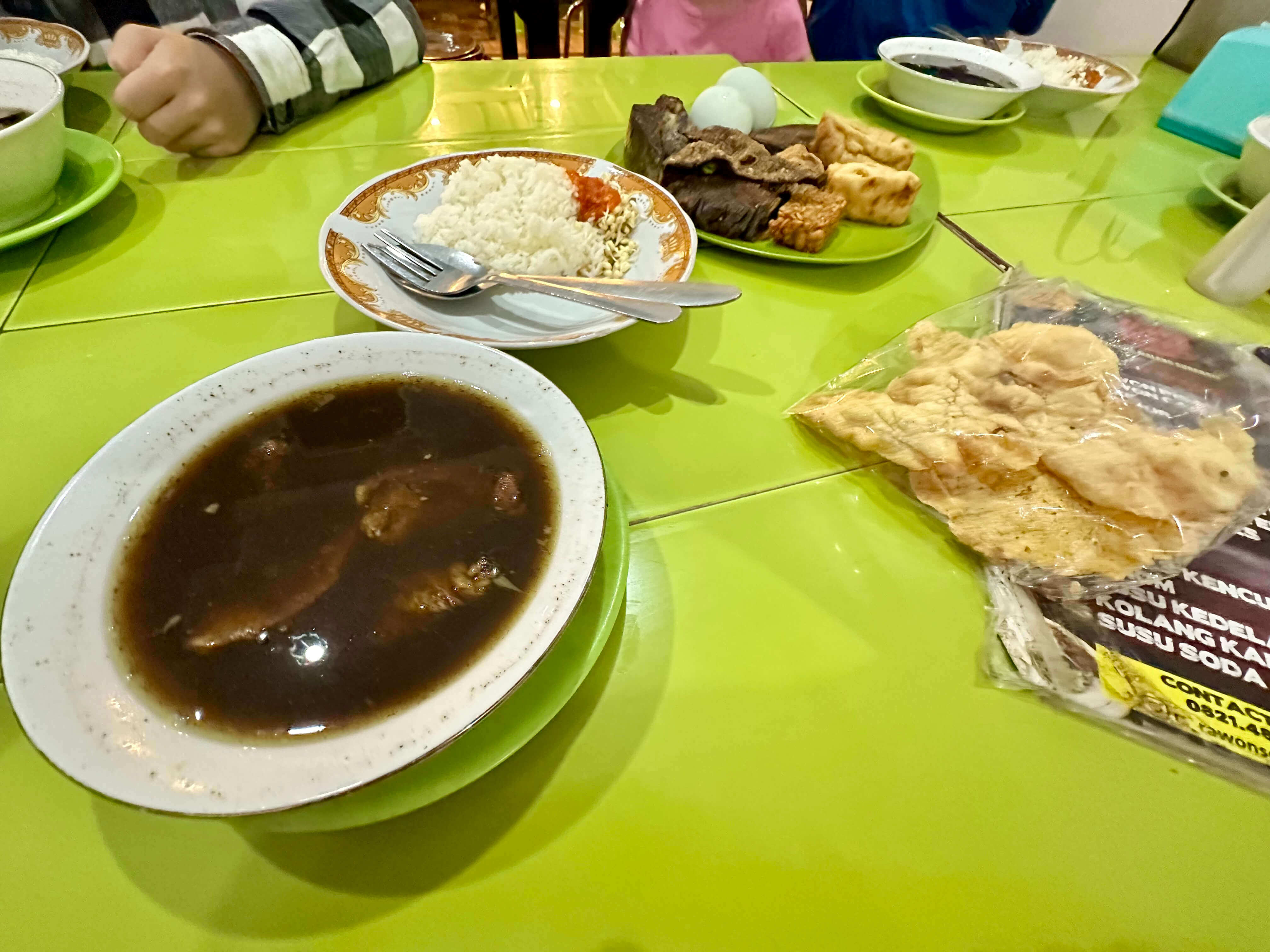
Rawon Setan, Surabaya
My all time favorite Indonesian food is nasi rawon.
I love it so much I will order it every time I see it. Surabaya, Malang and other East Java cities, tend to make the versions I love the most.
This spot has delicious rawon. Beefy, but light, with the spices and flavors of the keluak nut. Since I haven’t found a source for keluak in the US, I don’t make this at all. In a pinch, the Bamboe brand of premade spices (available at Richmond New May Wah in San Francisco) has a good rawon packet, but it’s obviously not as great as having it here. Still, I’d rather have rawon from a pack when I’m in California, than none at all.
I’ve also noticed that most of the Indonesian restaurants in NorCal where I live tend to be western Javanese or Balinese, or really some pan-Javanese / Asian flavors that are much, much lighter than the intensely savory Eastern Javanese food that I prefer.
So I am over the moon to be back in Surabaya, having the dishes and flavors that feel just right.
P.S. Apparently, if a restaurant in Java has ‘Setan’ in the name it means it is open late. Because obviously only devils stay out late (that’s what parents would call kids who stay out too late).
Rawon Setan
No 78/I, Jl. Embong Malang
Surabaya
(Map)
September 22, 2023
Sept 22, 2023
It was my first full day back in Singapore. Here's what I ate, and where.
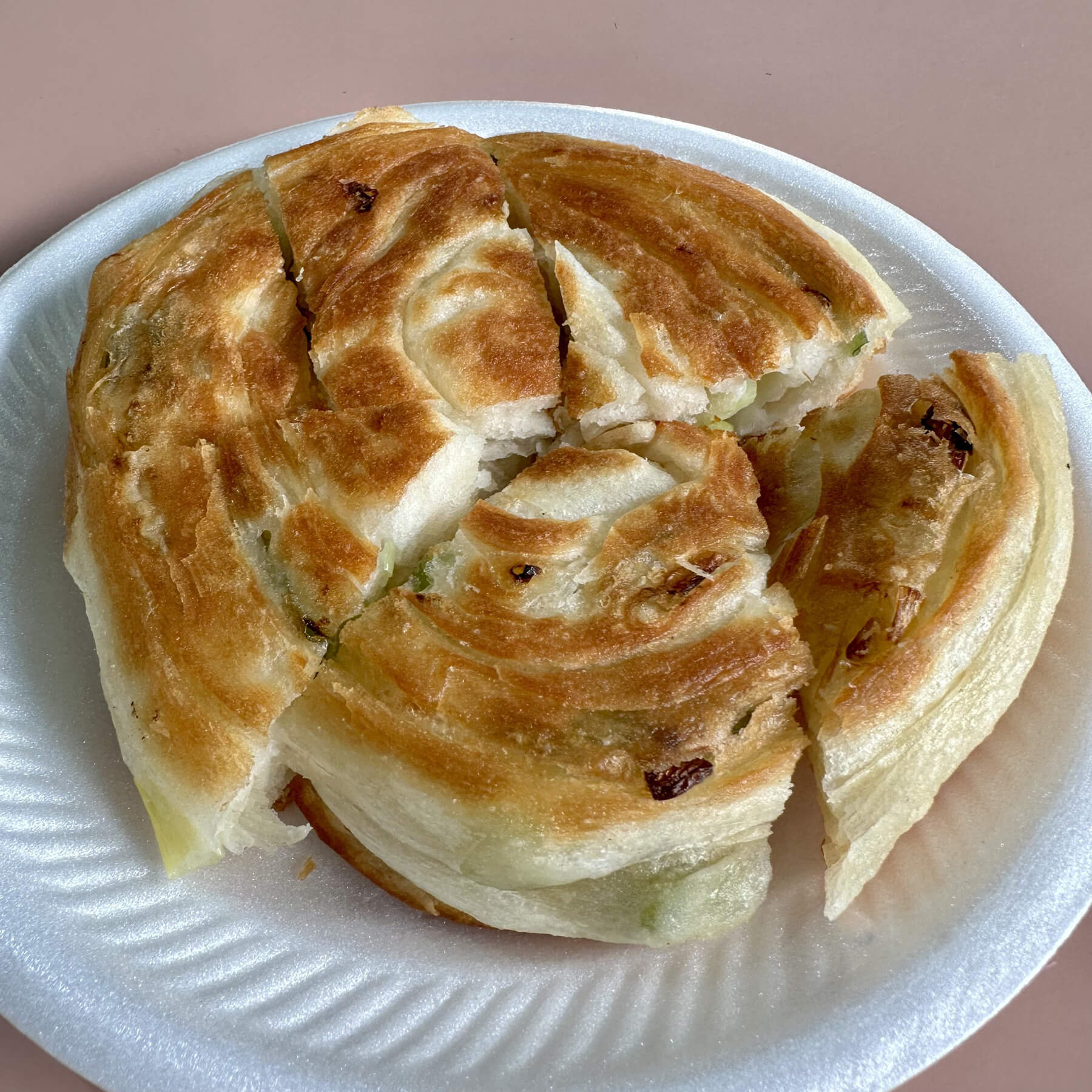
Excellent scallion pancakes and fried dumplings from 喬記面館
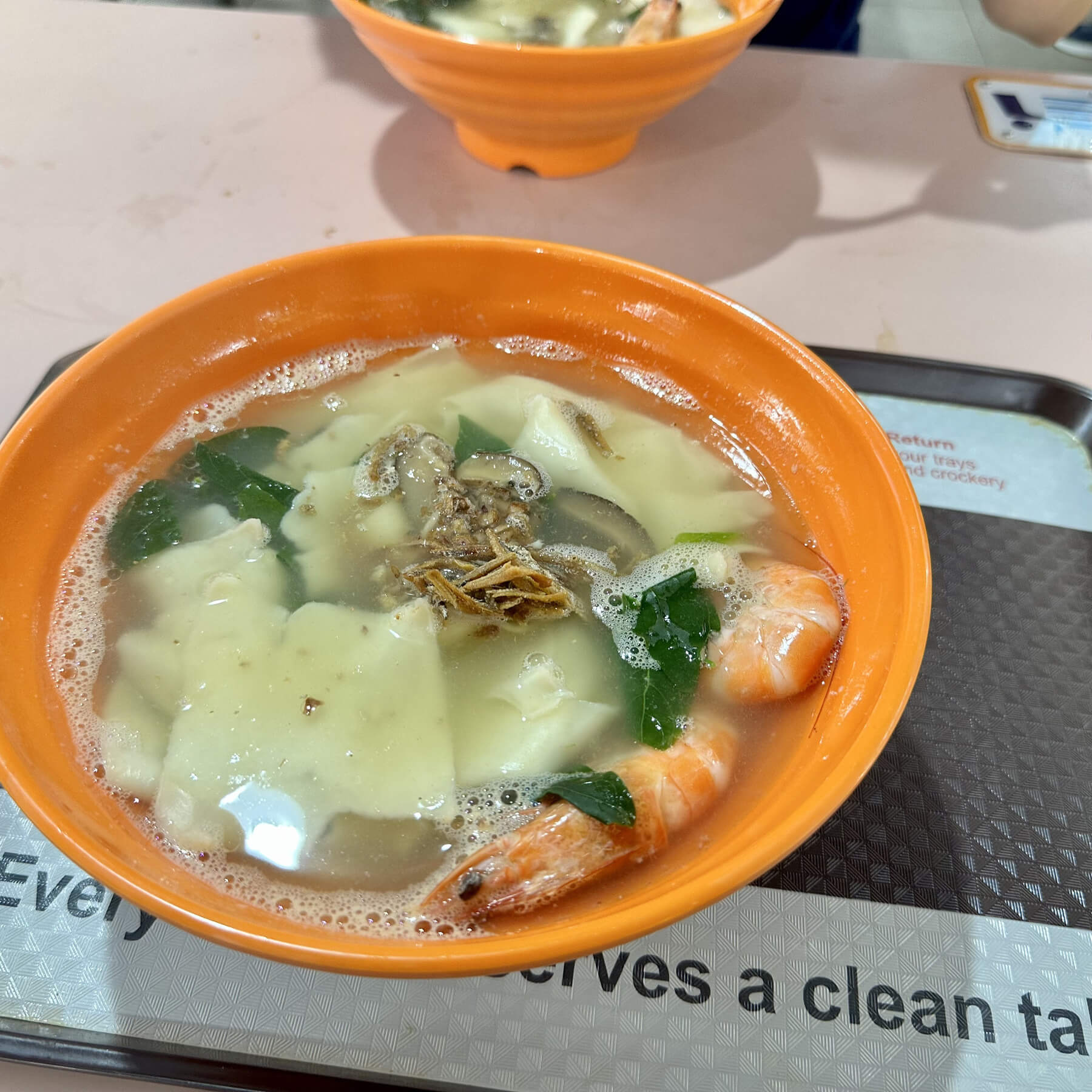
Mee hoon kuay from China Whampoa Homemade Noodles
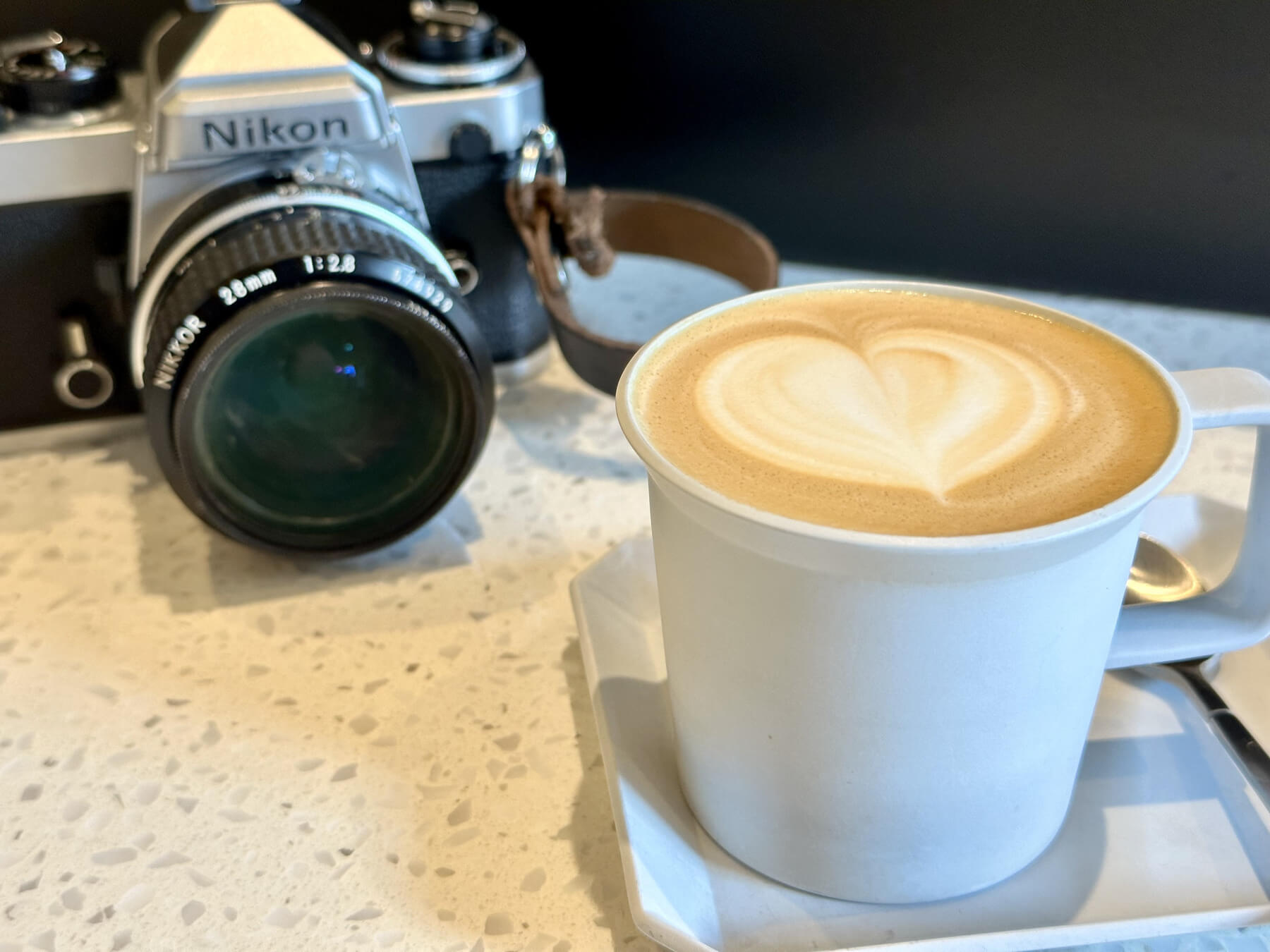
Excellent coffee at Kurasu. Today, they had a coffee bean from Yunnan. I had to try that since I’ve never tried Chinese espresso beans before. Very fruity!
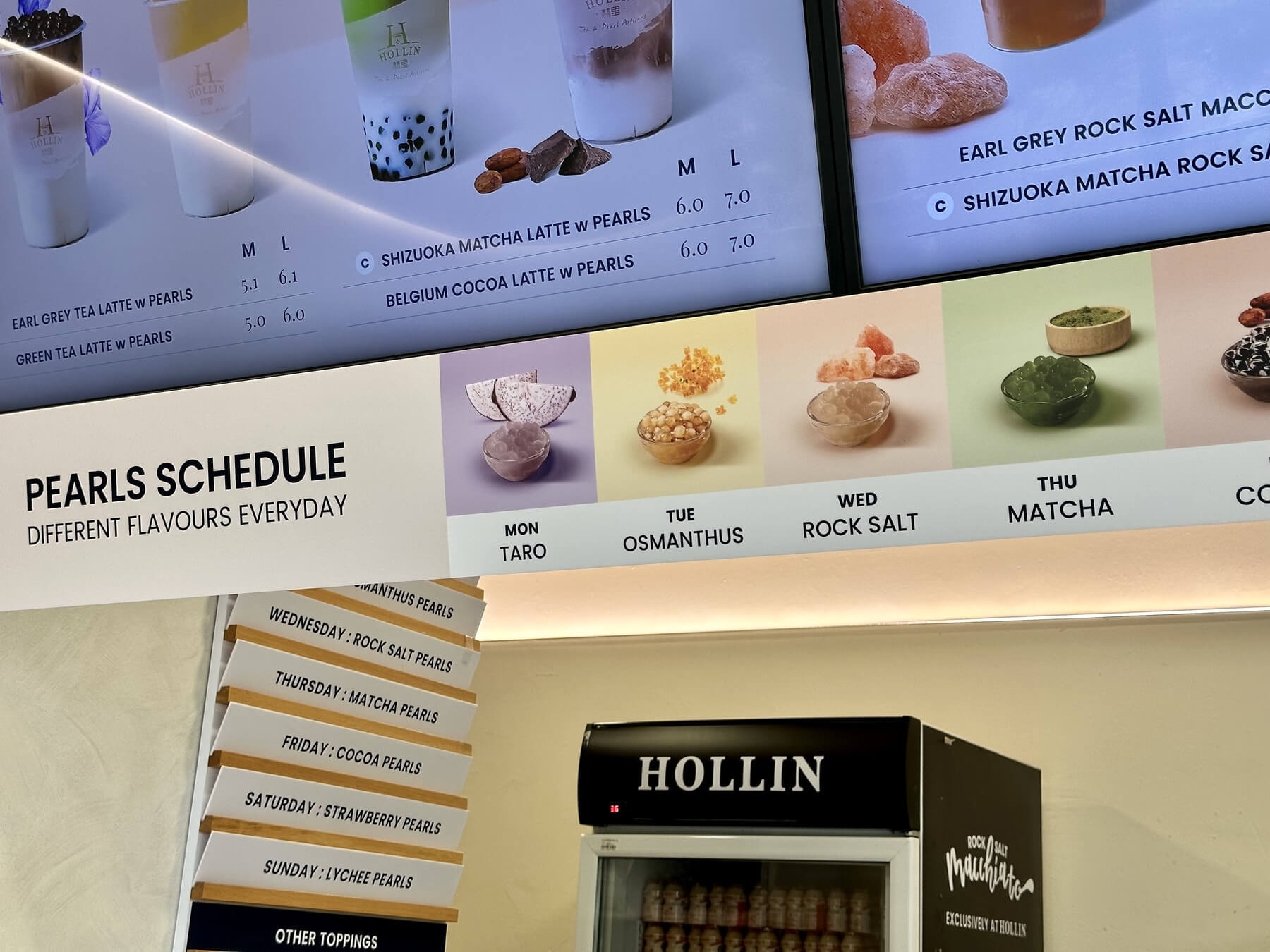
Rock salt macchiato oolong bubble tea with daily special pearls at Hollin
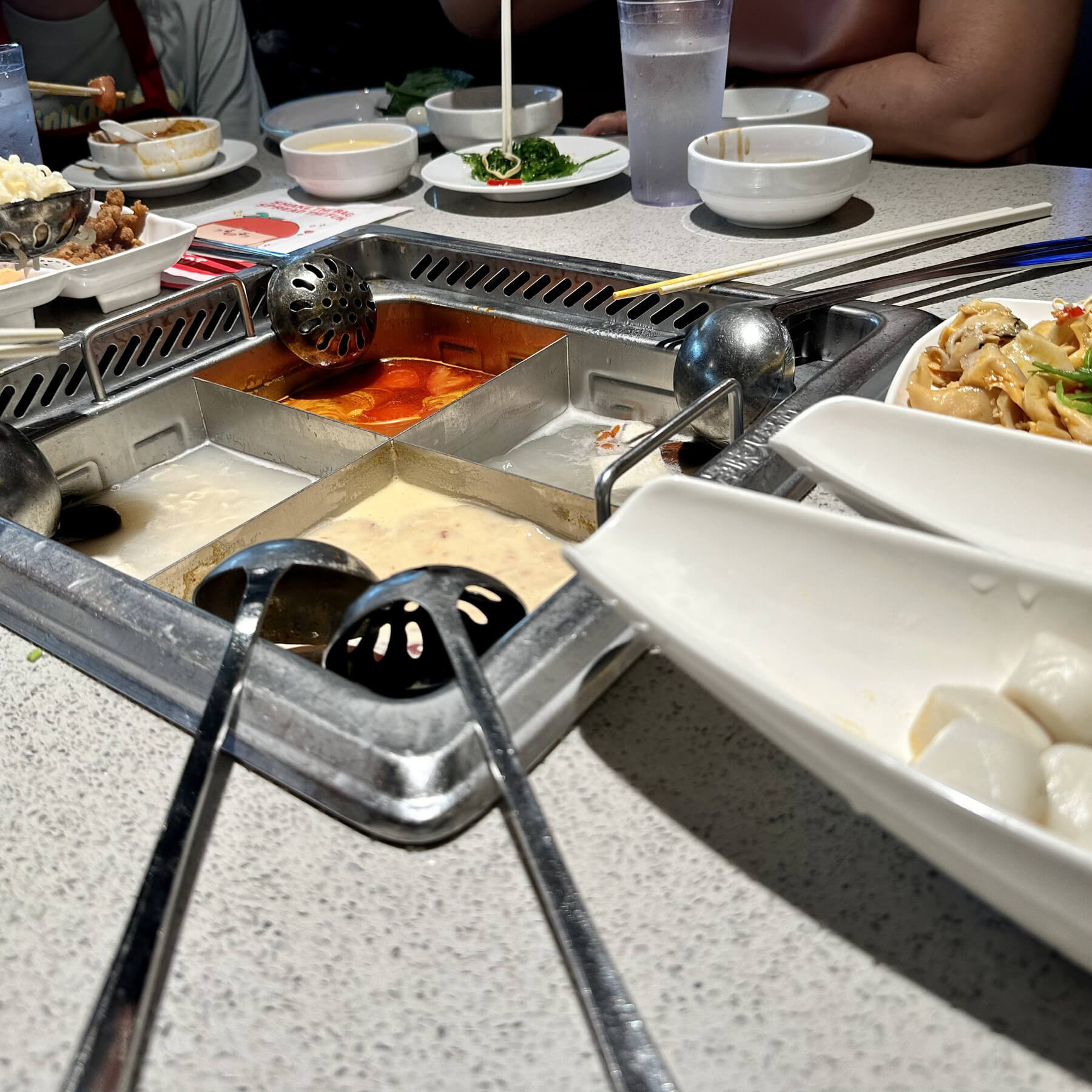
Family hotpot at Hai Di Lao
September 22, 2023
Noyah La Maison, Changi Airport T4
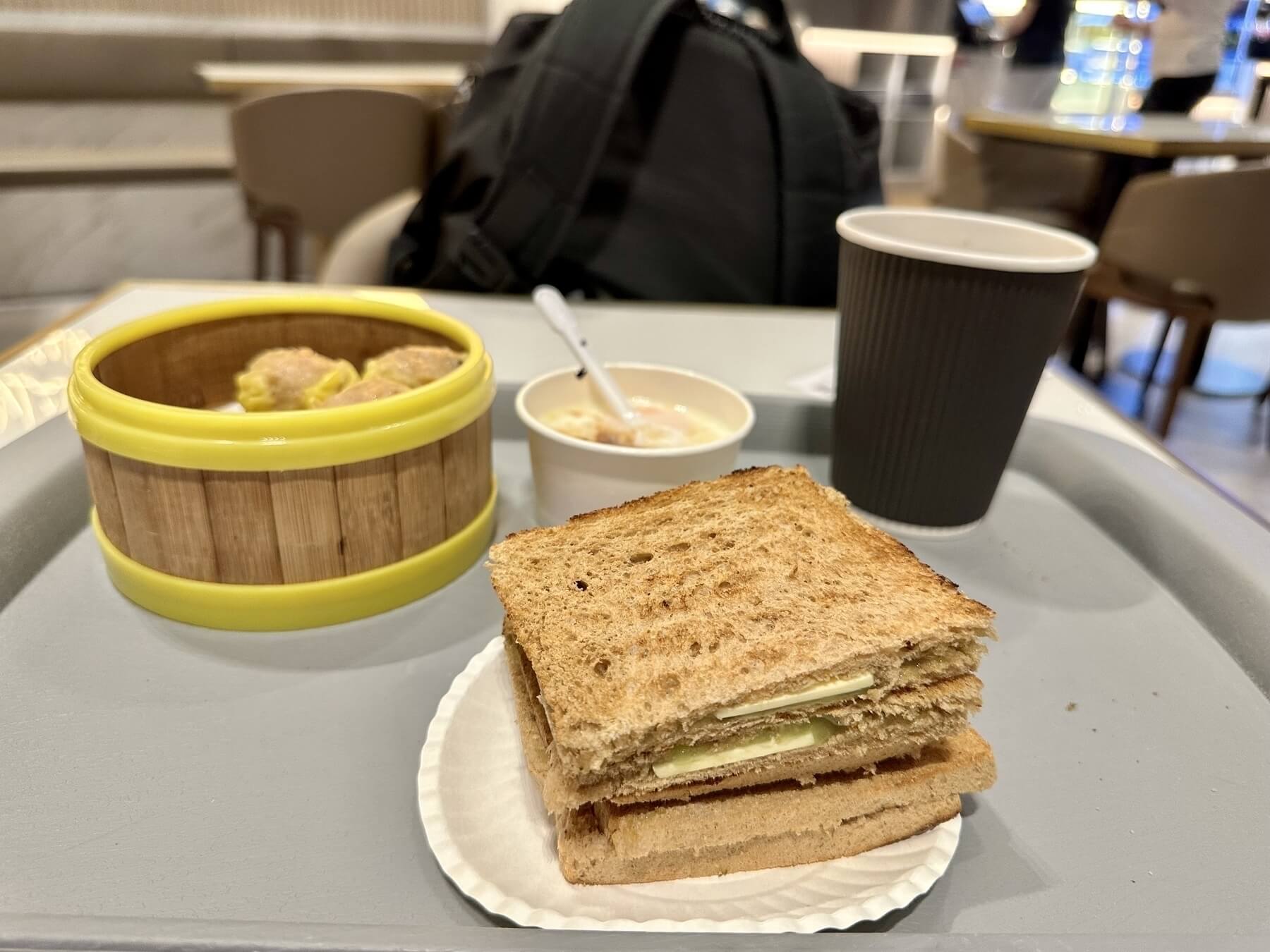
One of the best things about being back in my part of the world, is that breakfast foods now make sense.
No more pancakes, syrup, waffles, badly made eggs for brunch. Definitely no donuts. No sugar in general for breakfast for me, except a little bit in my kopi.
6am at Changi Airport was a routine for me for many years. I was typically catching a 7am flight to Indonesia, Thailand or Myanmar a few times a week in the last decade and a half.
There are lots of kopi spots and while airport franchises aren’t as good as what you’d get in the city proper, it’s still whole lot better than donuts!
Kaya butter toast, kopi, soft boiled eggs are usually sold in a ‘breakfast set’. I was also able to add on halal siew mai.
It’s going to keep me happy until I land in Surabaya in two or so hours.
September 14, 2023
Here are some food thoughts I'm excited about as I pack for my annual visit home. What's home? My passport says Singapore. But in practice, it's the entire region of South and Southeast Asia that I miss and think of as home. I've lived in, and eaten in, Malaysia, Indonesia, India, Myanmar; and spent substantial amounts of time in other countries in the region.
I'm interested in food culture, food ways, migration, food access, the impact of our colonial past, new food trends, enduring traditions, what people eat and don't and why.
I'll be in Singapore, then Surabaya, and I can't wait because (1) I love tropical weather (2) I love the food from these two cities.
Things you can expect in the coming weeks:
- Breakfast in Singapore
- The excellent Chinese food of Surabaya
- Spotlight on Indonesian coffee
- The Yemeni food of Singapore and Malaysia
- Indonesian food you're unlikely to see in a restaurant in the West
- The changing meaning of 'Chinese food' in Singapore
- Coffee shop talk: kopi and teh culture
- Hawker centre, food court, kopitiam, restaurant: what are the differences?
- The best Malay food in Singapore
- Vegan Malay, Korean, Japanese food and where to get them in Singapore
- Fast Food Delights in Southeast Asia
- Southeast Asian Fusion Cuisines You've Probably Never Heard Of
- Little India, Little Burma: where to go and what to eat
Along the way, I'll meet interesting people. I plan to interview some distant family members who run food stalls. I hope to discuss some historical family recipes with people. I want to talk to my friends, who between them know more than I can ever hope to know.
Hopefully, I'll be able to share a sense of what 'food' and 'home' feel like to me: delicious, warm, and happy, and when I return to the Bay Area I'll be able to reconfigure this space to also showcase Asian, Mexican and other immigrant foods in a similarly meaningful way.
April 4, 2023
I have a problem: I tend to be a perfectionist. Sometimes, when something doesn't turn out well I get so annoyed that I don't touch it again forever. Or for a long time. (Recently, I learned that people with autism and ADHD like me have severe 'rejection sensitivity'). Being mindful of this, I'm trying to actively embrace mistakes.
So when I pulled out my film and found many 'spots' on my photos I decided to embrace that mistake, too. I had left a small amount of Photoflo in a container that I also used to stir my Ilfosol film developer. After developing, I noticed that my solution was bubbly. For some reason the detergent bubbles only showed up on one reel of film and not the other. In fact, it lent an interesting visual effect to some of the photos.
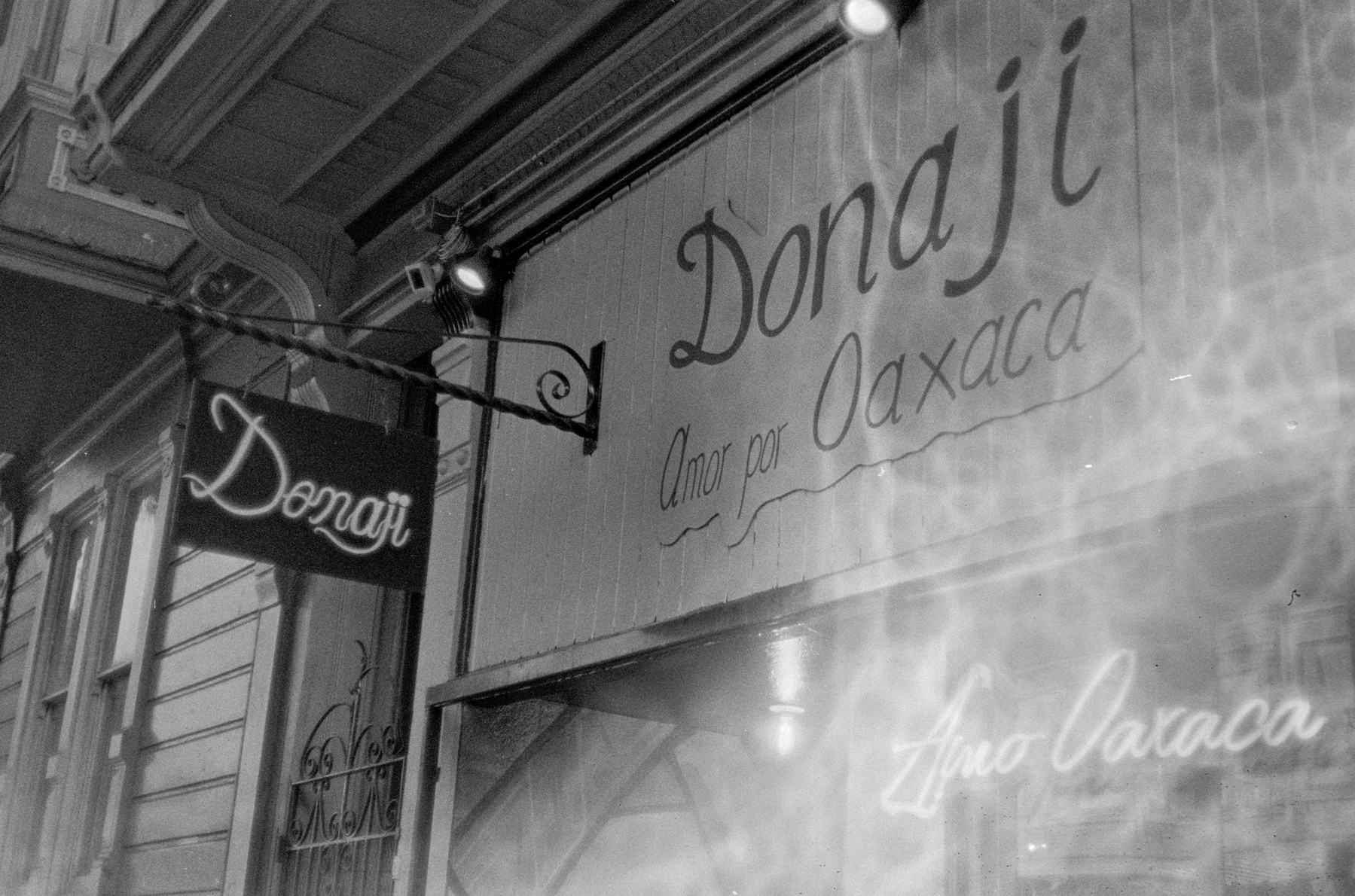
Dinner the other day.
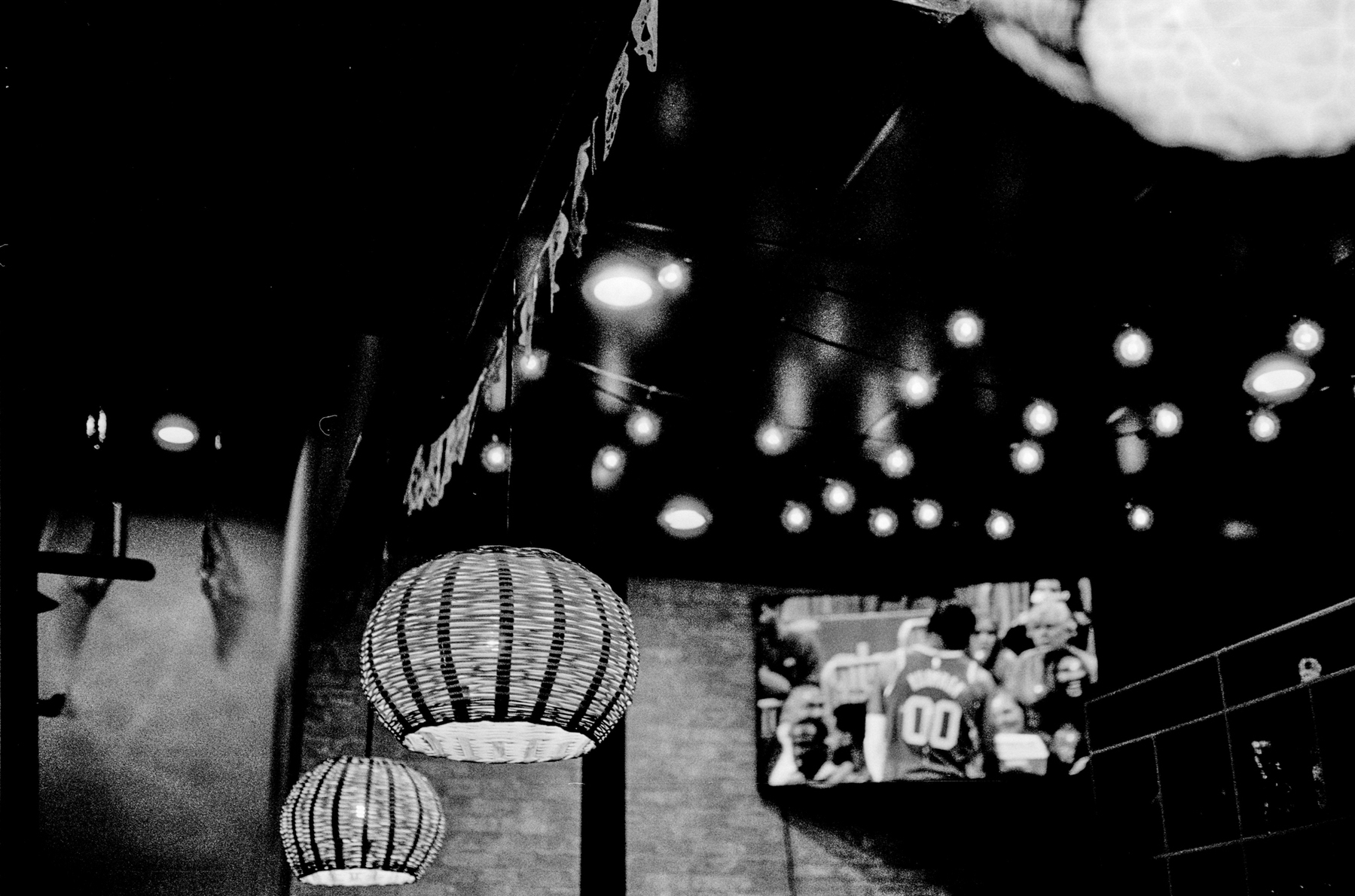
Surprised at how well Kodak 5222 performs in low light indoors.
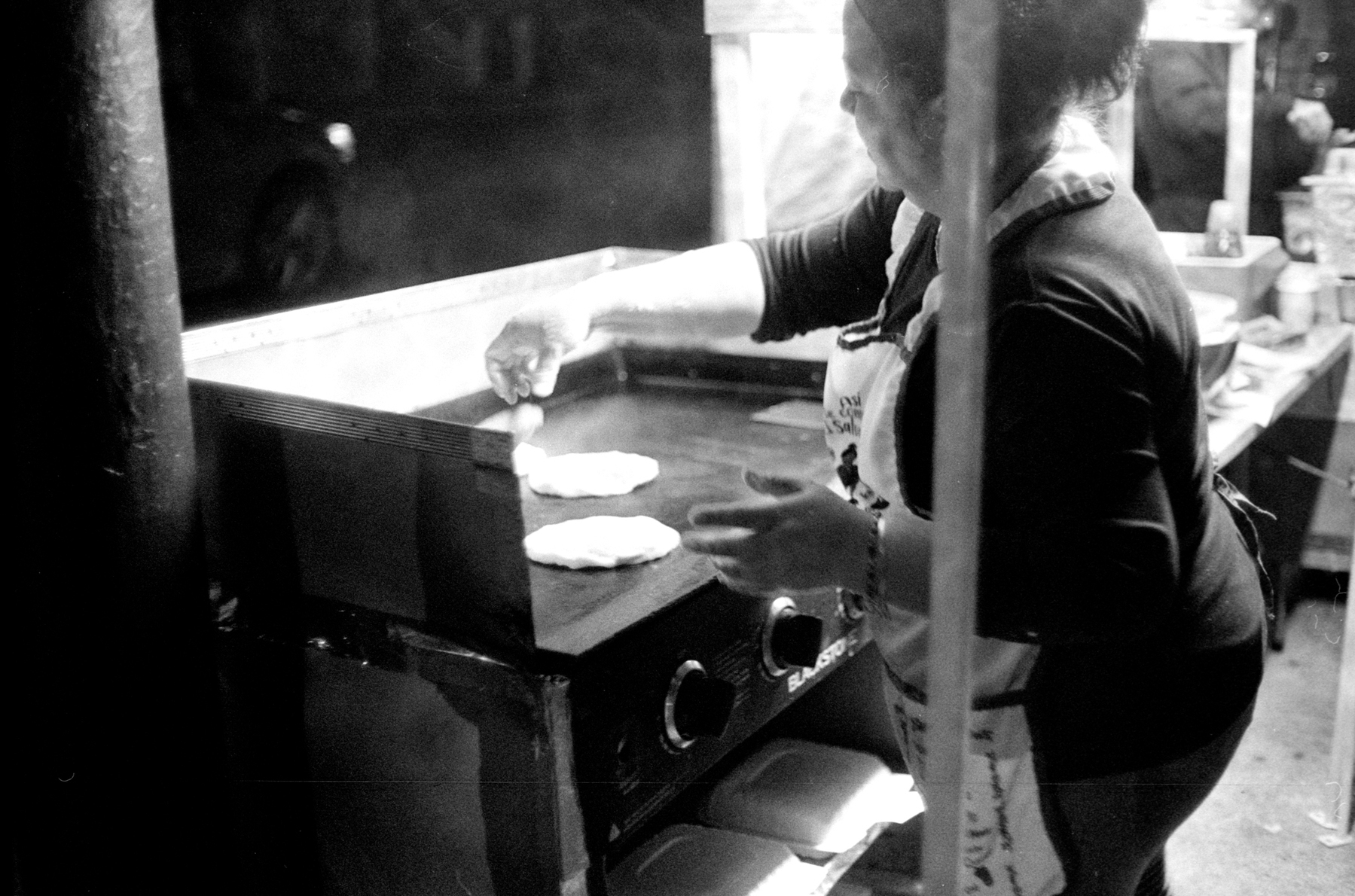
I've been delighted to see more street food vendors in the Mission these days, especially on Friday nights outside very busy nightlife spots. From this lady I also had a delicious, freshly made pupusa with pork, beans and cheese. She was shaping the masa to order when you ordered one. Or twelve.
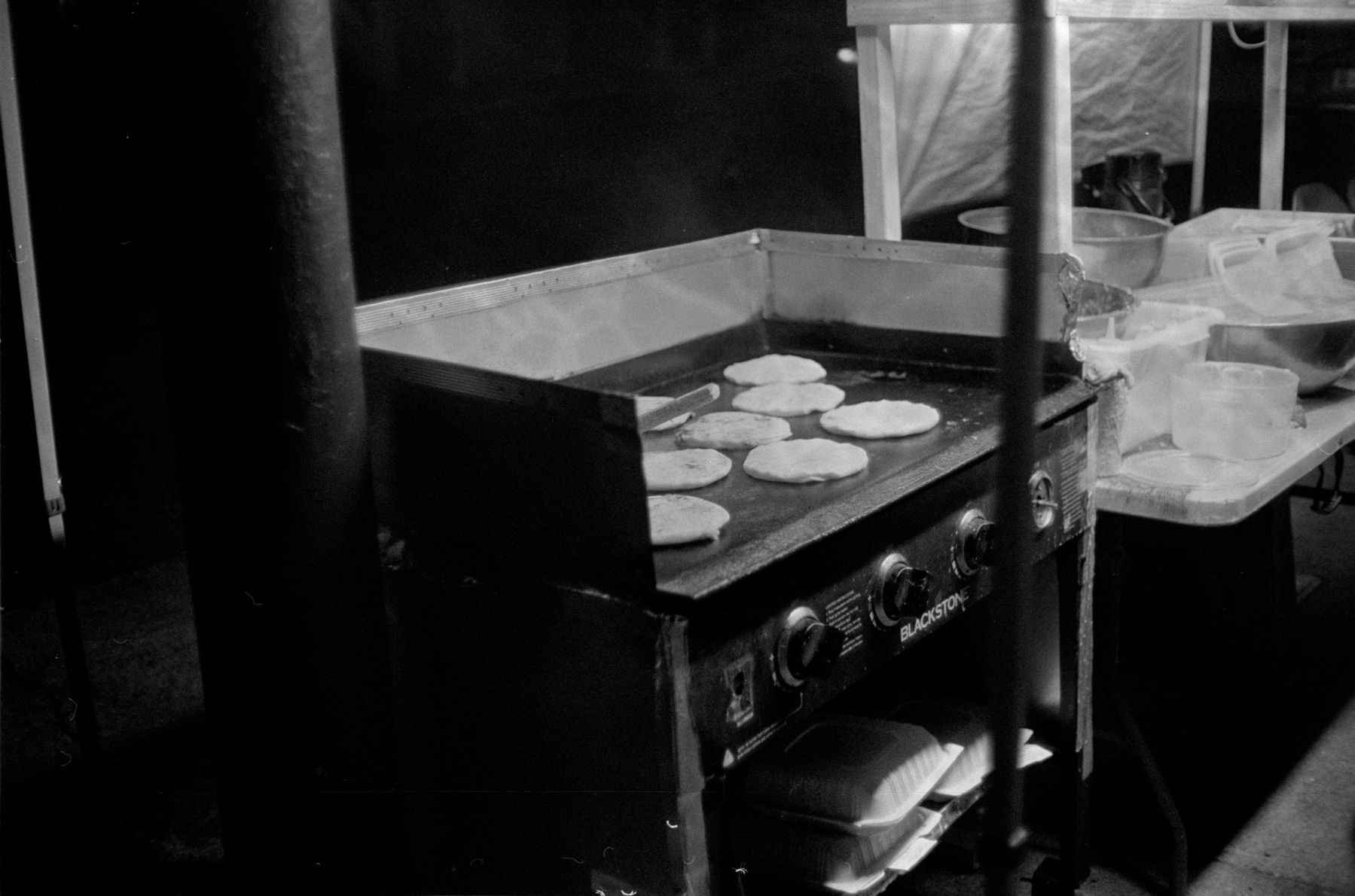
I think I can eat four of them at once.
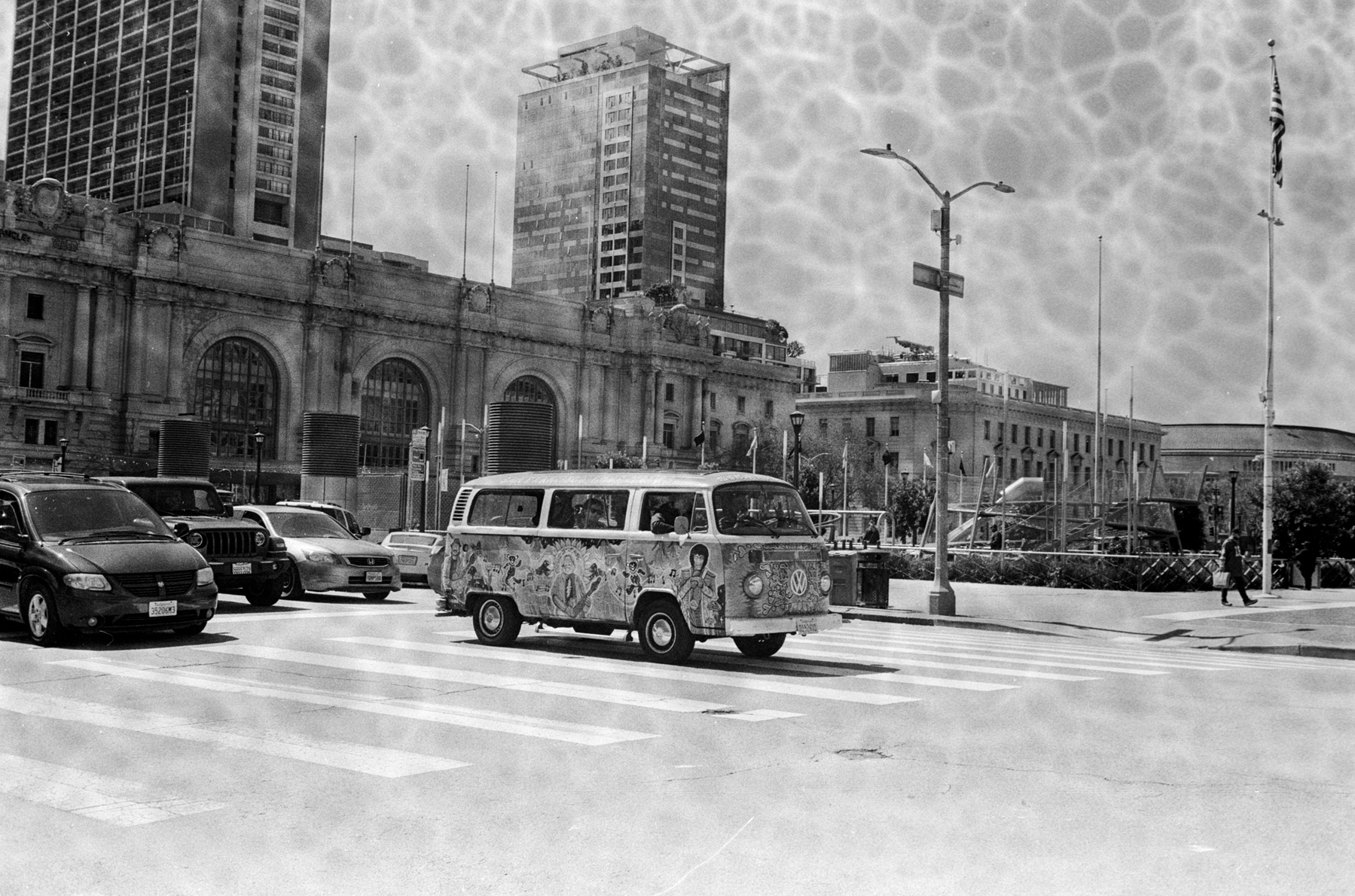
More bubbles. Thankfully, they only impacted less than 20% of the photos.
All film shot on Minolta Hi-Matic 7S II, on Kodak 5222 film, developed in Ilfosol 1:9 for 7:45 min, scanned on Plustek 8200i.
March 31, 2023
I used to be a creature of the night, but no longer. I used to be out all the time, but rarely now. Partly, it's that San Francisco is so chilly at night, but also that it's pretty dead at night compared to the much bigger cities I've lived in. I don't quite enjoy walking around, cold, in areas where there just sijmply isn't that much going on at all. For my wife's birthday, we went out to dinner in the Mission and I also brought my Minolta Hi-Matic 7S II. It's fast becoming one of the cameras I use the most: its f1.7 lens, combined with the small form factor and weight, makes it easy for me to pop it into my jacket pocket. It works really well indoors at night, too, with black and white film (and a steady hand.. or an elbow firmly on a table or chair or door, which is my style. I dislike tripods).
Here are some shots on Kentmere 400, pushed to 800 in Ilfosol 3 (1:9). I really like the combination of this film and this camera, and my self dev setup at home these days. Scanned on Noritsu LS-600.
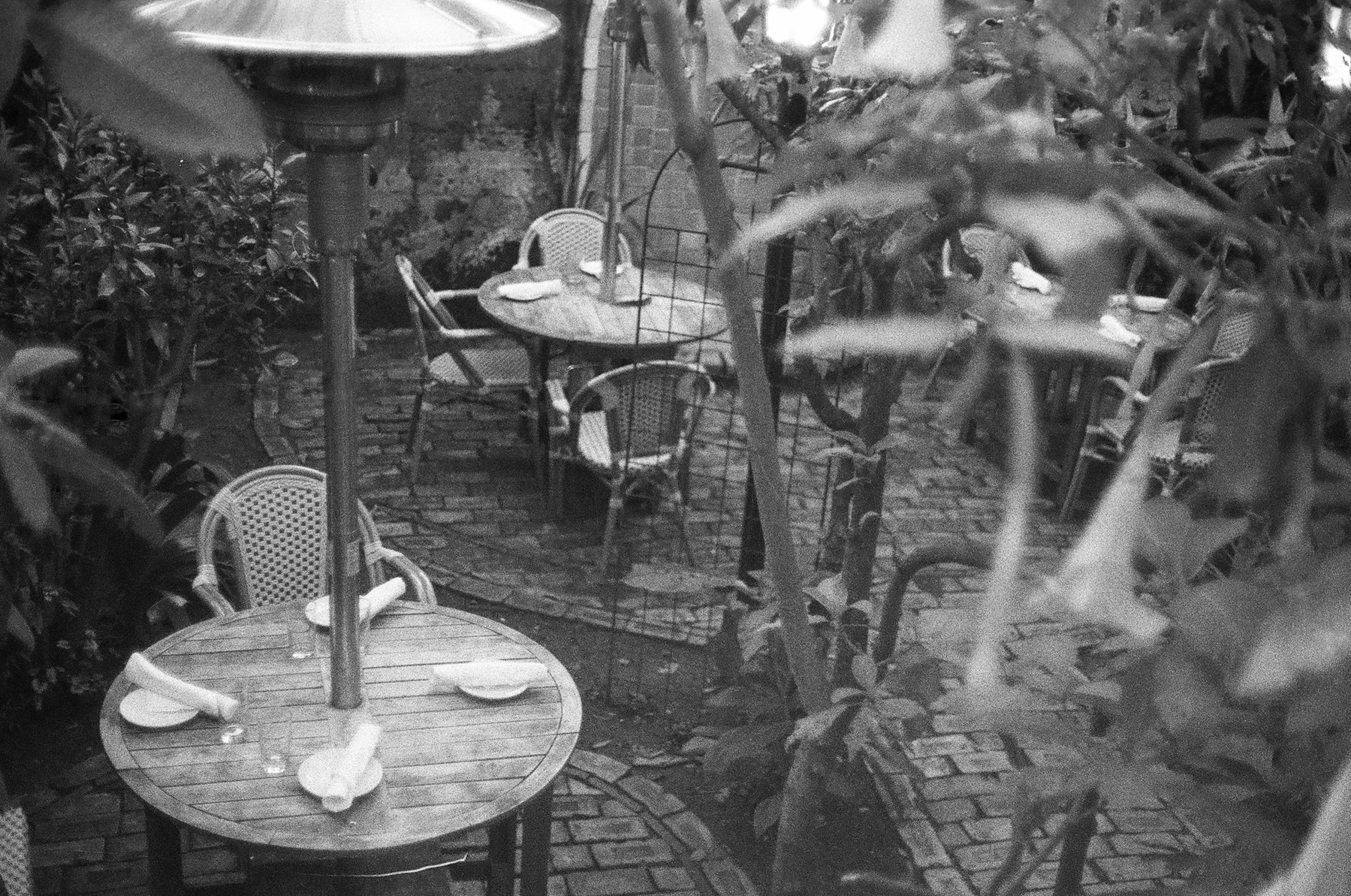
The outdoor space at Blue Plate is quite lovely. So is the key lime pie there.
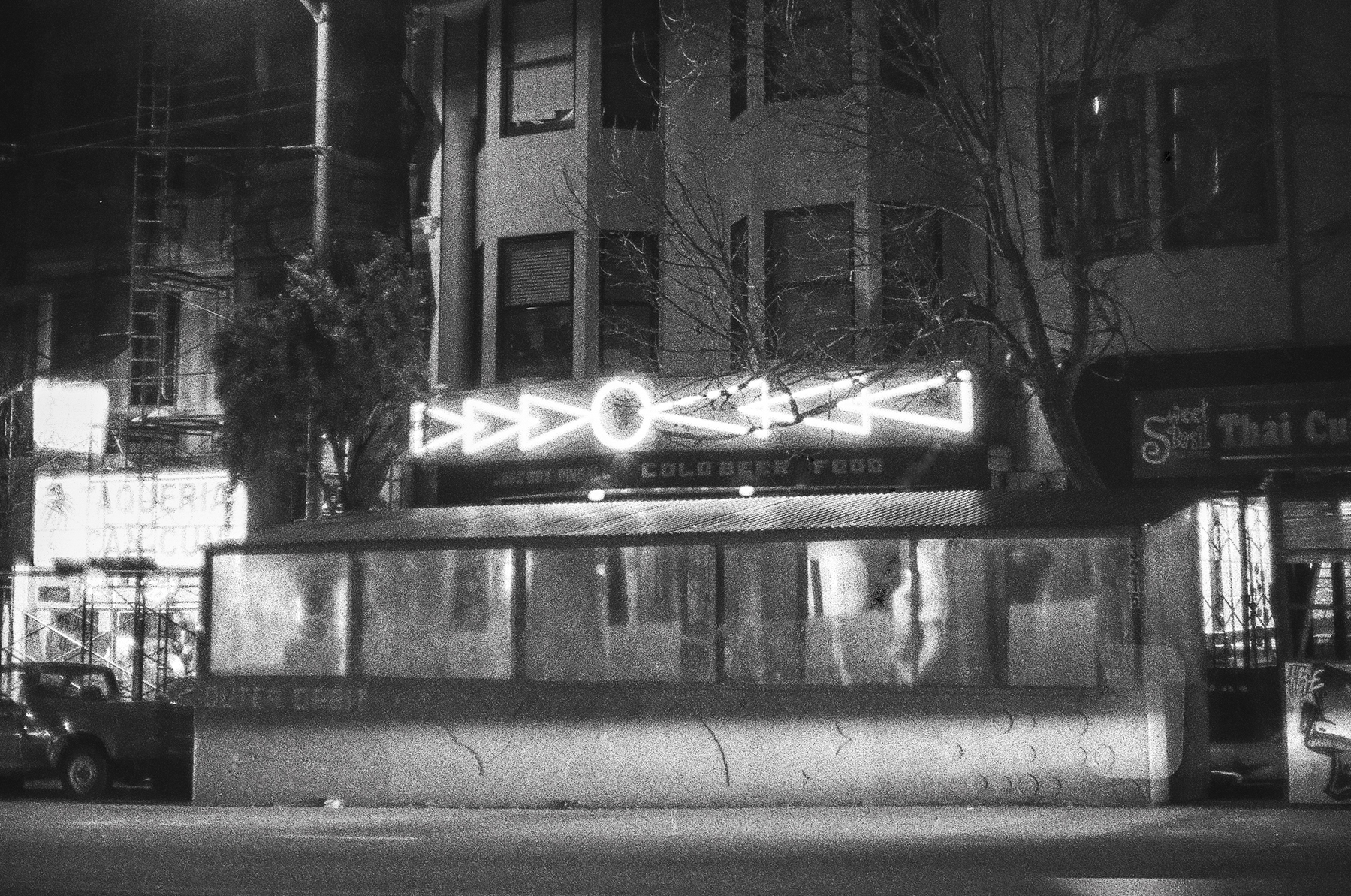
I love neon signs. I also love that I was professionally involved in getting these 'parklets' up early pandemic: my team at sf.gov helped get a joint permitting process out quickly to help businesses move their business outdoors.
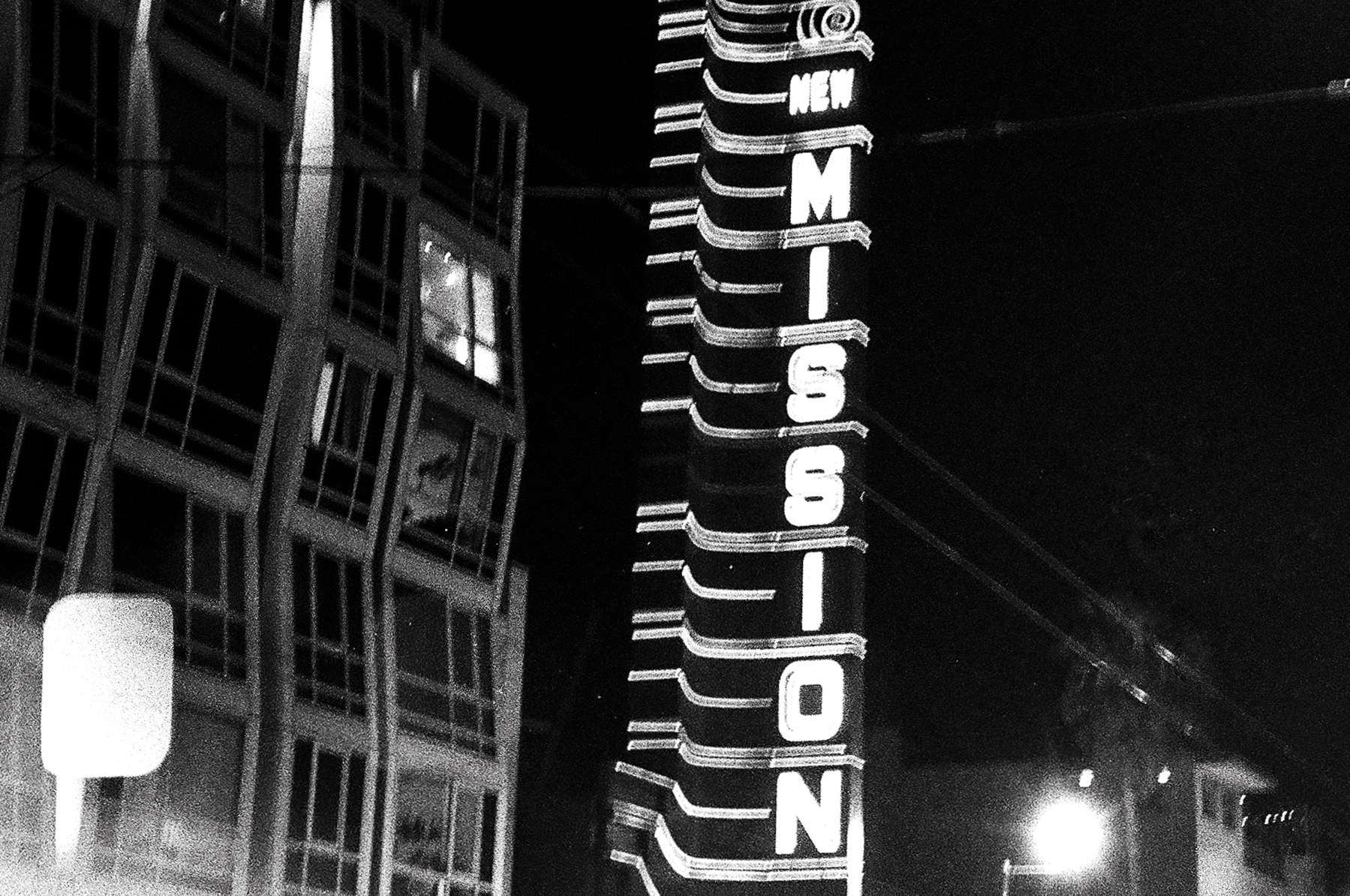
Alamo Drafthouse in the Mission.
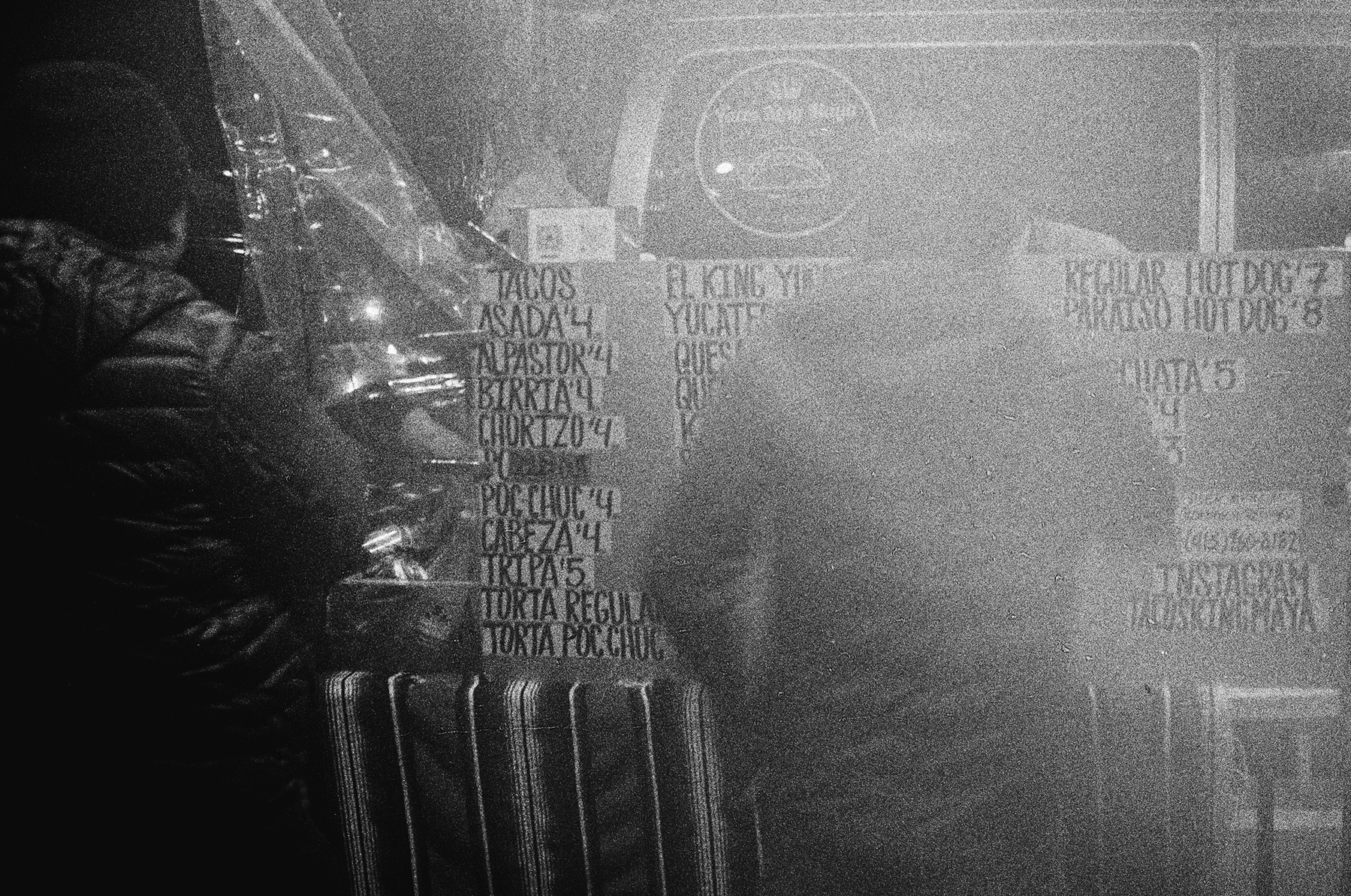
Street tacos are the best tacos. There was a lot of light from one side from the street lamps, but I quite enjoy the effect it casts on the photo.
I am starting to feel more confident about bulk-rolling black and white film and developing it at home. Other than the cost savings, it's the immediacy that I love: I can roll a 24 exposure cassette in black and white, shoot it in an hour, and come back and process it immediately and see it shortly after through a scanner or light table.
March 15, 2023
Wet markets have a bad reputation, because of the 'rona, but their name really just comes from being the opposite of a 'dry market' (like a market that sells pots and pans and such). They are very common in many parts of Asia and don't have wildlife. For many of us, a wet market is our first port of call to make the delicious foods from our part of the world.
These photos are from a wet market in Taiping, Perak, my wife's hometown. We visited with my mother-in-law and her sister, who were preparing a large family feast for the first reunion in the Taiping home in a very, very long time.
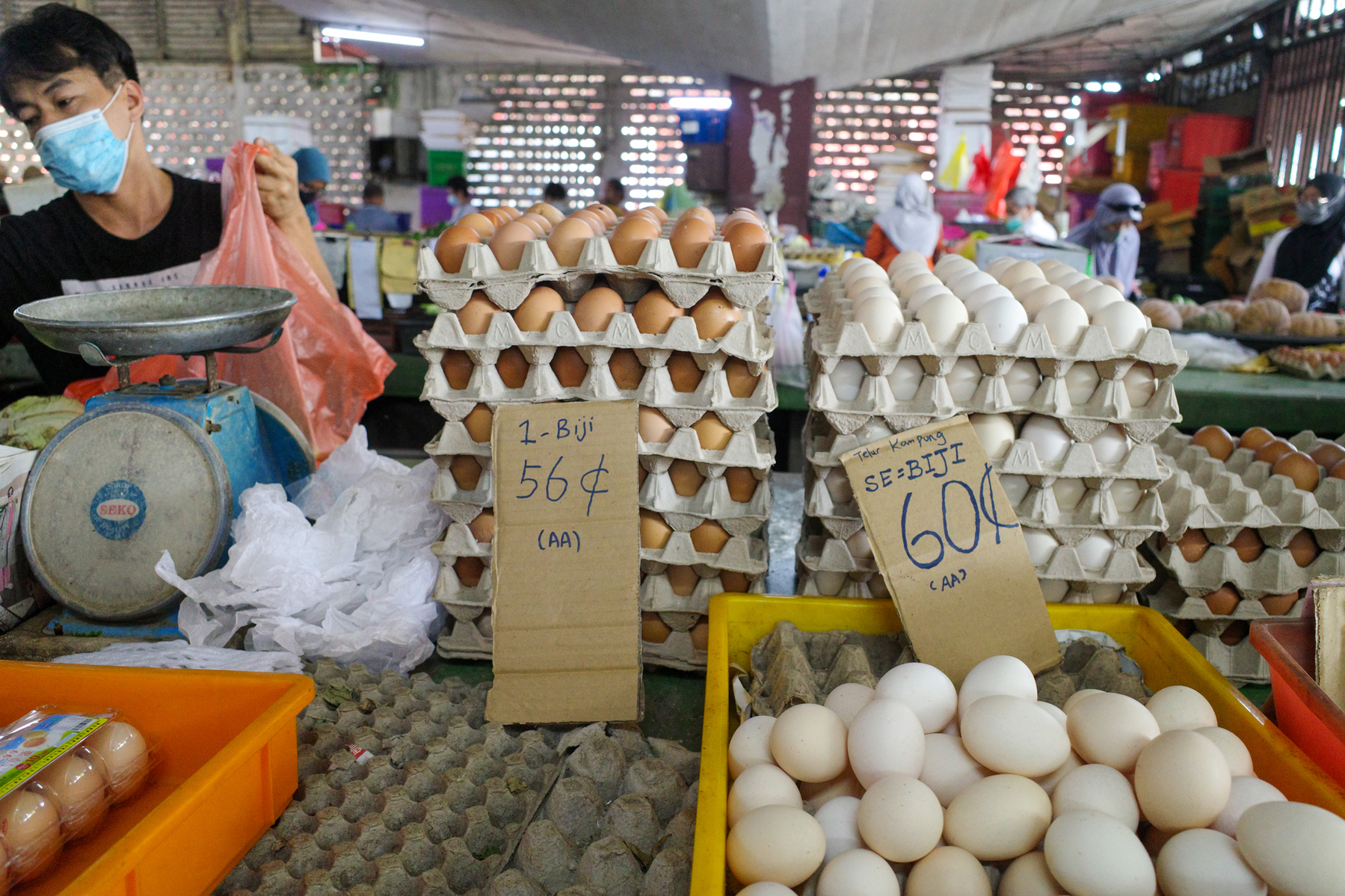
Eggs
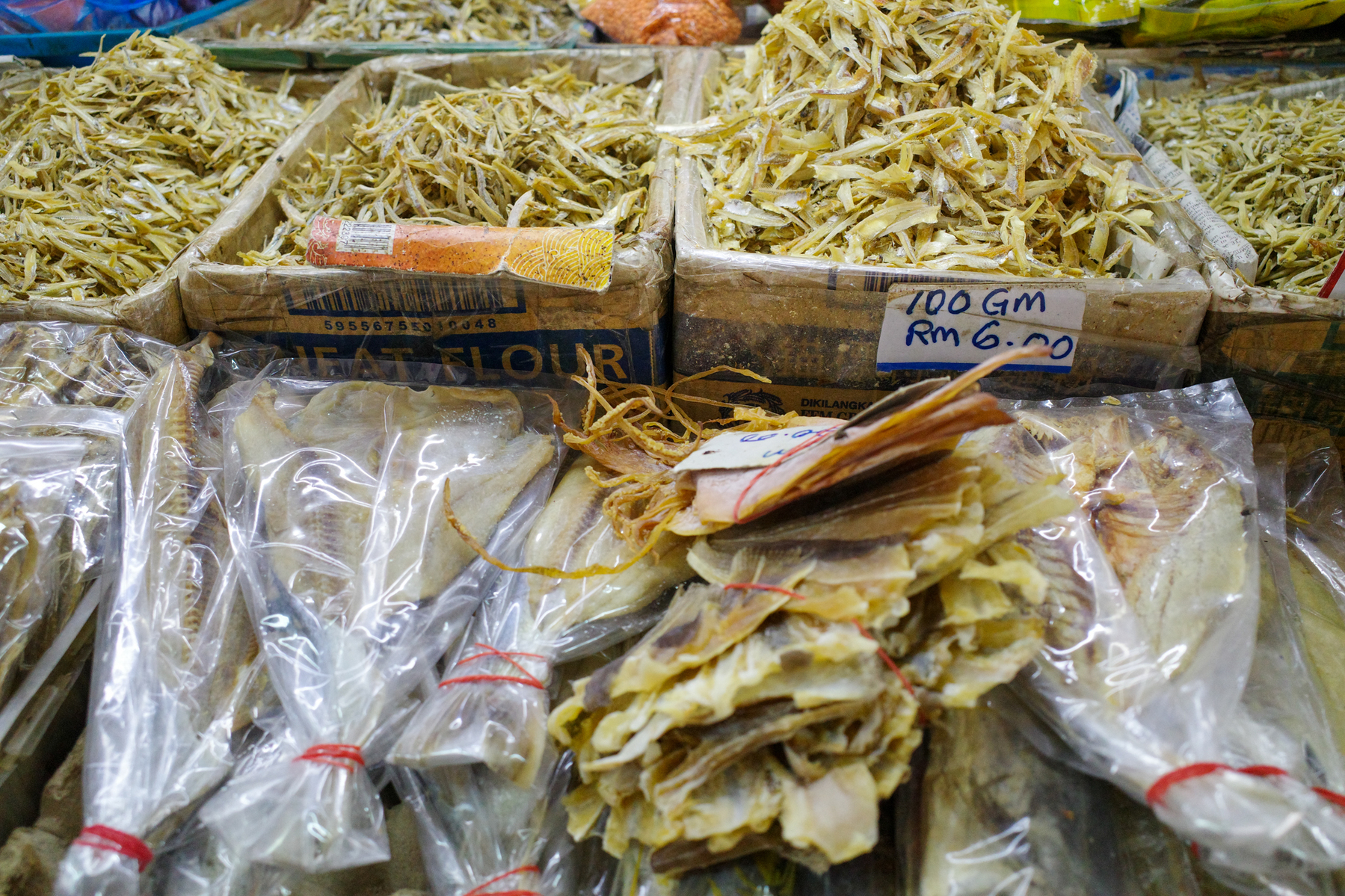
Salted fish

Essential items
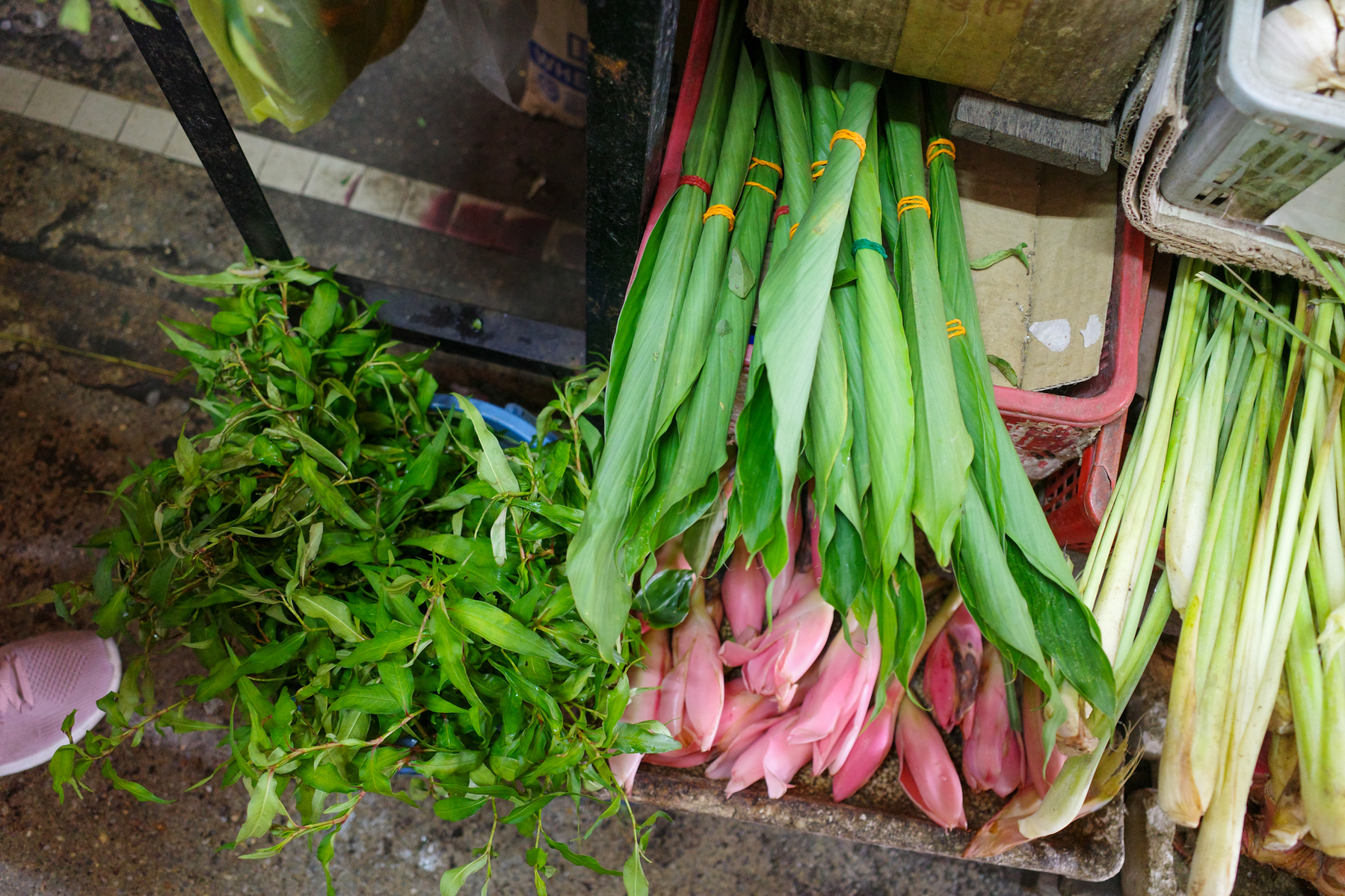
Aromatics
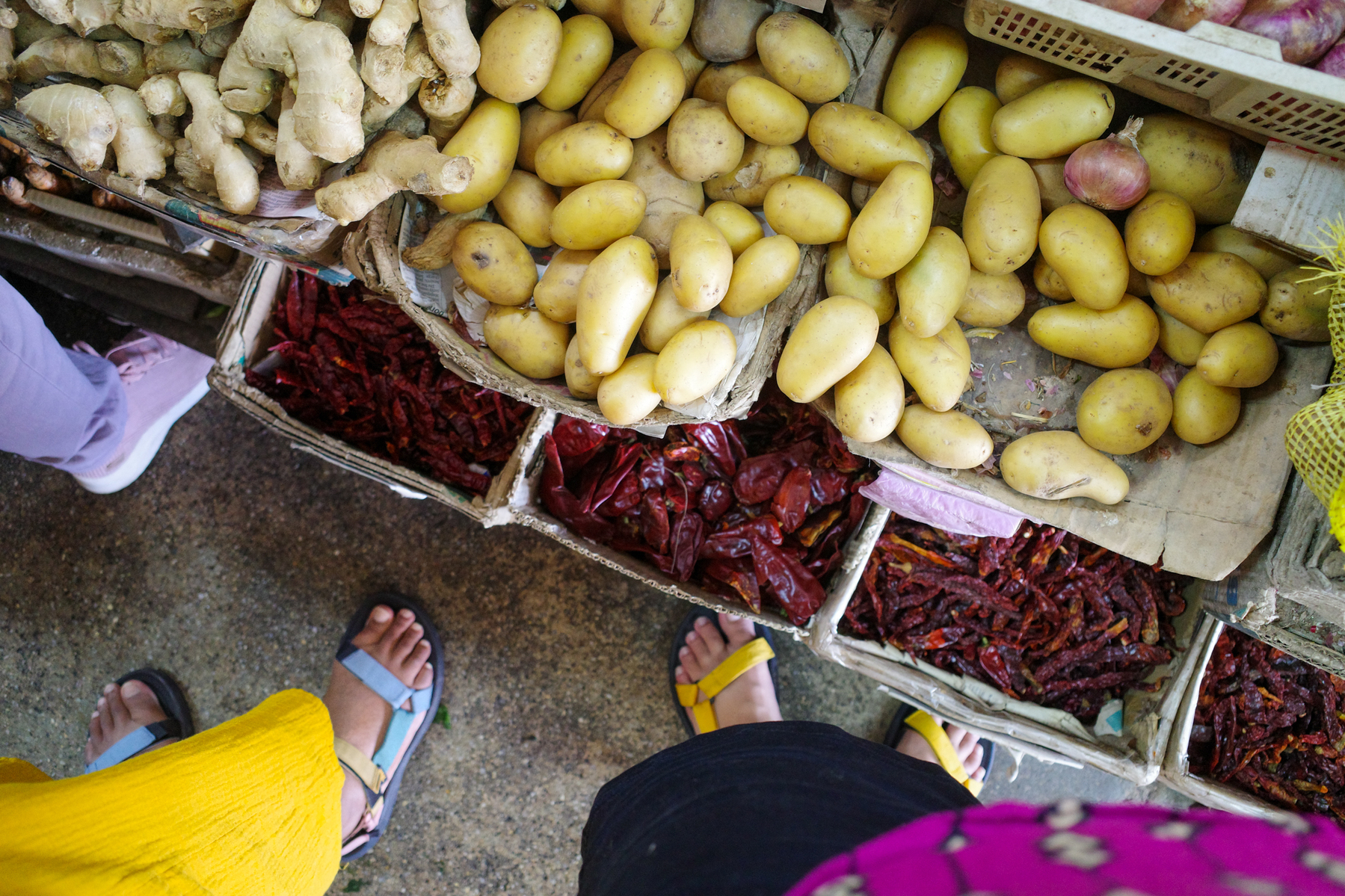
Potatoes
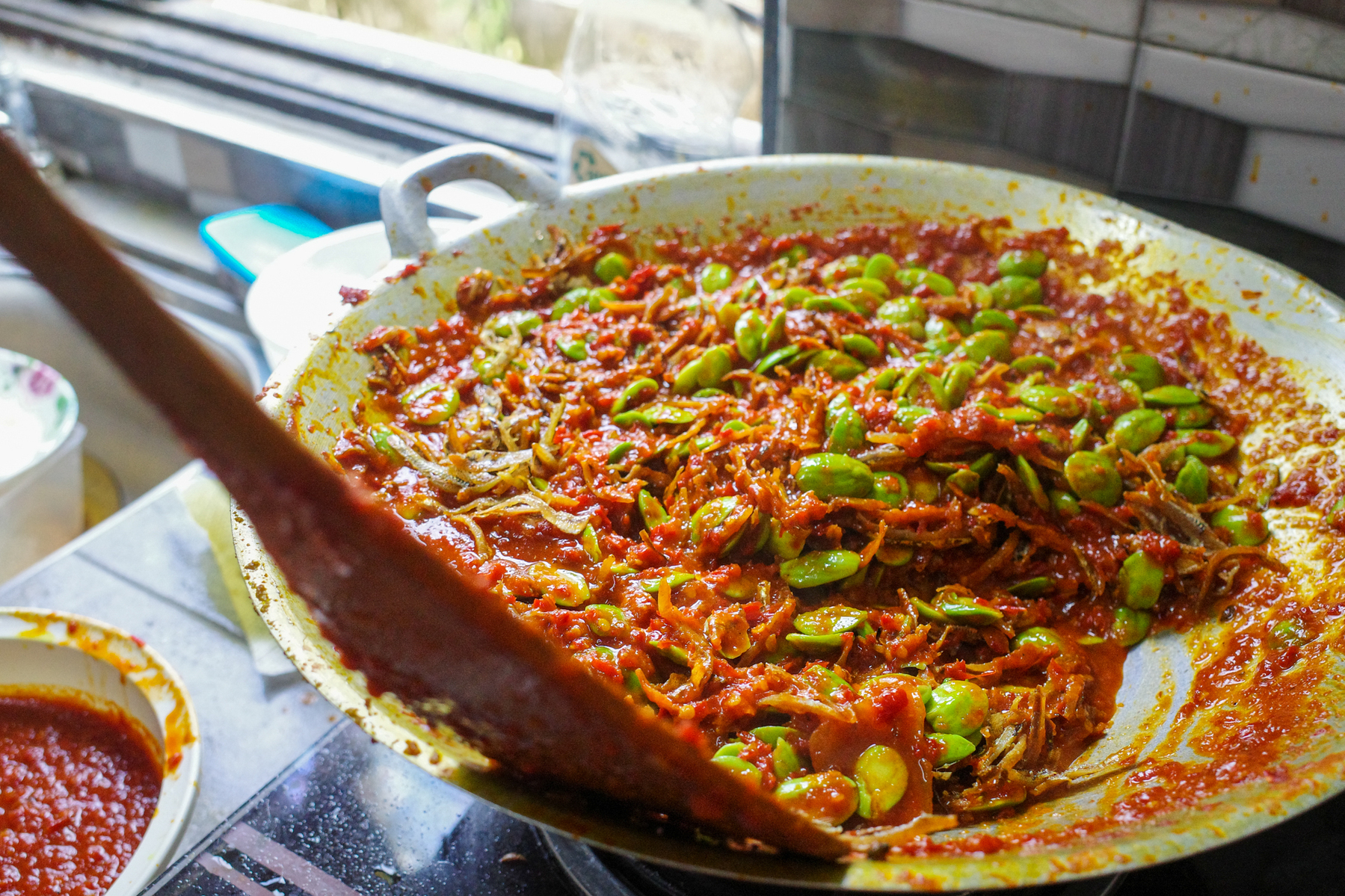
Sambal
I can still taste that sambal. What passes for sambal in the United States (Huy Fong sambal oelek!!) makes me so, so sad.
Lately, I've been thinking about how growing up in Peninsular Malaysia and Singapore (and spending lots of time in Thailand, Indonesia, India) really spoiled me where food is concerned.
The food ways I am used to: buying fresh food. On a daily basis. At wet markets. Learning to cook traditional foods from skilled older people from different cultures.
All of those things are vastly different from a convenience-first food culture where I now live in the United States. Even though California, and San Francisco in particular, has a reputation for being farm to table, and for having good quality food, I do find myself feeling, quite often, like I never knew how good I had it until I left Southeast Asia. California is good, for food: my part of the world is better. That's how I feel, anyway. Being able to wake up in any of those countries and grabbing one of many hot breakfasts. Being able to eat hot, savory, spicy food all day, everyday, including at 3 or 5 in the morning. Being spoiled silly, really, by aunties of all types. Being surrounded by people who want to feed you all day, every single day.
Taiping, Perak in Malaysia is one of my favorite little towns. It has beautiful weather and scenery, an interesting history, and some of the best food I've had anywhere. I dreamed of the simple bowls of noodle soups I've had there (Restoran Kakak!!!), for years, until I went back again in 2022 to visit my wife's family. You've not had noodles until you've had the kway teow tng at Restoran Kakak. It takes skill, and really 'giving a damn' to make food like that. I think Taiping (and Perak as a whole) has a higher density of people who 'give a damn (about making food in a very specific way)'. And that's just normal, there.
Invalid DateTime
As a child, my parents would put us on a bus or train to Kuala Lumpur to see friends, visit people, or just have a weekend break.
One of my strongest memories of KL: getting out of the overnight train at the old railway station, and strolling to Chinatown (Petaling Street) for breakfast. Air mata kucing (literally translated to 'cat eye water'), is a sweet drink with ice, rock sugar and longans. This stall in Petaling St is extremely famous, and probably still there today. I loved drinking it out of the little steel bowls they used to have, the ice cooling me down in the ever present Malaysian heat.
This photograph was probably taken in 2005 with a Yashica Electro 35. I can't wait to go back there and have it again.
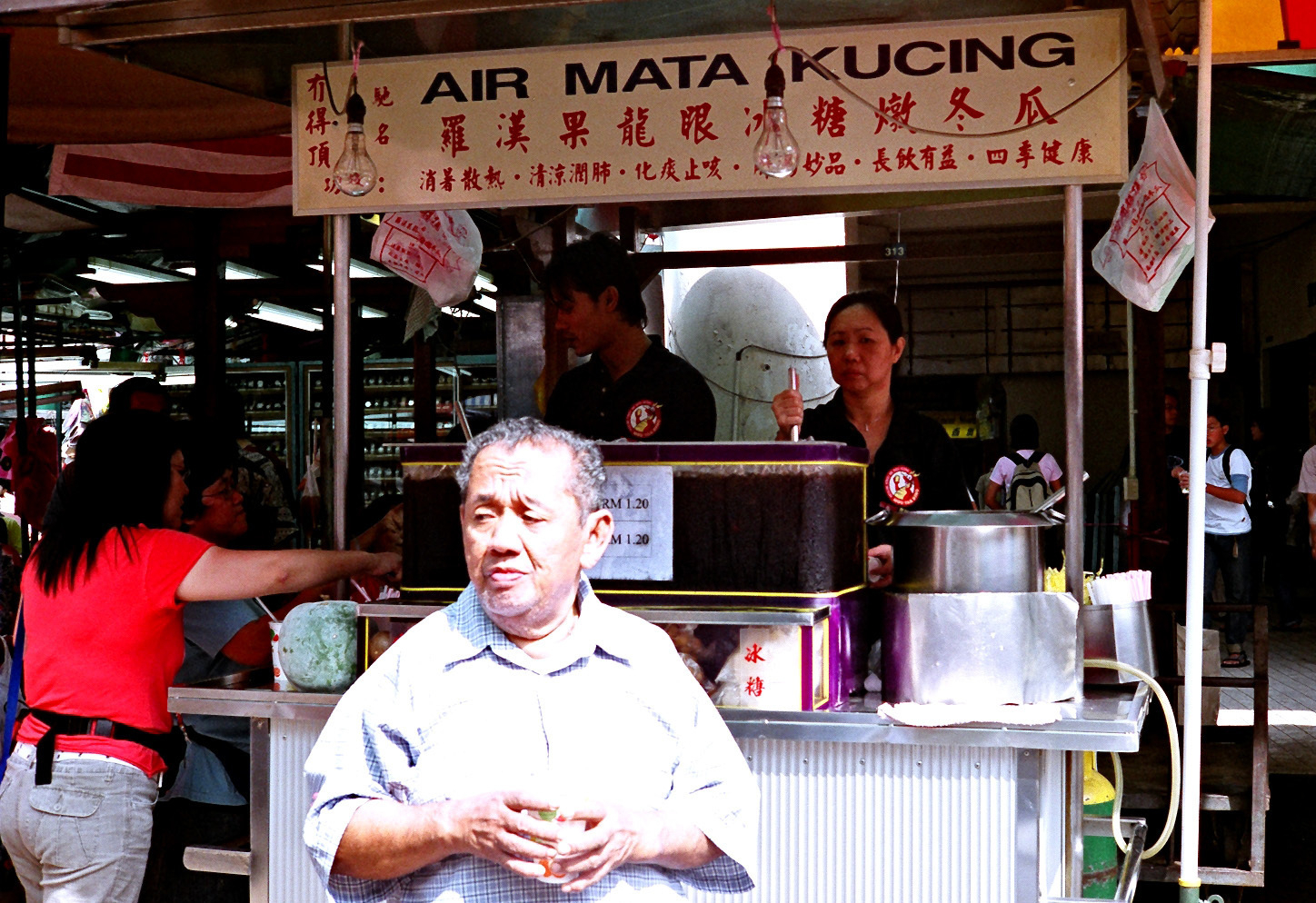
Longans are now popular in the west as a sugar alternative: 'monkfruit' sweetener is popular with fitness types. I like the fruity fleshy taste of longan, or 'luo han guo', in a traditionally made beverage like this. To this day, I haven't found a better version than this stall, though nostalgia is a drug.
Invalid DateTime
As you may know from elsewhere, I love food. I am obsessed with it. I love eating, I love food stories, I love writing about food, I love writing about people who make and eat food.
I did that more actively in the past where I wrote a few travel guidebooks and cookbooks, and also published a few articles about Asian food culture and chefs in various publications around the world.
From my archives, photos of two true artisans. One in Kuala Lumpur, Malaysia, the other in Roses, in Spain's Costa Brava coastal region.
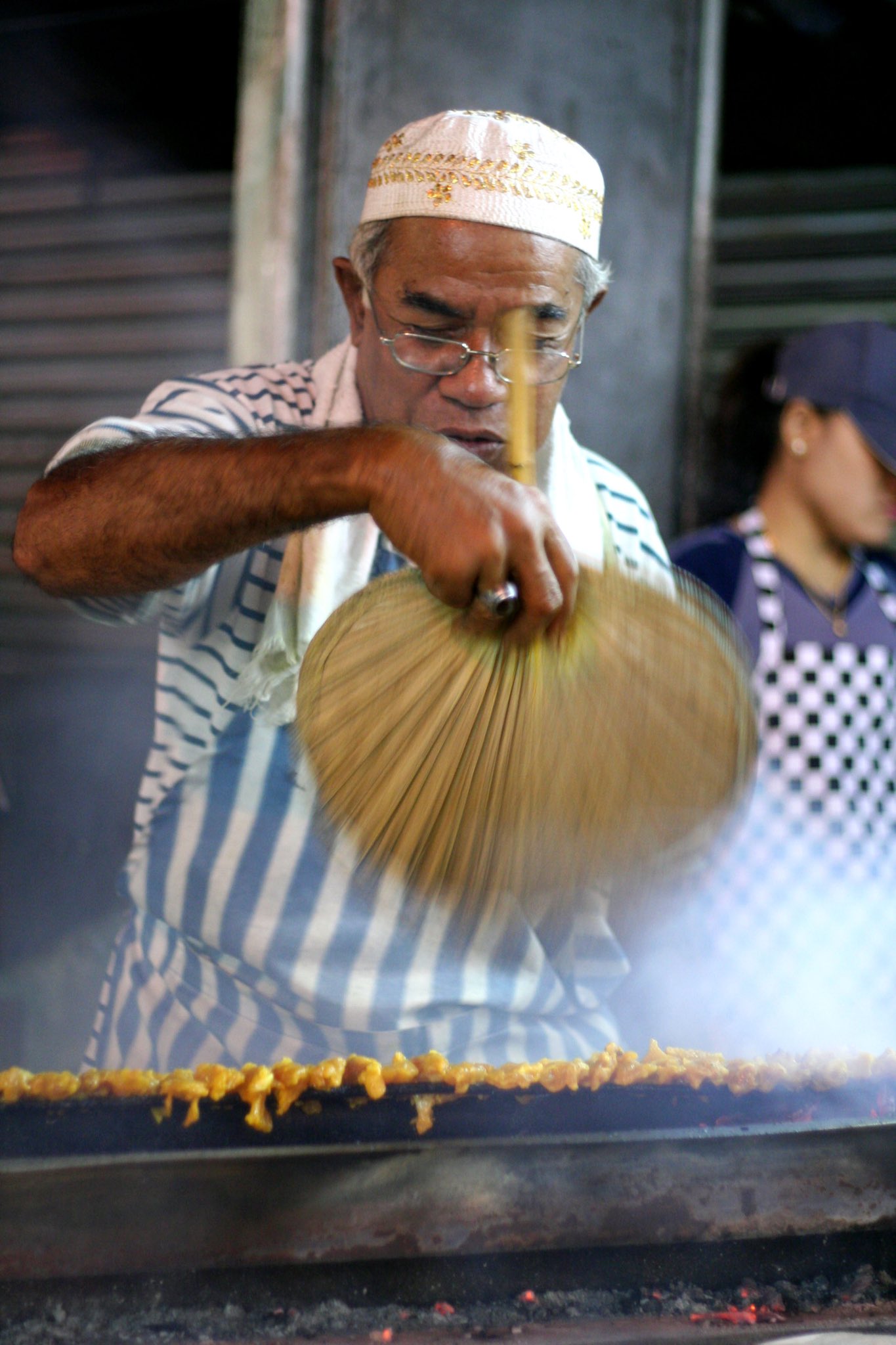
I maintain that you haven't had satay / sate until you've been to Malaysia, Indonesia or Thailand. The quality and artistry of this type of grilled skewer is on a whole other level. Xinjiang style BBQ skewers are also very good, but in the realm of well spiced, fatty satay Nusantara style, this is my favorite. Unmarinated and unseasoned chicken breast satay in Asian restaurants in America make me weep.
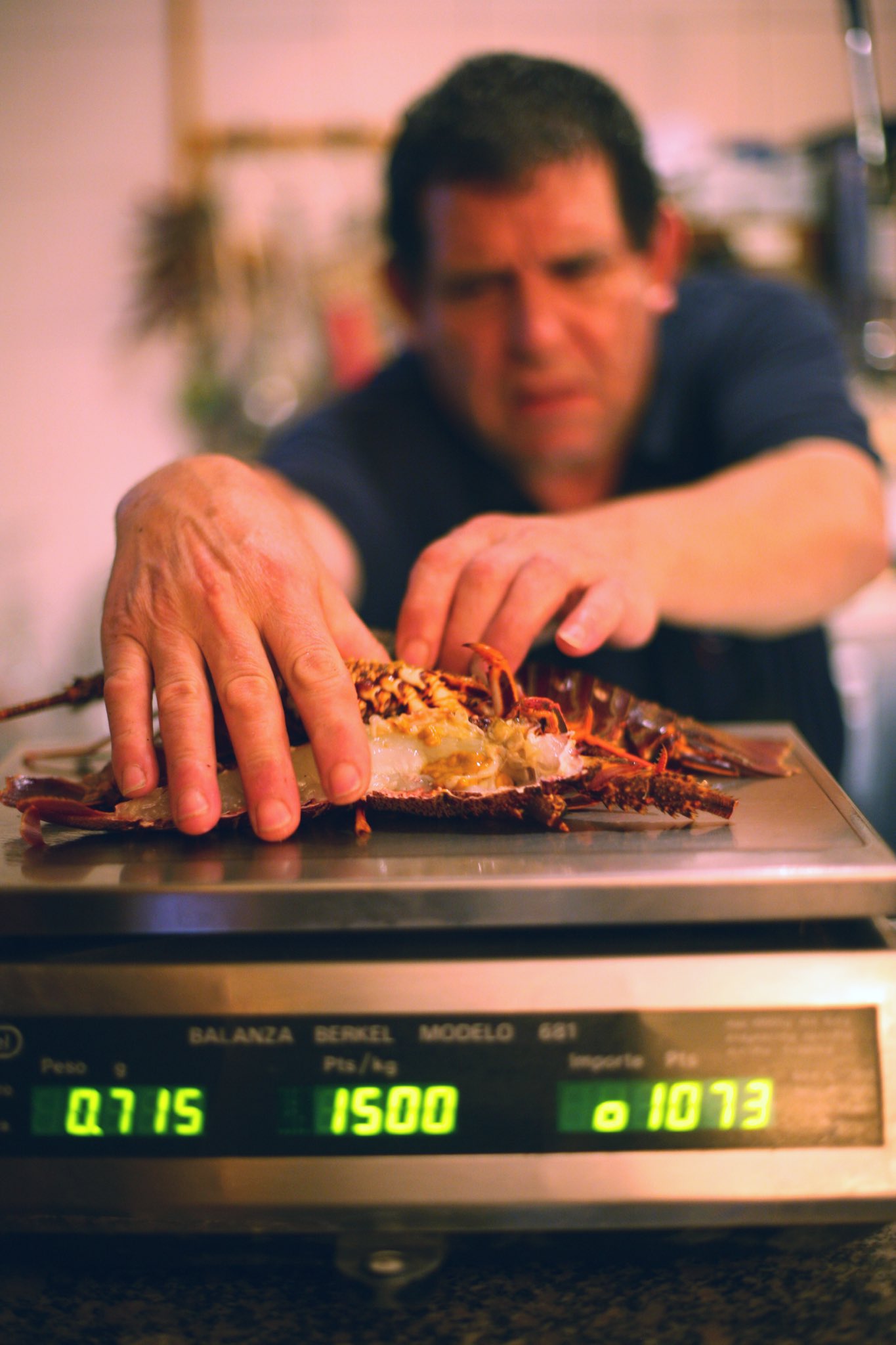
I had the opportunity to eat at the 'best restaurant in the world' (El Bulli) in 2008, shortly before they closed. It was a memorable meal, but the ridiculously great seafood at Rafa's in the town of Roses was even better. Here, Rafa himself weighing the seafood he's about to feed the hungry patrons of his tiny restaurant.
Photos shot on Canon 350D and 50D, with a 17-40L lens, probably one of my all time favorite lenses.
May 20, 2021
-
'Singapore food' is a difficult term. It's hard to put national wrappers around a smorgasbord of different culinary influences. This is why we keep getting into fights about appropriating others' food. Singapore food is Cantonese, Hakka, Hokkien, Hokchiu, Teochew, Malay, Javanese, Sumatran, Tamil, Kerala, Mamak, Punjabi, Bengali, Kristang, Peranakan, Chetty, and many more.
-
We simply consume some of them more than others, in public; and some are more widely available commercially. Others are largely consumed at home.
-
The Singapore food popularized by the tourism board, that appears in movies like Crazy Rich Asians, is only one of many types of Singapore food.
-
When Malaysians say 'it's better in Malaysia', they are usually right, except for when they are referring to dishes that exist in both northern and southern Malaysia. In that case, the Singapore version, usually held up to be the inferior one, is usually only a mirror of the southern Malaysian, usually Teochew, version of that dish. It is not better or worse, it is just different.
-
As Singapore / Malaysia food gets more popular abroad, especially in the US, we're going to have to be prepared to see it transform in ways that we may not always appreciate. Like ube, kaya and pandan is going to go on a similar journey. I'm no longer personally invested in the idea of everyone eating exactly the same version of the food that I like; it's fine to let kaya and pandan become its own thing elsewhere.
-
Gula Melaka (obviously not Singapore food, but used extensively in Singapore) is god tier and will become the next big thing in global pastries and dessert, especially in sweet/salty applications like salted caramel.
-
One of the best aspects of food in Singapore is that many of the world's top food brands already, or will soon, have an outpost here. Some better than others.
-
The breadth of vegan and meat alternatives in Singapore currently is breathtaking. It's certainly changed in this department since I left home. While I'm not vegan, and likely will never be, I appreciate the options that are available. While one might need to go to a midrange restaurant in San Francisco to have Impossible burgers, there are Impossible burgers in convenience stores here. There are vegan options in a lot of local food now, a lot more than I remember. Pretty much every major plant-based or meat alternative or lab grown company is here with a product out on the market. Way more than in the US. And all in one tiny city. I'm excited to try the vegan sashimi that I just saw, and the vat-grown chicken. This is definitely related to the next section on 'how come I can get all of my favorite food in one city now?'
A list of foreign food chains I like in Singapore
#
Burgers: Shake Shack, Five Guys, Carne
South Indian: Murugan, Anjappar, Junior Kuppanna, Ponnusamy, Dindigul Thalappakati
Malaysian Chinese: Go Noodle House, Super chilli pan mee, various Malaysian hawkers at Malaysia Boleh
Taiwan: Sushiro, Mu:, many many boba / bubble tea chains (most of them in fact)
China: too many to name, other than Hai Di Lao there are also Chinese chains for specific regional dishes, like more than two famous chains for say, suancai
Way too many Japanese and Korean chains to list.
Sure, chain food isn't all that exciting and many of them arrive here in a completely bastardized form especially when they are run by a local F&B group that is less good at running franchises. But the ones run by the owners, like most of the Indian and Malaysian chains, make me very glad to have something I love so much all in once place especially in times like these when I don't think I'll be able to travel to those places for longer than I'd like.
So why are there so many chains setting up shop here? I suspect capital flight, and the precarious political situation in Hong Kong as a traditional financial hub. It's also incredibly easy to setup a business in Singapore. While there are some problems with that model, you can definitely draw a direct line from the ease of setting up shop to why we have all of these restaurants.
I love that I can get biryani with seeraga samba rice (the clearly superior rice for biryani) in not just one style, but several: Kongunadu style at Junior Kuppanna, Thalappakati style at Dindugl Thalappakati. I love that I have many, many types of boba to choose from, from hand-brewed tea-forward teas like at Chicha San Sen to black sugar boba abominations with cheese like at Black Sugar or Xing Fu Wang. I love that the noodles I love so much when I lived in KL are mostly here.
Not forgetting individual chefs or restaurant owners who don't have chains, who have simply moved here and are doing what they do best here. I've had very decent Ipoh horfun and Sarawak kolo mee. I'm really liking the boom in Henghua (xing hua) food, after Putien's success. You find these at tiny restaurants (like Yun Heng) and at food courts (like at Malaysia Boleh). We've also recently found a very-close-to-Village-Park style nasi lemak at Uptown Nasi Lemak, Telok Ayer (which is totally different from Singapore nasi lemak).
I hate it when food writers spend too much time talking about how you can get gasp high end food at low end prices. That, I think, is unique to Singapore in some ways because we have a large number of trained chefs and cooks at the many, many hotels and restaurants; and many of them, like chefs and cooks anywhere, want to do their own thing. Our inventory of non-restaurant space, like at hawker stalls or food courts or commercial shop space below public housing, has made it possible. You have always had things like 'Austrian man sets up sausage stand in Chinatown' or 'Japanese couple selling Singaporean Teochew noodles in hawker centre' in the first wave of that. We've also always had stories of 'hotel chef sets up shop in hawker stall'. So I am not, as a food-obsessed Singaporean, surprised by this sort of thing.
What this means in daily life, though, now that I live somewhere with with a well-known but very different food scene, is that you can get fancy dimsum in a place like Yishun. You get French-trained chefs cooking Hokkien mee.
I love that. However, I love more when a new generation of Singaporeans take over, or start, hawker food businesses. It leads to innovations that take the best of our traditions and blends it with our exposure to new things, and makes it entirely new. As a Teochew person, I love braised duck more than.. nearly anything else in the world. A place like Jin Ji where a younger person has started to get involved can now do things like dry duck ramen and still be distinct from when a Japanese ramen master does it. I have never seen duck ramen anywhere else outside of Japan and Singapore and I feel like more people should know that you can have many types of duck ramen in Singapore, including one that is Teochew-inspired.
Does this mean that food in Singapore is not authentic? First, I'd like to banish the idea of authenticity. Nothing is authentic, even in the sourcelands. India, China, and other places we draw inspiration from, have all had food that has come from somewhere else, and no food exists in a vacuum.
But even in the 'authenticity' department we are no slouch. You can get old school Teochew food, you can get traditional East Javanese food (Bebek Goreng Pak Ndut), you can get authentic Kongunadu food (Junior Kuppanna), you can get authentic Chennai style idlis (Murugan). You can get extremely high levels of 'authentic' high end Japanese food for nearly every region, and dish.
When I think about what I miss most about eating in Singapore, especially when I'm cold and hungry at midnight in San Francisco, it looks a little like this:
In my eating-in-Singapore dreams, it is always midnight. I am at Mustafa in June fighting over mangoes with aunties. The cashier asks me what's the big deal anyway about these mangoes. I say it's not just a mango, it's dasheri. After losing at mangoes (the aunties always jab me and they get the best ones), I walk to Desker Road for hot garlic cheese naan, dal fry, palak paneer and kadai chicken. Javid offers me a cigarette. I tell him I don't smoke anymore. He says good, have some elaichi chai. In the morning, my mother has made me a tub of Hokkien chicken wings that her mother used to make, for breakfast. There's at least 2 kilos. I love chicken wings. Love is an understatement. When I've had Filipino food, I can see the Hokkien influence in all of the dark soy sauce and garlic. My Hokkien half is satisfied. Later, for lunch, I want a light Teochew porridge with all of the trimmings: steamed pomfret or rabbit fish. Taucheo. Preserved mustard leaves with olives. I walk around in the heat and sweat it all off. For dinner, I can have great sushi or I can have biryani. With seeraga samba, the clearly superior biryani rice. Then I remember a cocktail costs $25 in this city and I wake up.
So whenever someone not from a major food city moves to San Francisco and says to me, the food scene is so good! I hold my tongue and say... yes, it is, but. I could also be eating in Singapore. In my dreams.
June 14, 2020
I could not believe my eyes when my wife Sabrena put on an Indian movie on Netflix and we saw at least two Northeast Indians at once. On screen. Having lines. Being whole people. Doing something. Something that seemed important.
"Axone" (pronounced Akhuni) - is a Naga speciality dish made with fermented soya beans. It is said that Nagas, especially those from the Sema tribe, know when axone is 'done' simply from smelling it: its smell carries memories of home, which tastes of the umami and salty goodness that any soybean-eating peoples can identify immediately, from smell.
Unfortunately, not everyone in Delhi's Humayunpur neighborhood is a fan. Despite being frequently described as Delhi's "Northeast district", given the abundance of Northeastern and Tibetan people, shops and restaurants, there is a fine line between tolerance and acceptance. Like any other 'ethnic neighborhood' in Delhi, you can have lots of people from one area yet still be divided by thousands of invisible segregating lines.
Axone, by Shillong-raised Nicholas Kharkongor, carries the weight of all of the eight Northeast Indian states on its shoulders.
You are from here - when it makes sense for you to be; but not from here - when it becomes convenient.
The central conceit of the movie, and its title, lies in the idea of a group of mixed Northeast Indian friends who have found community and love among each other, living in the same area. For all intents and purposes they seem to be regular folks with regular lives. Chanbi, performed by Manipuri actress Lin Linshraim, is gregarious and opinionated. When a Delhi boy in the neighborhood mutters the sexual vulgarities they typically reserve for 'Northeast / Nepali sluts', she, like any other Northeast woman who has spent too much time in Delhi, confronts him. Her boyfriend, Bendang, recoils and says he did not hear that comment. Maybe it's a statement about how even a stone's throw from Delhi's most affluent southern neighborhoods, the pecking order is clear: Delhi boys will always be backed up by Delhi fruit-sellers (even those from UP), who will always be backed up by random neighborhood uncles on the street who will demand proof from bystanders before he lends his commentary and judgmental weight towards resolving an untoward situation; then the others, like the 'Chinkys', and even then the smaller in every way Northeastern man cowering behind his authoritative girlfriend will get more of a say than she does.
He does not pull his weight. It's clear from the moment he does this that there is some kind of trauma around being a not-very-large Northeastern man in Delhi and street violence. Everything in his eyes says so. Immediately, I thought this might have something to do with Nido Taniam: the Northeastern man from Arunchal Pradesh who was beaten to death by shopkeepers in Delhi's Lajpat Nagar. His crime: being a chini - who dared break a glass counter in a fit of rage, after they made fun of his blonde, spiky hair. There are many reasons one might want to stand down from a fight that's percolating on the streets of Delhi. Especially so when you are from the Northeast.
Before we find out anything further about this trauma, or even about Bendang as a person, there's a lot of ensuing chaos around the cooking of this dish. We're told it's special, it's for a wedding. We can tell that people don't like it, and the Northeastern crew know that. They go door to door telling those who will maybe grudgingly accept this, like the African neighbor who says that dish smells like shit (but we never find out more about her other than that the 'Nepali' person can't pronounce her name either); but plot to complete this cooking between the time someone's grandma's nap and the Bengali auntie's return. Maybe it makes a point that this part of Delhi is indeed a very large pot of various things, but that melting pot it is not. It's clear who calls the shots: Dolly.
In nearly every multicultural society, a minority group cooking something that looks, tastes, smells, or simply just is - different is an affront. Sukehtu Mehta, who made the journey several times between being 'from here then not then here again but not really', talks about having his native food being made fun of in New York City, then supposedly insulting militant vegetarians in his upmarket South Mumbai home, with his meat-eating. In Singapore, where I am originally from, you can be simultaneously refused an apartment for being of an ethnic background that is most likely to 'stink up the house with the smell of curry' (link) and defended for cooking curry (only if the people who complain are other foreigners, like... newcomers from China).
There is a lot of yelling in this movie. As an autistic woman who hates yelling, it was hard to watch at times. But it also helped me understand why Delhi was such a difficult place for me to be in. All that yelling. There is also a lot of scurrying.
For a slice-of-life dramedy, Axone hits the mark. Things go wrong, things keep going wrong; protagonists try to fix it, they don't; they keep trying, they give up. In between, there is a lot of intra-community anxiety to unpack. She doesn't like you, you're Nepali, not a real Northeastern person. What happened to this once jovial man, now a shadow of his former self? At every turn it feels like an explanation. This is what a Naga person would face in Delhi. This is how a Tibetan person would experience the nation's largest, some would say most unkind, city. - The big reveal about Bendang's past was so thoroughly unsurprisingly, yet so insufficiently explained. I wish the film took more time to explore Bendang's horrific past, than it did to explain how hurt someone felt later when he was called a 'f—king Indian'.
- The cast: mostly strong actors all around, representing various parts of the NE, Nepal and Tibet
- The anxiety around the cooking of this dish: on top of it being the biggest day of one's life, there is also extreme racism and terror
- The true-to-life explanation of the panic-inducing daily life folks in the NE community face in Delhi; how many micro-aggressions they face
- All of the cultural moments: anything that zoomed in on the cooking, speaking and rituals of NE traditions. My favorite moments were when all the friends spoke in a different tribal language at once to try to sort out some jugaad
- Overtures to the musical and Christian traditions of parts of the Northeast: I suppose it's hard to strike a balance between 'celebrating the musicality of Northeast Indians' and 'extending the stereotype that every Northeastern man simply likes to strum a guitar and sing idly'
- Struggles with Hindi: you can never do well enough at it. You either struggle to sing a standard Hindi song, or you yell at people in a market but still get 'translated over' because people think you don't speak Hindi because you are a Chini
- The exasperating role of Shiv, despite being grating, was a perfect example of a wannabe liberal Delhi dude who wants to be an ally but ends up missing the plot anyway
- The actual wedding itself: unexpectedly fun
- Screen time: most of the screen time was devoted to a very good (but also Bengali) actress; and to another Tibetan Indian actor. As others have pointed out, it was odd that the most famous actor of the cast, an actual actor from Assam (Adil Hussain) was relegated to such a minor and somewaht problematic role
- Extra attention on Lin Linshraim and Lanuakum Ao's characters (Chanbi and Bendang) would have greatly improved the movie
- Too much of the movie was a 'soft' commentary on the racism faced by the NE community. 'You failed to have any Indian friends', someone scolds a partner, who is clearly still recovering from having his life nearly taken from him over the color of his hair
Like any movie that is 'first' with representation, there were big shoes to fill that ultimately led to disappointment. Must every minority movie be a masterpiece? Should every minority movie hit every note without going out of tune? Watching this movie as a Chinese-Singaporean person in America who has been disappointed by most Asian-American outings to Hollywood, I felt similarly about Axone. So much potential, so much talent. So little punching above its weight.
Like many Asian-American movies, this one is not quite clear who its audience is. It's most on shaky ground when it's trying to be both - a statement of NE pride and culture, and - a film that is palatable to a movie-goer in Mumbai or Delhi. It's strongest when it is unabashedly Northeasthern: here is the food, it makes a Sema Naga person happy on the happiest day of her life, and here is the awkward group of other Northeastern friends who will go to these lengths to make her happy. Even if Dolly thinks it's a bloody costume parade, or that all of it smells like shit.
More of this, please. But also with an extra helping of all of the smelliest things that others may not like.
(Axone is streaming on Netflix.)
May 31, 2016
12 years ago I came to Kolkata for the same time. At the time it was still mostly referred to as Calcutta.
The city doesn't change; but you do.
Every picture I have of it from 12 years ago still looks like it could have been from December, when I last visited. Perhaps even today. When I land at midnight later, there will not be the crisp, muddled air of the winters I love in that city, just the night time counterpart to the heat that I know will pound on my face, and the ground, sometime in the morning.
All that I know, all that I do, I owe it to this city, even if it will never know it.
When my school friends were road-tripping across European cities for summer breaks, or perhaps even the big cities of China and America for work and school, I found solace here. It can be hard to see, but Kolkata is a hard act to beat. It's the ultimate summer. Followed by monsoon. And the sounds of:
It's a monsoon and the rain lifts lids off cars /
Spinning buses like toys, stripping them to chrome /
Across the bay, the waves are turning into something else /
Picking up fishing boats and spewing them on the shore — James, Sometimes (which somehow always comes to mind when I think of this place
How to beat it?
The start, really, of empire. The fall, or rather the fading away, of one. The majesty of India's cricketing hopes and dreams, and occasionally the dashing of, projected unto Eden Gardens even when the matches aren't in season. The death of Marxism, available for the world to see at every adda and every failing piece of infrastructure. Tagore's poetry. Indian Coffee House. The children of Tollygunge, who taught me so much, 12 years ago. Sandesh.
On hot afternoons when the sun hits the ground and meets engine oil, the smell reminds me of my first love among the many other putrid Asian cities I have come to love:
“So in the streets of Calcutta I sometimes imagine myself a foreigner, and only then do I discover how much is to be seen, which is lost so long as its full value in attention is not paid. It is the hunger to really see which drives people to travel to strange places.” — Tagore, My Reminiscences
This foreigner is not done discovering.
Invalid DateTime
When I was growing up, I thought all families had the same weekend lunches as mine: a giant cauldron of yellow noodles, simmered so long in an anchovy broth that they fell apart when you picked up your noodles with chopsticks. You had to use a spoon.
Ah ma made them every Sunday, but ah gong made the chilli. Even today, I have difficulty accepting anyone else's roasted chilli in my soupy noodles. Kin Kin's legendary chilli pan mee comes close, but nowhere close to my grandparents'.
We'd all go for seconds, thirds, and Ah ma would not touch the noodles until she was satisfied we'd all had enough. "I don't like chicken wings and drumsticks, ew. I much prefer the tips." Her life was one of sacrifice, and of idiot grandchildren who ate all the chicken wings because we believed she only liked the tips.
In love and life, when you have been loved so fiercely, quietly, and sacrificially, it takes years of learning to learn not everyone will love you like that.
Thank you, Ah ma, for all the mee lay, chicken wings, kiam chye ark tng and pomfrets you made me have. I will be here with you even if you don't know it. I hope in heaven they have people cooking noodles for you, and I'm fairly sure it has an endless supply of pomfret eyeballs and soya sauce. Thank you for teaching me how to love.
Invalid DateTime
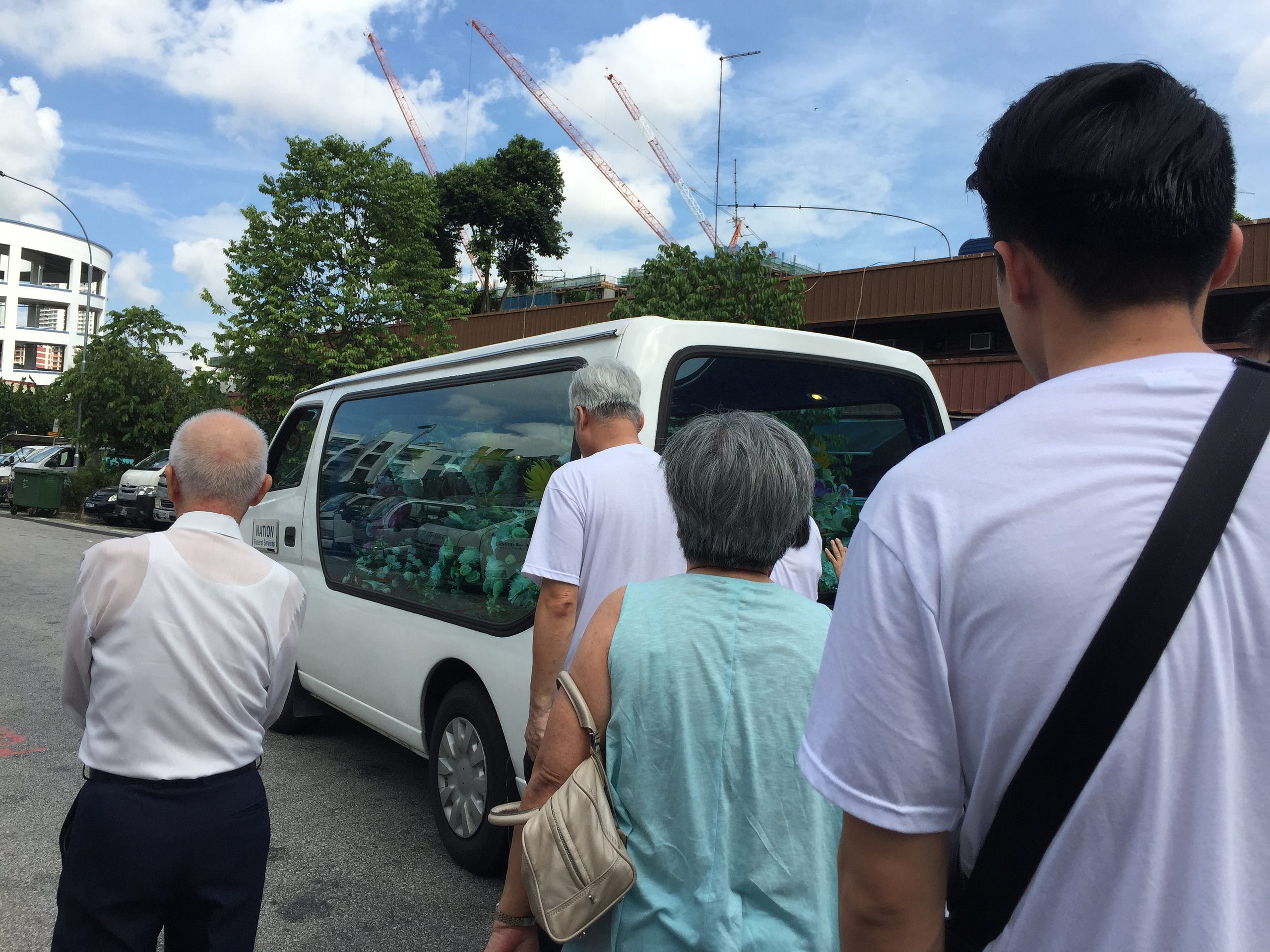 Going to the mountain.
Going to the mountain.
In all of my 29 years, my grandparents had been such a big part of my life that I could have never conceived of a life without them. Like the 1128-episode TV serials they watched, Ah Gong and Ah Ma just went on and on.
In the background, their voices blended in with the voices of the Chinese TV stars I loved in the 1980s. In our tiny little flat where my parents, grandparents, brother and I lived, my grandparents and I drank tea, ate porridge, watched bad TV and forged a home together on stuffy Singapore afternoons so humid that the air wore thin. My parents were young parents; their parents even younger. My grandmother became a grandmother at the age of 44. She was also my defender, provider of tasty hot drinks, and full-time worrier: the act of not eating rice, at any time (even after lunch), was grounds to bring on DEFCON 1. No possibility of relenting until I had eaten another bowl of rice. This would repeat every hour.
I was the weird, silent, brooding grandchild, who said little and spent more time in my head than on the playground.
"I love you, ah girl," she said. "You are my little mouse. So soft, so quiet. I never know what's in that head."
What was in my head was any of the following things:
"I'm going to live in a hut on a farm and make cheese, Ah Ma!" (Much further than going to the moon, for a kid from a country with nowhere to go but the sea and large buildings)
"That sounds fun. Will you make me some?" Ah Ma smiled. She smiled kindly all the time, at everyone, but especially to her grandchildren.
"When I grow up I'm going to travel the world, Ah Ma!"
"That's nice, the world has many people for you to help."
She indulged my fantasies, and believed I could and would do all the things I said I would.
Everything my brother and I did, no matter how small or mundane, made her wide-eyed in wonder.
"Wow! You took a bus home successfully without getting kidnapped! Good job!"
"Wow! You managed to cook instant noodles without causing a fire! Amazing!"
"Wow! The both of you managed to go a week without arguing! Great job, kids!"
If you have kids, I hope you believe unconditionally in everything that they dream of. We do too little of that in spite of our modern accomplishments.
There are certain places where life seems to go on in the way one's forefathers have always lived. Singapore of the '80s was not one of them. My grandparents held different paperwork and nationalities in their lifetimes. My grandfather was a Chinese subject in Sun Yat-Sen's Republic, an illegal immigrant to then-Malaya where he may or may not have been a British subject. He was then, in the 1940s, a Japanese subject in occupied Malaya. With every decade he seemed to switch papers, though not by choice. In the late 1950s, a citizen of newly formed Malaysia, before finally arriving at the citizenship he would take to the grave: a Singaporean, finally, in 1965, at the dawn of the country's birth. Even as a child, I had a vague notion of this: the distance between my parents' lives and mine, was nothing compared to the one between theirs and their parents'.
My grandparents' world was, and still is, a black hole to me. Ah Gong did not like talking about his childhood in China: he did not appear to like it much. Ah Ma did not talk about her younger days in Malaya much; she did not appear to know that modern Singapore and Malaysia are now different countries. To her, home was Clementi, in the western parts of Singapore. Then there was her old home-in Johor, in another country. She just somehow needed a passport now to see her family. Theirs was a life of the tragedies of war, the chaos of a great fire, the unending struggle with poverty. The fear of unknown elements hiding out in dark corners: Ah Gong was attacked on the head with a cleaver once. He survived and did not seem to think much of it, for he never spoke of it. Their world was foreign to me.
To all who came to see me at the home I shared with my grandparents well into my early 20s, my grandparents were a constant presence. No one understood a word of what they were saying. They spoke a specific strain of Teochew with a perfect high pitch, in tones so song-like they seemed to have never left Swatow. If you had come to my house to work on a school project or to eat a meal, you would have only known of my Ah Ma as the kindly lady with a glint of generosity in her eyes, who often chattered at you in a language you had never heard.
I would have translated, "she asks if you would like Milo or coffee? If you'd like to have porridge? What about pork ribs? Noodles?"
It was as though I shared a secret language with my grandparents, the language of Chinese elves (so high-pitched, so strange, so song-like, most of my friends would say I sound like a fairy whenever I spoke to her). In our world, the one I inhabited whenever I spoke this language of elves and fairies with her, it was a world of love, kindness and happiness. I cannot be angry or upset at someone in Teochew, because the only people who spoke it to me taught me only the words of love.
Two weeks ago, my beloved Ah Ma left us after a long battle with dementia in which she degenerated and atrophied tremendously.
When I first learned of the concept of death as a child, I interviewed my family members about their thoughts on death. To my horror, Ah Gong said he hoped, wished, desperately, that Ah Ma would die first.
"How can you be so mean?" I poked his singlet-covered beer belly, before running into my room to cry secretly. The idea of my grandmother dying, even at 5 years old, even as a passing remark, was too much for me to bear. To me, grandma and grandpa just went on and on. They woke up every morning at the same time. They walked for the same amount of time at the same place every morning. They ordered the same food after the same walk. They took the same route home. They peppered their lives of sameness with jokes and tenderness.
When I stood in front of her coffin two weeks ago to say a few words about her, I, of course, broke down. Ah Gong, who once said he hoped she died before he did, had in fact been astute and well-prepared. She slipped away, never to return, after he died a few years ago. He made sure to prepare her funeral portrait, as one of the last things he would do for her.
My grandmother had few friends, I recalled, but she had a world of fans. People came from Malaysia to tell us how she had, as a teenager, refused to let her nephews and nieces go homeless. Despite having not very much, she found them a home. My dad spoke of how, as a child with her as a mother, he was acutely aware of how poor they were. Yet she would make it a point to feed the neighbours' 11 children because their mother had eloped and left home. She had a kind word for everybody, and kinder acts for anyone who needed it.
After gathering myself, I managed to squeak out a few things about her.
I used to be ashamed of my full name, I said. My grandparents gave it to me. It's the sort of name that's so full-on Teochew, so obviously old school, that once you saw it you would immediately know where my family came from.
You're a Teochew girl, aren't you. You sound like you never left the homeland-every time you ask me for fried shallots, I wonder why a little girl like you talks in such a funny, old school way.
That made me hate my name and my accent, but I no longer do.
I did not know my grandparents' names for most of my childhood, I said. I honestly thought their names were Tan Ah Gong and Tan Ah Ma.
Many of my peers in Singapore can barely communicate with their grandparents: the Speak Mandarin campaign coupled with the English-first policy made sure to eradicate any ability to speak the Chinese dialects. I was lucky to have had a window into the world, into my past, through the both of them.
I don't even need a map to know that Swatow's cemetaries were probably on mountains or hills. The language gives it away. The act of taking the body to its final resting place, be it a crematorium or a burial site, is known as chuk sua. Going to the mountain.
So to the mountain, we went. You're supposed to follow the hearse, dressed in white and black, and you're supposed to beat your chest and cry and weep loudly all the way to the mountain. But in super urban Singapore, all that we could do was to follow her for 50 metres to the edge of the carpark, before hopping into a bus to the crematorium.
After the fire.
When Ah Ma was 26 years old, there was a Great Fire near the house. She, along with tens of thousands of people, would run from their homes in search of safety on a hot, infernal afternoon. Ah Gong came scurrying back to the house from por doi to look for them, panicking when he found nothing but ashes. He thought his young bride unprepared and ill-equipped for the dangers of the world. Yet she had demonstrated uncharacteristic resourcefulness: she had been hiding in a temple with their children for hours, picking that place as it was one of the few landmarks left standing after the fire.
After. All that was left of her was a box of bones and ash. We took turns moving her bone fragments into an urn. Parts of her bone fragments had the pigmentation of the various medicines administered to her late in life; they were frail and brittle, just as she had been.
We put her on her shelf. We stared helplessly at her marble engraving. We vacillated between the loving, silly moments with our adorable nieces, and the hopeless sadness that filled us.
My grandma lived 80 years of her life in poverty and in fear. Her hope and her love overcame all of it. All I can hope for is for all of us who have received her unconditional love to carry her with us in the rest of our lives.
That our hearts are large enough to carry the world, because she showed us how.
April 10, 2013
In several status updates
Admittedly I have posted very little on the everyday occurrences in my travel. Here are some snippets, culled from Facebook.
Day 1: Two sleep-deprived people board a plane full of evangelical missionaries offering ‘free healing' in the plane (true story), dinner in the streets and accidental romantic date at a blacksmith-themed cocktail bar with a toilet that was so awesomely creepy it freaked out the one half of us that actually writes horror fiction as a profession. Shai halip in Little Arabia, 24-hour tacos and the latest episode of Scandal.
Street vendors selling holographic pictures of puppies, kittens, Jesus and Mary, naked women and ferocious tigers, across from a fake Viagra/Cialis/ made-in-China sex toy shops.
Bangkok is my happy place. Tomorrow: at least two massages.
Day 2: In no particular order: grilled chicken hearts, the breakfast of champions; flashing at passengers on the Khlong San Saeb river taxi each time (not me, btw), having random thai men cat-calling us coz Sam is in a very sessy dress (they called us ‘black and white girls'. Um. Brown and yellow is more accurate); beef boat noodle carnage, talking security guards into letting us trespass private property so we can take a shortcut, Gibson-esque massive overhead bridges, stalker pandas and mushrooms, great crackling massages, pork cracklings;
Pork satay, dogs and teddy bears and dogs in frilly clothes; hanging out with exes, discussing whether one's Portuguese ancestry is to blame for epic marine vessel conquering flag-planting fantasies (no: it's just Sam); ominous Elliott Smith songs in hotel toilets, streetside mobile bars. Pork tacos in the fridge.
A swim is on the menu tomorrow. Pandas are everywhere.
Off my rockers/tits high on chilli padi. It was a beautiful yum poo dong – raw blue swimmer crab salad smothered in beautiful chilli – the cold raw crab tastes like crab ice cream. But so off my rockers chilli high coz I am so clever I ordered it extra extra spicy. I love chilli padi highs. So beautiful, this world
Day 3: Looking for soi Polo chicken and seeing random chickens and people wearing I ♥ Chicken T-shirts everywhere (surreal), having a crab-gasm over the raw blue swimmer crab in a yum poo dong, coffee in random little sheds in Lumpini, more great massages, Phra Athit jazz and beer and evil plotting, a knock-out pad thai.
Home tomorrow!
Sam and I are at a girlie bar on Nana, showing bar girls pictures of fried crickets. We are looking for the Nana Cricket & Grasshopper street vendor. I don't know how to say "where are the edible crickets" in Thai. Yet.
Apparently I accidentally cock-blocked an Italian dude at a bar in Bangkok. All I did was drink whisky and talk about apps and their project timelines. A thai MILF then decided to tell me she thinks I must be gay, and proceeded to tell me she used to be butch with many girlfriends until a guy drugged and raped her and she got pregnant. (all this happened in thai)
The Italian dude left, very sadly.
Must. Stop. Accidentally. Fang dian-ing at people. Even sideways in my peripheral vision while eating potato chips and drinking whisky.
Note: 'fang dian' = a Mandarin term made up by some friends, meaning ‘to put electricity'. It refers to my track record of accidentally attracting unwanted attention through what they suspect is the sheer Cyclops-like, err, traits in my… eyes.
Day 4: jok moo! Pork porridge with salted egg, century egg, innards! Flip-flops and Hello Kitty (don't ask) and cable shopping! Skyfall! Prawn bisque! Accidentally fang-dian-ing: me at people, Sam at buildings! Giant sea creatures! Girlie bars! Mobile bars! No crickets!
New Bangkok Notes
- I still love Bangkok as much now, as I did when I first started frequenting it… circa 2004?
- Oh gawd I feel old these days.
- That's directly related to how all I want to do these day is have massages. My back creaks; my body creaks along with it. My new go-to place for a massage is at Ruen Nad massage studio on 42 Convent Road, off Silom. It really is one of the best massages you can have for that little money (1 hour goes for 350 THB). It's a little pricier than the less fancy places but the masseuses are uniformly great, and the ambience — in a restored old house in a fancy part of Bangkok — is really unbeatable. Also, Convent Road has some of the best street food in that city.
- The row of street stalls next to Sala Daeng BTS station still has a curious mix of gay p0rn and pirated DVDs. The latter tend to be arthouse (non-p0rnographic) movies, including a great many films which are simply just not available online… or in your local video store. The range of movies is quite breathtaking. I love Silom.
- If you are ever in Bangkok, do yourself a favour and eat a meal — go for the degustation — at Bo.lan. Chefs Bo and Dylan create exquisite food — slow food — and are rather experimental whilst strongly grounded in the traditions. Every meal I have had there, which is still too few, has been revelatory.
- I like the northern neighbourhoods. Victory Monument is home not just to impoverished foreigners/English-teachers, it's also home to Boat Noodle Alley, a massive Gibson-esque skywalk/pedestrian bridge, as well as to Saxophone jazz bar, which is a reliable spot to kick back with a beer and listen to some great music. I also like the neighbourhood of Ari, which has too many pleasures to name.
- If you like jazz with some fairy dust, Iron Fairies is a Dickensian blacksmith workshop restaurant and pub (seriously). It's beautiful. Think Steampunk meets Dickens meets jazz meets industrial chic. There's great live jazz featuring local musicians, some nights. We were there on a Monday and it was going strong. The Thonglor neighbourhood that it's in is also chock-a-block full of great little spots. They tend to tend to lean quite heavily towards ‘hiso' (the Thai equiv of the Singaporean ‘atas', with regards to class).
- Hiso/atas is totally fine by me. I like my upper-middle class hipsterism in strong doses. I also need a bit more down low to counteract too much hipsterism, though, and Thonglor does dish out the down low in appropriate amounts too. soi 38 on the other side of the station is packed with great street food, but one of my favourite meals on this trip was at Jok Moo. Like the name suggests it specializes in pork congee. It was quite a battle ordering two bowls of pork congee in the specific configurations we wanted (salted egg and century eggs, one with innards and one without)… in my limited Thai, but my hunger prevailed and we succeeded. The porridge held its own against some of the best Chinese congees in Singapore/Malaysia. They also seem to have solved the age-old problem of never having hot-enough fritters: they have these little packets of fried fritters resembling you tiao but not really, and they're always cripsy. There is nothing more disgusting than soggy you tiao in your congee, and nothing more wonderful than having congee with fresh, hot fritters as well. It's one of the biggest conundrums I think I face as a Chinese person: would I rather eat soggy fritters or not eat any at all?
- Jok Moo is at the start of Sukh soi 38. Alight at Thonglor station and head for the even-numbered side. Locate soi 38. Jok Moo is the first corner shop on the right at the start of the soi, after some watch or hardware shops. It only has Thai words written on its signage. There's some seating at the back. Have the lemongrass drink. Basic English is understood here. Pointing helps, if all else fails.
- The pad thai at Thipsamai on Mahachai Road really is what it's cracked up to be. A tip: don't order the version with the shrimp oil. I love my calories and I love my oily fried noodles in all shapes and sizes, but the shrimp oil really kicked me in the guts… after. They also have a new dish: pad thai without the noodles. If Mos Burger can do burgers with lettuce instead of buns, I guess Thipsamai can do pad thai without the noodles. Although both food concepts totally go against every fibre of my being.
- The fried chicken at Soi Polo, off Wireless Road near Lumpini. Run, don't walk. Also order the yum poo dong — the cold crab salad that gave me the chilli high described above. Both are beautiful. The Star Trek movie dubbed in Thai, not so much.
- One day I will find the fabled coconut ice cream at Sam Yan.
- Did I do anything other than eat in Bangkok? We watched James Bond. Took photos with giant sea creatures. Introduced Sam to grilled chicken heart breakfasts, and to the river boat experience I love (the commuter Klong San Saeb, not the one on the tourist trail).
- Bangkok is still one of my favourite Asian cities and I don't understand how anybody can ever hate it. Well, I do — it's not for everyone. But if you like hulking, in-your-face Asian metropolises like I do, Bangkok is It.
- One day I will make a concerted effort to get better at my Thai.
May 10, 2012
I'm home now of course, whatever home means, and I've been retelling a couple of stories. The same ones, but many of them, just because I've had such a crazy time in the Nordics.
This one isn't very much of a story. Just a little tale that, once again, shows you how crazy we Asians are about our food.
I spent the first three weeks of my big Scandinavian/Finnish vacation on my own, and/or with friends from that region. In the last week, a friend from uni came to meet me in Copenhagen.
We did stuff, mostly in this order:
Eat. Drink. Eat. Drink. Eat. Cycle. Eat. Drink. Eat. Bring our bicycles to Sweden.
To buy chocolate cake. From a supermarket. She'd been on student exchange in Sweden, now lived in Geneva, and missed Swedish supermarket chocolate cake terribly. I'm sure it's nice and all, but damn if I ever go to another country to buy chocolate cake again.
January 20, 2012
White cabbage is death. If there is a Creator, it is one of his less glorious moments. The only thing worse than white cabbage is white cabbage soup. I am a soup maniac, but white cabbage soup I do not touch with a ten foot pole. I cannot even sit at the same table when it is being drunk. The sight and smell of it makes me want to throw up. Because of these vile leaves, I am unreasonably opposed to all food that is white in colour but is not a carbohydrate or dairy product.
White cabbage soup is Chinese New Year is a vile, hateful thing is I hate the both of them.
For reasons unknown to anyone currently alive, we must drink white cabbage soup at reunion dinner every single Chinese New Year. Without fail. I suppose someone must have liked it once upon a time - perhaps one of my ancestors in China. We have continued this tradition since. And I have started a tradition of setting up another table next to the main table, just so that I can have soup I like. My cousins have joined me. It's the table for young people and for people who don't like cabbage. I have not rested in my crusade against cabbage, and this year I shall continue.
I didn't use to hate it so much. Now, in the run-up to reunion dinner (I have mine tomorrow, one day early), I am fretting about everything and I am happy about nothing. I do not exaggerate when I say the thought of Chinese New Year fills me with such intense hatred, I can almost smell the bak kwa, and hear the loud, extended family I am somehow related to by blood. I find my mind wandering back to the not-so-good old days of a childhood spent reading ten books in a corner every single day of every single Chinese New Year because I was bored to death.
Now, at age 26 and counting, I am still trying to find out what we are celebrating.
Some of you will say, oh, silly person, it's about spending time with your family of course. Sure. When I was living in the Middle East, I looked forward to coming home because I missed my family so much. I love my tiny immediate family. I see them every weekend. It's the extended web of relations, the sort you see only at weddings and funerals, who I don't understand. Why do these strangers give me oranges once a year? Oranges are not the only fruit.
Other than family, if there is a meaning at all to this celebration, I am not able to divine it. If anything, it reminds me excessively of a culture whose values I do not understand.
As you know, I identify not as a Chinese person but as a Teochew-speaking yellow M & M - yellow outside, very, very brown inside. I'm a fake desi in the wrong body, someone who was probably an Indian man in many lifetimes past. The only Chinese thing about me is my love of soup and pork. Other than that, nothing. The festive music bothers me. I am still waiting to hear one, just one, Chinese New Year song that is not about money. The values of this festive music bothers me even more. Why is it that I must either sing about how much money I have, how much I'm looking forward to money this year, how money has suddenly appeared in my life, how money's just… you know, rolling in the deep. /rolls eyes
What about money that you made through sheer hard work? Why won't you sing about it too, bloody dong dong chiang people on the loudspeakers, who have followed me to haunt, tease and kacau me all my life?
Why about money that you made through smart investments? Why won't you sing about prudent financial behaviour and clever business acumen, you stupid gong xi gong xi gong xi people who will one day gong me until I si?
What about family? Love? What about adding in the message, "don't be a douchebag!" in your songs about striking it rich? Or about how happiness doesn't lie at the end of a slot machine, mahjong table or lottery queue?
Then there's the music. And the movies. The Hong Kong or Taiwan or Mainland China variety shows and concerts. It's always the same movies every year. Chinese New Year movies are the worst. Actually if I wasn't such a self-hating Chinese person, I probably wouldn't hate them so much. I don't mind the kungfu. I don't mind the awful, not very clever humour. Somewhere in my brain, multiple negative associations have been made repeatedly ever since I was a little girl: Chinese New Year movies and variety shows are the soundtrack to my many miserable hours sipping ten chrysanthemum tea Tetra-Paks in a row, stuffing my face with too much bak kwa, reading and re-reading every magazine, book and newspaper I have so that I don't have to talk to people, seething in rage that I not only have to be a part of such a superficial culture that judged me first by my grades then by my wallet, but also deigns to tell me I NEED TO GET MARRIED, AND TO A MAN TOO?
No matter how much I hated it, Chinese New Year always had a silver lining. If there was one thing I loved about it, it was to see my grandfather excited, filled with a sense of purpose - he did not cook at all, but he took pride in making his awesome secret chilli, and he also loved to prepare reunion dinner. Ah gong and ah ma worked together as a duo at their finest, waking up at five in the morning so that they can get the best braised duck and whole chicken, roast meat and fish for the family. Next to going for walks in the park together, reunion dinner preparations were when they were the closest.
This will be the third Chinese New Year without him around. Every Chinese New Year without him, without his stupid jokes, without him stringing the grandkids along on some ridiculous, elaborate joke, feels like a joke itself. I keep wishing this was one of those times when he stood outside the house, rang the bell ten times then ran away to hide. I keep wishing this was one of those times when he told me he had gone away on a holiday but hadn't. I bought it a few times when I was a little girl, not knowing he didn't believe in vacations. It's been more than 3 years but the banter-less silence from my grandparents' room still freaks me out. I still miss him everyday. My tears still well up uncontrollably when I think of him. When I see his photo. When I see a video and see him there and hear his voice but cannot reach out across the binaries to hold his hand.
Tomorrow, when I sit down for reunion dinner I will still panic when I don't see him at his usual spot. I know I will wake up on the first day of Chinese New Year and expect to see him in his best set of singlets, shorts and sandals, and be sorely disappointed when I don't.
I hate cabbage soup but it was one of his favourite foods, and I would drink a thousand bowls of cabbage soup if it meant I could see him for just a minute more.
June 26, 2011
The following piece is an original piece written specially for Ceriph #3, published by Math Paper Press. It's on sale at my favourite bookstore, BooksActually, and also at Kinokuniya..
Fish Sauce
We are Teochew, people of the coast.
Fish sauce, more than hot food, opera, more than even yam paste desserts - is what defines us as a people. It is what we live for, what fuels us; there is no life without it. We live for the very hot, and the very salty.
My grandfather was a sturdy, if a little tiny, Teochew man who was much shorter than his wife. Like many patriarchs of his generation, if he even had a name, you would have never known. You simply thought of him as ah gong. On his birthdays when we sang birthday songs to him we did so in Mandarin, Teochew, and then in English. Every time we got to his name we were usually stumped. He did not like us saying his name anyway - it sounded too much like "turtle", he said - so we clapped, said "happy birthday ah gong tee hee hee", laughed at the incongruence, and stuffed our faces with cake.
Ah gong introduced me to fish sauce. He must have. We were close for a Chinese grandparent-grandchild duo of the eighties - we played Chinese chess, and snakes and ladders, in near silence most afternoons - but he was at his most animated when we ate porridge with preserved vegetables and steamed fish. Which was every afternoon.
If you hold your chopsticks that way you are going to move very far from home.
Kopi-C Siew Dai
Utter silence punctuated by occasional outbursts of snark. That hum of snarky silence dominated our lives, or at least mine. On hot Singapore afternoons in our tiny three-room flat, I never noticed the silence. Those damned SBC afternoon dramas masked the silence. The plod of Grandma's food processor distracted me from the silence. The jingle of the Raymond Weil sponsored news programmes were so loud I could not hear the silence. But the snark always jumped straight through the roof.
Next to fish sauce, we liked coffee most. It was any kind of caffeine really, but coffee was king. More than that, it was the promise of a decently made local coffee, the sock kopi, with two fingers' worth with condensed milk and a very loud kopitiam server shouting in Hokkien, that we liked best. Those damned Hokkien people can't talk softly.
We went to the kopitiam together in the mornings, on the mornings when I could wake up anyway. Ah gong liked routine, so much so that I have never seen him in anything other than a singlet and a pair of blue bermudas and brown, serious grandpa sandals. He had a wardrobe full of the same thing for different ages. He could dress you up exactly like him if you asked him to. This routine man's routine began before daybreak at the seaside.
He would walk by the seaside, smirking at the taichi parade, not understanding why anybody would submit themselves to the torture of wearing red shirts with white pants. He would walk by the streamers of the Chinese dance contingent fielded by the neighbourhood's grannies, not understanding why anybody would wave little pieces of cloth around to awful music at 7 in the morning.
He would understand, or at least try to, why the kopitiam could never get his order right ("because Ah Zoh got fired from his job and Ah Orh, who was hired to replace him, is a little slow in the brain"). He could fathom everything he needed to know in a second, but he could never understand why his coffee was never-quite-right everywhere he went.
Lou Swa Ga Hai
When the people of the coast speak of our motherland, we do not say China. We do not say we are zhong guo ren - when we speak of the zhong guo ren we are speaking of those people who look like us but who are really from someplace else. We say we are the people of the Tang Dynasty, we say we are the people from the coast. In our language there is no way of saying we are anything else. Even today we say our "home", this home most of us have never been to, is in the mountain, by the sea.
The zhong guo ren eat rice and vegetables. We eat real porridge, unlike the Cantonese who break their rice grains and pretend to make soup. If a single rice grain breaks we throw all our porridge away, and start again.
There is more water in our porridge than there is grain, but not too much. The grains should clump together, but not too much. The porridge should, like us, be of the mountain and of the sea. A bowl of porridge must physically resemble a mountain in a sea, swa ga hai. Mountain and sea.
If the Cantonese, who believe themselves to be the masters of Chinese cuisine, have perfected the roast, we are the kings of the braise.
A bowl of our porridge might taste of nothing unless you are one of us. If you were one of us, our gaginang, you would know how to eat it - with the amount of fish sauce, with a dozen side dishes. With a salted egg and with a big bowl of braised pork and eggs.
Eating the rest of the meal is simple, anyone can get that.
Every time ah gong ate his Teochew porridge, which was everyday at lunch, he would pour a large amount of braise sauce into his porridge, making it become the colour of dark earth.
Lou, ga swa ka hai. Braise, and seas and mountains, he would say.
Without a comma, and with one small shift in intonation, eating this meal with him everyday was about raising, not braising, seas and mountains each time he spoke at length with me.
Ah gong may have been a man of few words but we drank the sea and ate the mountains together everyday.
Bubble Tea
At the hospital he was in some pain. Not a lot, but you could tell no matter how naturally stoic he tried to remain, he was not going to make it. I had to go to see him from Europe, made it just barely in time, and I like to think he waited for me. Or for something.
In the year since I moved out of the country I had been back only for Chinese New Year, and I had missed his last moments where he had been confined in a wheelchair. He could no longer go on daily walks, nor could he go to the toilet unassisted, but he kept his mind steely by asking everyone endless questions about their lives. He kept his wits about by observing our neighbours and their daily lives from his vantage point, his wheelchair.
The telephone was not made for people like my ah gong. Skype was an invention he could tolerate a little better, and only for the joy of watching someone on the other side of the world appear on the screen. The moment your image was formed he was no longer interested in speaking in sentences to you. That whole year all we ever spoke about was about burqahs and bak chor mee. I was in the Middle East that whole year and he was convinced I led a bak chor mee – less existence inside a burqah. Which was only half true (the pork, not the fashion sense).
For someone like ah gong who led a relatively difficult life and who was not really a part of the modern world with all its trappings and assumptions, he did not get to - nor did he want to - experience anymore than what he already had, which was adoption, migration, war, poverty and distance.
He had few cravings other than for Teochew porridge and preserved olive leaves, steamed fish and fish sauce.
When we were by his side, teary, he could not speak much by that point. He had no teary goodbyes or pent-up messages for anyone. He had no epiphanies but silence.
But he asked for his daughter.
When she, crying as only she could, sidled up to him he gathered his breath and whispered, "Bring me bubble tea. Apparently it's delicious."
We searched everywhere for bubble tea, we really did, but did not search fast enough. He could not wait.
And then Michael Jackson died the next day and the whole world forgot about the man who had never had bubble tea.
Sometimes I wish could have been there when he finally gave up on life and on bubble tea. He would have ranted, in Teochew, that tea isn't meant to be this milky, and what the hell are these bloody balls?
February 10, 2011
One of the projects that's been super fun to work on has been the birth of the Klang Valley's first homemade ice cream outfit, The Last Polka. M and E run the ice cream empire, I help out with the other bits, like the… tasting of the ice cream. And the copywriting.
What started as a crazy idea — bringing ice cream to KL from Singapore, in a bus, because we couldn't get it here — turned into opportunity. "Why don't we just do it ourselves?" I'm quite the pro at eating and at being strongly opinionated about what I put into my mouth, but the girls have much more of a culinary bent than I do. So I stick to writing about it.
Exactly one year on, we've managed to introduce the pleasures of homemade, "artisanal" ice cream to the Klang Valley. From the little home kitchen and tiny machine, to the ramped-up production now underway, the French-style, Asian-inspired gourmet ice cream idea has flourished from the idea it was, to the real brick-and-mortar business it now is. The ice cream now retails at three location: Marmalade at Bangsar Village II, Marmalade at Mont Kiara, and The Bee in Jalan Universiti (Petaling Jaya). The first scoop shop just opened a few days ago at Taylor's Lakeside campus.
The ice cream repertoire has expanded rapidly: we've now introduced Guinness, French Toast, Nutella and Horlicks to the Klang Valley, to great acclaim.
We were asked to collaborate with Time Out KL for a Valentine's Day special — an aphrodisiac flavour. We managed to create two. Until the end of February 2011, the special romantic combo of chocolate chilli and strawberry cream cheese can be had for just RM 45. Since cool indie ice cream kids love cool indie music kids, we're also collaborating with one of our favourite bands, Furniture. Their new album (preview here) "They Made Me Out of Dreams You've Forgotten", can be purchased together with the two tubs of ice cream for just RM 65 in all.
Order at our website (I know, we need a new one — I threw this together very quickly even before ice cream production began, and we've since outgrown it!), and get yourself some love.
November 26, 2009
Some friends from Turkey came to visit this past weekend. I had a great time hanging out with Melissa and Emirhan in Antalya when I stopped by en route to Istanbul (from Damascus), so I naturally returned the favour and put them up at my place. After three dinners (not at the same time, albeit the same night), Emirhan gave up at the sight of three relatively small Asian girls chomping away at their 20th meal of the day and said it must be that we all have two stomachs, the other one being the one that leads straight to refuse.
Kuala Lumpur is a funny place. It contains no immediately obvious tourist attractions (not to me anyway) and the lay of the land is hard to grasp. It’s a sprawling mess of cities, townships, and everything in between; the lack of acceptable public transportation makes it hard to get around. In other words it’s a city not for tourists, but for visitors who have the time and ability to stay, sit around, drink teh tarik, and make new friends.
Unless you’re here to eat and have both the ability and desire to match us locals on our tremendous stamina for eating.
To say “eating” is a national pastime and obsession is not merely stating the obvious, it also woefully understates the true extent of the obsessive nature of this common indulgence which is the mark of a born-and-bred Malaysian (and to an extent, but less so, Singaporean). It is neither a task nor a hobby — it is a way of life. Every aspect connected to the act of eating is performed with loving care and preponderance; the final act of eating is nowhere near a climax, for there is no start, nor finish. Evidence: have an awesome lunch or dinner with a group of Malaysians (or Singaporeans), the ones who are passionate about food (almost everyone is, but there are some who are far long gone). Say nothing. Listen to them speak, and make a mental note of what their conversations are about.
I’d wager that 90% of the conversation is about food. Not about the food they’re eating at that very moment, no, not at all (beyond the expected “this is good”, “this is fucking amazing”, or “this is awful”, which pervades in the first five minutes or so) — it’s more likely to turn into a rare moment of Malaysian/Singaporean introspection and cultural analysis. “This is far better/worse/comparable to/cheaper than/better value for money compared to…”, the connoisseur declares, not with the pomp or authority of a food critic, but with a heart of tender love, “but I’m afraid to say the hawker in (insert any other part of town) is better.” He is bound to be accosted with fierce interjections, because everyone’s a passionate food critic in this part of the world, and sometime cultural and culinary commentator too.
If you’re truly lucky, and understand the local vernacular well enough, you might be witness to a display of shocking real-time food gossip, one that knows neither state nor national boundaries. We all do this to some extent — we know exactly how many of the famous hawkers got started, how their families fell apart from intra-family bickering, how the secret recipe diverged into dozens of different locations and took on their own styles, which one remains true to the original secret, right down to the very last minutiae such as “the chilli in the 4th brother’s version is inferior to the one made by hand daily by his 2nd brother. However the cousin’s newly revised version (open from 10am to 8pm at this other location), is by far the best.”
We even plan our holidays around food. I know my family does, and so do many of my friends. In fact it was no big deal to find that so-and-so’s family had just driven 8 hours northwards to spend a night in northern Malaysia, in order to eat wanton mee at that location, nor was it surprising that they would choose to drive back down not on the expressway, but through the trunk roads that would take them through certain other locations where they could, you guessed it, eat some more (hard-to-find versions of food we love).
From the time I was 15, I developed a strange habit of stealing my passport and bringing it to school with me. I had the good luck to have gone to school in a fine educational establishment. It gave me many wonderful things: it developed my writing abilities, and my school-time activities in those days taught me how to multi-task like crazy and how to play truant, but above all its location on Bukit Timah Road, Singapore, featured one untapped resource — bus 170 to Johor, Malaysia. I hopped on it frequently to lunch (alone, for I was an introvert — and still am) in my school uniform. Then turned back around and went home to a suburban estate in Singapore like it was the most normal thing.
Because it was. At least where I came from.
Moving to Malaysia made this even more unavoidable. I am surrounded 24/7 by fantastic local food, much of it towering heads and shoulders above the Singaporean versions which, despite sharing the same characteristics, are now mostly inedible from a combination of neglect, lack of innovation and tradition (at the same time), rapid development killing our long heritage of ‘street’ food, and other things like that. Say what you will about how the food is better here because it’s ‘unhealthier’ or ‘dirtier’ — I don’t care. (The free use of pork lard is a Malaysian Chinese habit I fully endorse, and begrudge our Singaporean hawkers for not indulging in.) I wake up most mornings in Malaysia thinking about eating noodles. I have travelled far and wide but I care for little in the world (with the sole exception of jamon iberico) than a good bowl of southern Chinese Southeast Asian noodles. bakchormee in Singapore; pork noodles, soup or kon lo in KL. And wanton mee, the northern Malaysian version of which I find far superior by far to our chilli and tomato-addled sickly versions down south. When I am not thinking of noodles, I am thinking of nasi lemak. The very idea of eating noodles and rice for breakfast is alien to many. No scene is more striking than one onboard any airline leaving or entering Malaysia or Singapore on a long-haul flight, when breakfast is served at 5.30am. Stewardesses, onboard Emirates, Malaysian Airlines, or Singapore Airlines flights, come by patting passengers on the shoulder with breakfast options, having to explain the only local option, nasi lemak, to those who don’t know. “Rice steamed in coconut milk… served with chicken curry… fried bits of little fish.. and… a big dollop of spicy sambal.” Of course, all the locals happily tuck into our spicy chicken curry coconut rice at 5.30 in the morning, while most other passengers think us insane.
So while we didn’t have very much time to re-educate Melissa and Emirhan on the wonders of local food, we tried our best. Since there are few pleasures greater than the delights of a superb Ramly burger, the sort that can only be found in Malaysia, we headed straight for one. Followed by satay Kajang. Followed by two rounds of lok-lok. (A lok-lok truck is a contraption of a truck that’s been pimped up to allow for the display and storage of fresh sticks of meat and seafood, to be dipped into communal vats on the rims of these trucks, each filled with boiling hot soup, into which one cooks your sticks of food in a DIY fashion. It went out of fashion (or was outlawed) in Singapore even before I was born, so I eat at one every other day in Malaysia and find great pleasure in it.)
By this time Melissa had already given up on the idea of eating anymore, but Emirhan tried his best. We had one round of lok-lok, rested for beer, and returned an hour later for more.
That’s when I realized how much of a stereotype we had all become. Scurrying to the truck at 2am, we noticed most of the sticks of food had been packed away for the night. Anxious, we all did a spontaneous mini-sprint to the steamboat — separately. In another moment of unplanned synchronized gluttony, we immediately took out our phones from our pocket… and laughed. We knew precisely why the other person was doing it.
We had to check the time the lok-lok truck stopped selling food… because… we just had to.
And then we ate. And ate some more. And went home and planned what to eat in 5 hours’ time.
That’s when I knew I am indeed native to this land. A gluttonous, perpetually hungry native.
June 30, 2009
Last Rites
Living in Singapore is not easy, one can quickly see. Could it be that we tire quickly from our programming — the PSLE, the Os, the As, the university, the serving the nation, the feeding your family and all these things? Or is it that we pack the rush hour morning and evening trains daily, increasingly unable to recognize our neighbours or the languages they speak?
If you thought the living was uneasy, just you wait and see.
Being dead in Singapore doesn’t seem particularly different.
As if being alive and drawing air here didn’t already call for us to live packed closely together in high-rise public housing, since we lack “space” in the corporeal sense, not two hours after you’re gone your family members will be making plans to pack you into spiritual equivalent of the flats you’ve lived in all your life, as I found out last week.
– “Ah Gong will be living in Block 206 ok? Any objections?”
– “What level?”
– “Level 6.” (No lifts or floors with lift landings here, I’m afraid.)
– “Unit 281.”
And on and on it goes, debating the merits and the cons of the block (C, D, or A?), level and unit, direction it faces (“sea- or ‘mountain’- facing?”), until somebody, i.e me, goes, “Explain to me what the difference is between Ah Gong ‘living’ there and in another block, level or unit?”
– “$200. The uncle say ah, if you want to choose the unit, must pay.”
Turns out it wasn’t just $200 that made all the difference. The Chinese/ atheist/ Buddhist/ Taoist dead (categories which tended to overlap with each other) got the lower floor. The Christians — who tended to be Chinese, Indian, and Eurasian — were upstairs. Upstairs seemed to get a bit more air, a bit more sunlight, and didn’t heat up too much at mid-day, unlike at the other blocks I’d been to. Not that it mattered to Ah Gong. Ah Gong survived poverty and hunger in his childhood in China, a cleaver-attack on his head in mid-life, and a smart alec grand-child in his late years… he’d adapt.
– “Sorry, if you want to put him in a Christian block, you need to show a baptism certificate for him or for an immediate family member.” Unbelievable — racial/religious quotas… for the dead? Turns out the Christian lots are in such high demand, like our schools, that everyone, even non-Christians, wanted to be there.
Keeping your urn in a randomly assigned spot: no extra charge
Wanting your urn to be in a specific spot: $200
Pre-booking your urn spot next to your loved one: $1500, depending on religion, site, and race
– “Better not to pre-book lah! Sekali here also kena enbloc then how?”
– “Then die lor. Oh budden die orreadi hor.”
It read like there was a statutory board (with an appropriate death-related acronym) administering this thing.
The funeral director was a man named Fred who, like all and sundry who call our sunny shores ‘home’ these days, was foreign talent. He worked long hours, spoke perfect English, left the Chinese dialects to the middle-aged Chinese men he hired, and unlike these middle-aged Chinese men, seemed to genuinely care.
He, and everyone involved in this, was so efficient that within 3 hours of Ah Gong’s passing at the hospital, he was returned to us at home — embalmed, coffin-ed, dressed, ready to go. Ready to lie down for a few days while people sat around pretending to look at him, eating peanuts, collecting money. Even the cartons of Yeo’s packet drinks, in winter melon, chrysanthemum and lemon barley flavours, had been bought.
Because our estate is currently in the throes of HIP (Home Improvement Programme), having recently undergone HUP (Home Upgrading Programme), there was no space at our void deck for the wake. So at 10 am, all of us lined up at the opposite block, uniformly dressed in our funeral whites. The tentage had been up for hours, the chairs and tables had been put out, as had their corresponding plastic sheets and peanuts.
Some dramatic music sounded from the back of the hearse, out of its improvised 2.1 system (speaker+flower+coffin).
We lined up to welcome Ah Gong home. Except that in this homecoming version, he wasn’t breathing. And he was in a shirt and tie, which convinced me something had REALLY gone wrong this time.
The shit hit the fan several times, but he always came home in his white singlet — the only thing he bothered to wear, in all the 24 years I’ve known him. He only wore a suit once in his life: at his wedding, or rather, when his wedding portrait was taken. Even at my brother’s wedding he compromised only slightly by wearing some kind of short-sleeved shirt over his singlet (unbuttoned so his Flying Goose brand singlet was unmistakable). I never thought I’d see him in a tie.
I never thought I’d see him dead.
I never thought that behind the white tents of the void deck, the ones I’ve walked past often in all my years living in a HDB flat, would lie someone I knew, someone I loved.
I never thought I’d be, three days later after the fact, walking glumly and sullenly through the carpark not because I hadn’t done my homework and didn’t want to go to school, but because my uncle was carrying a large photo of the man I’ve come home (and left home) greeting every single day of my life: ah gong ah ma wa tyng lai leoh! That we’d walk lock-step to the hearse, that I would find myself making a mental note to remember to tell my children to pick a non-peak hour when I “chuk sua” — the impatient Singaporean drivers would really annoy me even when I’m dead, honking the way they do in trying to overtake a coffin while people are crying behind it.
It only seemed right to share with the world what the recently deceased were known for. In writing his eulogy, I hopped about with a notepad and a pen tucked above my ear, asking all my cousins: “what did Ah Gong always say to you?”
Da Jie said, “si sua ta!” (“Anyhow say!”)
Er jie said, “sark suk!” (“Silly!”)
My brother, his favourite grand-child, said, “Dua cha.” (“Big blockhead”.. which was his nickname)
To my other cousins who spoke Mandarin instead of Teochew, he took great pains to translate his terms of affection. “Ben ben!” (“Stupid stupid!” in Mandarin) “You mei you mai liu lian?” (“Did you buy durian?”)
So I wrote him a eulogy and I got to say si sua ta, sark suk, dua cha and liu lian all at the same time.
I stood before the crowd and I introduced myself. I cried instantly.
I tried to say my Teochew name for the first time in my life (vastly different from my English name and my Mandarin name), but I could not: Ah Gong had sabo-ed me, again! The only time I ever heard my name being said in Teochew was when he talked about having named me. He always said it in a way which rhymed with the hour. jit tiang, nor tiang, sa tiang! So I stood there and introduced myself as li- ‘hour’. People in the audience laughed loudly and my uncle, who reminds me most of Ah Gong, called out: and your name is also two o’clock and three o’clock! And si- tiang too!
Ah Gong, ni you pian wo! His eulogy was delivered, not entirely flawlessly, in Teochew by me and in English by my brother. I wrote an essay in Teochew called “Torchlights and Alarm Clocks”. I talked about how it’s going to be weird not having him tie pink ribbons to my backpacks so I can see them come out of the baggage carousel, how he’d write my Chinese name on everything I owned, even the cool ones; my brother and I both said growing up with him was about having a torchlight shone on your face at 3 am every night, just so he knew we were there. I cried a lot. I laughed a lot. He was a silly, funny man and he made us all laugh. We said in heaven he’s cursing all day on sweet potatoes (his only bad words were Teochew vulgarities about stuffing your mouth with a sweet potato, and something about your mother’s eggs). I think in heaven Ah Gong is back in his singlet, shaking his leg like the China-man he is, with Bruno his favourite dog. And his alarm clocks are going off all at the same time, and his torchlights never need their batteries replaced.
ah gong wa tyng lai, lv zu kee loh.
I never got to say goodbye.
I miss you so damn much.
September 14, 2008
postcard from Banten
I never learn.
If there are two items you must not forget when travelling, they are your universal travel adapter and your watch.
I keep forgetting either one but that is seldom a problem. Forgetting just a travel adapter means you can tell time with the other essential item, the watch; forgetting the watch but having the adapter means you can tell the time with your mobile phone, iPod, or computer.
I had neither this time.
And so it was that I woke up on Thursday morning with a jolt. I had a flight and it was one I could not miss: I had a dinner appointment in another country. Not having a travel adapter meant my phone was dead for days and I therefore couldn’t inform my dinner date of any changes in the plan; the only alternative then was to make it for dinner. Not knowing what time it was I leaped out of a sofa in downtown Jakarta and sped into the bathroom, having stripped fully and redressed entirely in the 5 steps it took to get there, swept all my toiletries off the bathroom counter, administering the contents of these toiletries on my face and mouth before they got into the bag, relieved myself concurrently, and was out of the house (also having checked three times that I didn’t leave any thing behind, which would be disastrous: I don’t have the key into this apartment) exactly four minutes since I woke up with a jolt.
Downstairs at the foyer I cut the line and jumped into a taxi still worried I might miss my flight. It was 11 am.
On checking my flight ticket I realized I was, for the first time, grossly early for a 2.55 pm flight. At least that gave me enough time to get through the predictably unpredictable Jakarta traffic.
By 11.45 am I was at Soekarno-Hatta airport. If you’ve ever been there you know how that airport does not in any way resemble the airport of the capital city of the fourth most populous country in the world. The way it’s built it looks like someone took a bunch of the dullest looking Lego bricks and lined it up in a row. At each break between a set of bricks someone else started labelling them: International, terminal A, B. Domestic, terminal C, D. You can only enter the airport if you have a boarding pass and a passport, everyone else had to clamber up some steps to the Waving Gallery. The only thing you can do at the terminal is check in. The international terminal is too crowded; it makes you sprint from place to place looking for where you’re supposed to be, before going through another hurdle (to pay fiskal, 1 million rupiah for Indonesians, 100 000 rupiah for everyone else), then getting into the grotesquely long passport control lines. The domestic terminal is far more sedate and cuts to the chase. You enter the terminal; look at the screen; the check in rows are 5 feet in front of you. You check in your bags, then walk 100m to pay fiskal (30 000 rupiah, domestic). Then you get on the plane. I have seen airports in small tribal town India that work and look better. Guwahati airport in Assam, for example, is light years more advanced.
But never mind all that because Soekarno-Hatta airport has a Krispy Kreme outlet — outside, as all the shops are.
While attempting to check in early I notice my flight had been delayed to 4.15 pm. I take to delays with a certain degree of nonchalance that only experience with budget airlines and Indian trains can afford. I sit at a restaurant eating overpriced soto babat, and only because A&W Indonesia doesn’t have curly fries, and talk to strangers. One man sitting next to me with an Eee PC tells me he is Vietnamese American and is travelling the world; he’d quit his job, but as a world class backgammon player… plays backgammon online and makes more money from that than some investment bankers I know. We both have not showered in many hours and as solo travellers, need each other: to watch our things when we go to the toilet to wash our faces.
When it was time to check in for my flight at the new timing, I roll my trolley all the way back to the domestic terminal. The screen has been saying “retimed: 4.15 pm” all this while. Announcements are impossible to hear in this airport, if they exist at all. While trying to check in I find out my flight… berangkat! Departed. At the old time. It wasn’t delayed after all. Although the screen still said my flight is leaving at 4.15 pm.
So I’d missed it and was put on the next flight to my destination… at 6.40 am the next morning. I was running out of Indonesian currency, and money changers don’t really exist in this airport (or they do, but in the most inconvenient place possible — at a location which necessitated me taking a shuttle bus there); I was getting cranky. I decided to stay in the village nearest to the airport rather than brave traffic back into Jakarta, preferring village life to hanging out at Soekarno-Hatta even though I knew my new friend the backgammon champion was going to be playing backgammon online at the airport until 10 am the next day. Every minute there was depressing.
Someone booked me a decent hotel in that village, and they also came to pick me up. When I arrived in Banten I felt nothing. No panic, no horror, just one question: what am I going to do until 4.30 am tomorrow? (Remember, not having travel adapter = no laptop and mobile phone.)
The hotel was decent enough. I’m used to hotels of all stripes. My accommodation preferences sway two ways: either extreme luxury of the private retreat sort, or bottom of the barrel. I mostly dislike everything in-between and would rather stay at a place scraping the bottom of a barrel than yet another soulless hotel. The bottom of the Banten barrel, this Sri Permata place, wasn’t too bad. I mean, I have stayed in leprosy mission guesthouses in Bangladesh, longhouses hours away from cellular coverage in Borneo, and box-sized rooms in Calcutta. And enjoyed them all.
It’s the sort of place where everything on TV is in a language you don’t understand.
In my case, everything on TV was in a language I understood in fits and starts. My grasp of Malay/Indonesian is shaky, not having done it in school, and with the sentence structures of a two year old and the vocabulary of a three year old, it’s frustrating to understand bits and nothing else. Though my dedicated efforts in reading signboards in Malaysia mean my abilities in this language are slowly improving (Me: “What’s_faedah_?!”, on an insurance signboard. Her: “Say it again! Hahaha!” Me: “Frown!”) it still counts for nothing. If anything at all I feel like an idiot. Watching TV affirmed this. I understood one in ten words.
So an Indonesian comedy program, which I’m sure was very funny to the native audience, sounded to me like this:
“Where!”
“Here!”
“There!”
“Who!”
“Mosquito”
(Audience: “Hahahaha!”)
Me: “There are many mosquitoes in this room alright.” (in my head, and in English /switches off TV) Though to my credit, I did understand that they’d written in a product placement for Hak Hak Bento prawn tempura: they’d erected an entire shopfront on the set and were discussing how delicious prawn tempura was. Not entirely useful linguistic skills, then.
By which time it was 5.50pm and every channel on TV was a call to prayer for buka puasa(break fast). I wandered out into the village in search of food.
Since I had 11 hours to kill in this place I picked a warung at the brightest spot in town — Cafe Rindu, right outside Indomaret, Indonesia’s answer to 7-Eleven. In a town like this, 24h convenience stores did not exist. They closed at 10pm. I had 4 hours to go in the bright lights of this warung.
Reading Indonesian menus are never too harrowing. Being from where I am I understand 98% of menus in Indonesia and have probably eaten most of it. It seemed like a day for_roti panggang_ (toast), but so many options! Coklat! Keju! Strawberry! Selai kacang! It didn’t seem like a night for chocolate, cheese or strawberry. But just what was the last option?
I puff up my chest slightly and furrow my brow.
“Kak. Errrr… selai kacang. Ini apa?”
If anyone ever asked me that in English I would react the same way 18 year old Yati did. Stumble, laugh, giggle, and not know what to say.
“Peanut butter. This what?” What is the world? Why is the sky blue? Why does my Indonesian suck? Why am I so hungry? What is life? Why are we here? How does one answer that?
Yati pondered the deepest existential question posed to anyone since The Answer is 42. What is peanut butter, indeed?
She made me some, and I understood. I understood the secrets of the world, and why we are here. To eat peanut butter toast at a warung in a random, faceless small town in Java. To do all that while attempting to talk to people in a language I don’t entirely understand or speak.
When it was all over she asked me to be her friend. In Indonesian, of course. (“What? Huh? What did you say? Speak slowly? I is from Singapur. me speak Bahasa Indonesia a little bit a little bit.”)
I wanted to ask her to leave me her address so I could send her a postcard.
“Please give me your maklumat.”
Blank stare.
(Maklumat = information)
“Sorry, please give me your alumat.”
Another blank stare and a giggle. I vow to stop trying to speak Indonesian if I get it wrong again.
(Alumat = doesn’t mean anything)
“PLEASE GIVE ME YOUR ALAMAT.”
Yati clapped her hands, giggled, actually shrieked and did a little jiggle. And wrote excitedly on my writing pad. In English. Name = Yati. Age = 18. Address = xxxxx, Banten, Indonesia.
I’m not used to girls behaving like that towards me at all, certainly not used to tudung-wearing girls in Java (or anywhere else) being so excited about me.
I wish I could tell her peanut butter is the world, but knowing my shit Indonesian it would probably come out as “in the world, peanut butter is”. Or “peanut butter, in the world”.
It was time to leave. And I had her alamat, and all the maklumat I needed. Now to tidur, and balik ke Singapur. Langsung!
A few Malay/Indonesian language elves died in the process of writing this entry.
(Incidentally, for years my mother thought I was dating a Javanese girl named Yati. And chose to call her Yeti. How that’s anywhere close to Z’s real name is a mystery to all of us. My mother was also fond of boasting to her friends that Yeti was the colour of _kopi susu_and like hitam manis — milk coffee, and black and sweet, which I guess ties into the whole abominable snowman idea — so I guess irrelevant Indonesian skills are something I inherited.)
January 2, 2007
Reposting stuff from the past. This one's from 2007.
I’m a horrendously bad sightseer and tourist, that much is true. You have no idea how bad I am. I almost never manage to visit any of the attractions of the city — unless they’re glaringly obvious and utterly compelling, like, say, the Taj Mahal — other than that, I really should take a keener interest in museums and palaces and memorials. Somehow the idea of traipsing along with my nose in the Lonely Planet, paying a camera fee for each of my cameras and an inflated foreigner’s admission fee, visiting places where my pictures will inevitably turn out with the ubiquitous Korean or Japanese or American tourist with a sun hat and sunburnt skin in the corner, doesn’t cut it for me anymore. At home my idea of torture was to be taken to Sentosa or the bird park, so why should it be any different abroad?
Before I’m flayed alive, in my defence I have a convincing excuse: I know exactly why I travel. It’s not to have the best shopping deals in the developing world, neither is it to rough it out or live it up in the cheapest manner possible. All of those are byproducts of my greater task — to eat.
I love food with an extraordinary passion only an Asian can understand. You’d expect it to be so if my entire life revolves around it: have you eaten? is an acceptable, indeed the predominant method of greeting. It doesn’t matter if you’ve truly eaten. Just bloody say you have. After all, nobody ever says, “oh, terrible”, in response to “how’s it going?” As a family, in our personal capacities and in all of our social settings, the extent to which we’d go for a good meal is mind boggling to the uninitiated. Think of me — and my family — as an extreme version of Asians who love to eat; it’s not just the good meal we’re after these days, it’s the mind blowing meal that drives us further and further in search of it. All those stories you hear about crossing the Causeway to eat a specific dish for lunch, and flying around Asia to satisfy a craving for roast meats or herbal soups? They were probably talking about us! My English friends were shocked to hear about that. To their mind, it was as unfathomable for someone to be so obsessed with eating, as it was for that person to remain skinny, as it was for there to be more than one such person, or to even have a family full of such people. They couldn’t even fathom the idea of going to France for a good meal over a weekend. Now, if France was as close to me as it is to England — I’d be there to eat up a storm by now!
Backpacking brings out the best and worst of national stereotypes. We inevitably end up banding with the Australians or Dutch or British or Canadian backpackers we meet along the way, and fall into that “doing stuff together” routine. I’d participate intently, in all the most important initiations this temporary alliance brings — especially in that inescapable discussion always taking place five minutes after meeting each other, the one about our bowel activities (“So I got diarrhea in Benares! It was really bad, out flat you know, 7 days.” “You were lucky 7 days was all you got. When I was in Dharamsala..”). Yet when it comes to sightseeing, I’m out of the picture. Minor temple? Palace? Sorry man I’ll see you later — I’ll be at a restaurant. In fact I’ll be at five restaurants today for pre-lunch, lunch, post-lunch, and tea. And I’m not exaggerating. My itinerary is vastly different, yet you can’t call it inferior. It depends on what you’re after, I suppose. I’m after a good meal, or two, or three or four, as I am with every meal I eat back home.
Abroad, my sense of purpose becomes amplified; you could think of me as a younger, poorer, less famous, Asian version of Anthony Bourdain on a Cook’s Tour. My segment would be called A Hungry Asian Woman’s Tour (notice the clever and subtle turn away from “cook”). Aided by spectacular research and some insider information, nothing can faze me. I have had life-changing experiences eating at culinary institutions of each city, such as Bangalore’s Mavalli Tiffin Room. I have traversed the lengths and widths of Thailand and Laos in search of the somtam (papaya salad) fiery enough to put a fire on my tongue and to turn me purple. I’ve developed an unfortunate omnipotent immunity to spice, such that I barely feel a chilli buzz anymore, and that depresses me. Like an addict with eyes glazed over, I’m indignant to find my chilli high. All the food in India and Bangladesh was not spicy enough either. Time after time locals advised, challenged, and urged: what you are about to eat is deadly spicy. I eat. They watch for a reaction. There’s none, just disappointment on my part that if Indian food is not spicy these days, and that I’m blasé about a supposedly terrible tomyam or somtam which has driven my Thai and non-Thai companions to the point of almost pointing fire extinguishers into their mouths, maybe I’ll never find food spicy enough for me.
After a certain amount of travelling in a certain area, you can’t help but feel fatigued by a certain sort of attraction a region has an abundance of. In Southeast Asia, it was wat-fatigue. In Europe, it was cathedral-fatigue. In Darjeeling and other Nepalese/Tibetan areas, I was ghompa-ed over. In Rajasthan, it was forts. Straight off the bus in Jodhpur, when the rickshaw-wallahs tripped over themselves thinking they could rip us off on a round trip to the fort, I turned it down flat. “No fort. You go Sardar Bazaar. Drop me East Gate. I go Shree Mishrilal. Drink best lassi in the world, accha baba!” I stayed in Jodhpur for 3 days, and made 6 stops at the lassi shop. We drank perhaps 5 servings of Mishrilal’s lassi each day, and brought 2 more back to the hotel. Then walked out of the bazaar to Shahi Samosas, best in Rajasthan, 4 rupees (S$0.14) for one, and before they were consumed we’d hail another rickshaw-wallah. “High Court Road, Paraswanath Khulfi”, for the most amazing khulfi (ice cream) you can have for 20 rupees. We never made it to the fort, but we certainly ate a lot.
It’s not all gluttony, but a firm belief that if you want to know Asia — know what Asia eats. Best if dietary restrictions can be put aside temporarily, because to be vegetarian in Southeast Asia is pure torture. Eat everything once, and forget about your developed world idea of hygiene. Sit out by the streets, and bloody eat. See if you don’t have an epiphany. If I get diarrhea, I first think: was it from a good meal, or from a crap one? If it was good, I would probably excuse the cook for the murder of my loved one, and diarrhea’s just the unfortunate side effect so will you give me one more plate, please. So at soi Texas, Yaowarat (Bangkok), we found Lek Seafood in 1 minute, consulted the menu and decided on items for 4 people within 10 minutes, the food came in 3 minutes and we fell silent, deliberating upon the most fantastic crabs, mussels and prawns that S$6 per person can buy. The food was gone in 10 minutes, in the most silent meal ever, as each person had a quiet revelation about why we were there. In Luang Prabang we eschewed the mediocre restaurants on the main strip (where each item in every restaurant was at least US$5), tired of the renditions of Western food and mediocre versions of local food costing an arm and a leg. Stumbling into an alleyway for US$0.50 per person you can have a vegetarian all-you-can-eat buffet plate in a corner shack; forging on, since vegetarian does not cut it for me, we settled on excellent feu ga (pho ga, chicken noodle soup). We doused it in fish sauce, decorated it with lime and small cut chillis, bought a whole fish and chicken from the shop next door, a big bottle of Beer Lao, and what an inspiring meal it made — sweating in a little noodle soup stall in a local market in 16 degree Luang Prabang.
Food Street (Bangalore), Lindsay Street (Kolkata), Ari (Bangkok), Petaling Jaya (Malaysia); the places I ate the best are the places I was happiest in. In a tiny shop in dusty Syedpur, Bangladesh, nobody spoke a word of English and I didn’t know what I was eating. But boy, the “cow”, “chicken”, “fish” (fascinating, the choice of vocabulary I learn when learning a new language) they fed me turned me into an instant convert in the school of Eating With Only Your Right Hand. In a family’s dining room in Mawmluh village, Cherrapunjee, Meghalaya (Northeast India), a family watched me engrossed in eating rice with fermented bean and beef and stewed pork, eating raw little chillis to go with my food (it’s a custom). Aoky’s mother thought I was so truly into Khasi culture and food that she believed I would have no problem chewing 2 betel nuts too. It was on that part that I faltered, though I’m sure if betel nuts tasted better, I’d be all over them too.
Now I’m hungry again.









































 Going to the mountain.
Going to the mountain.